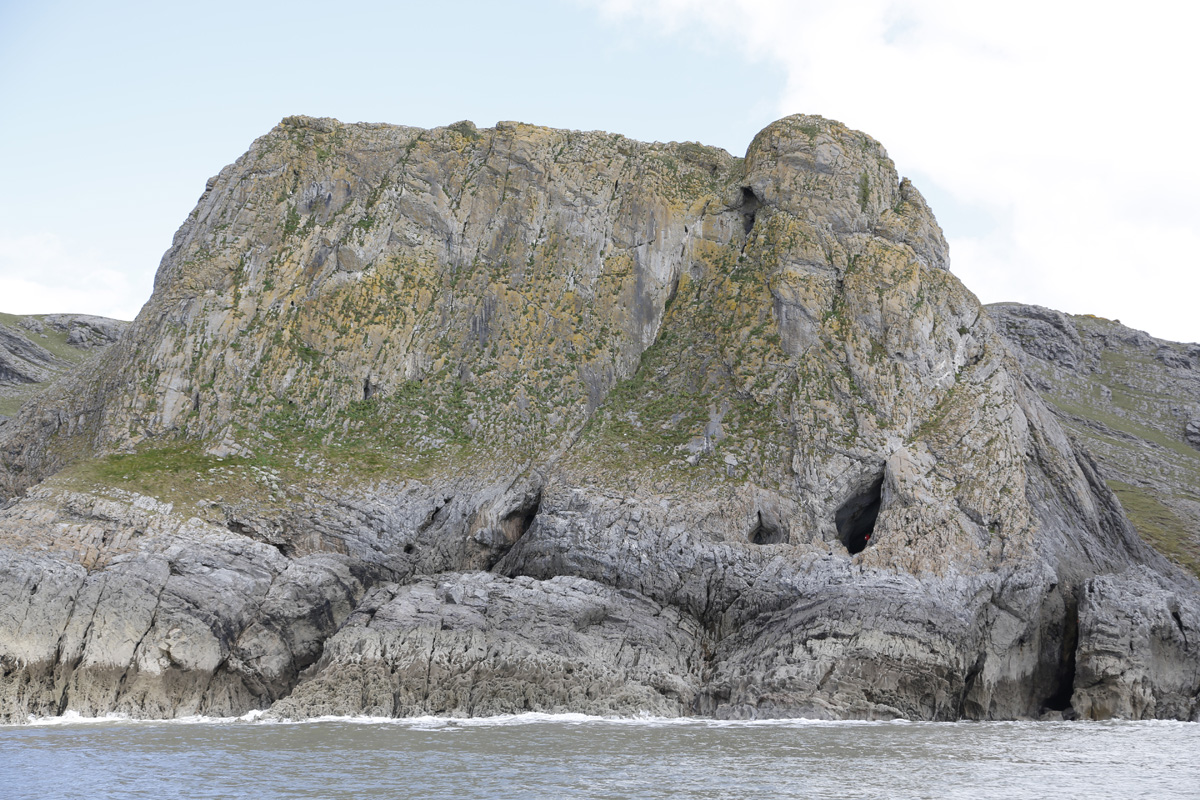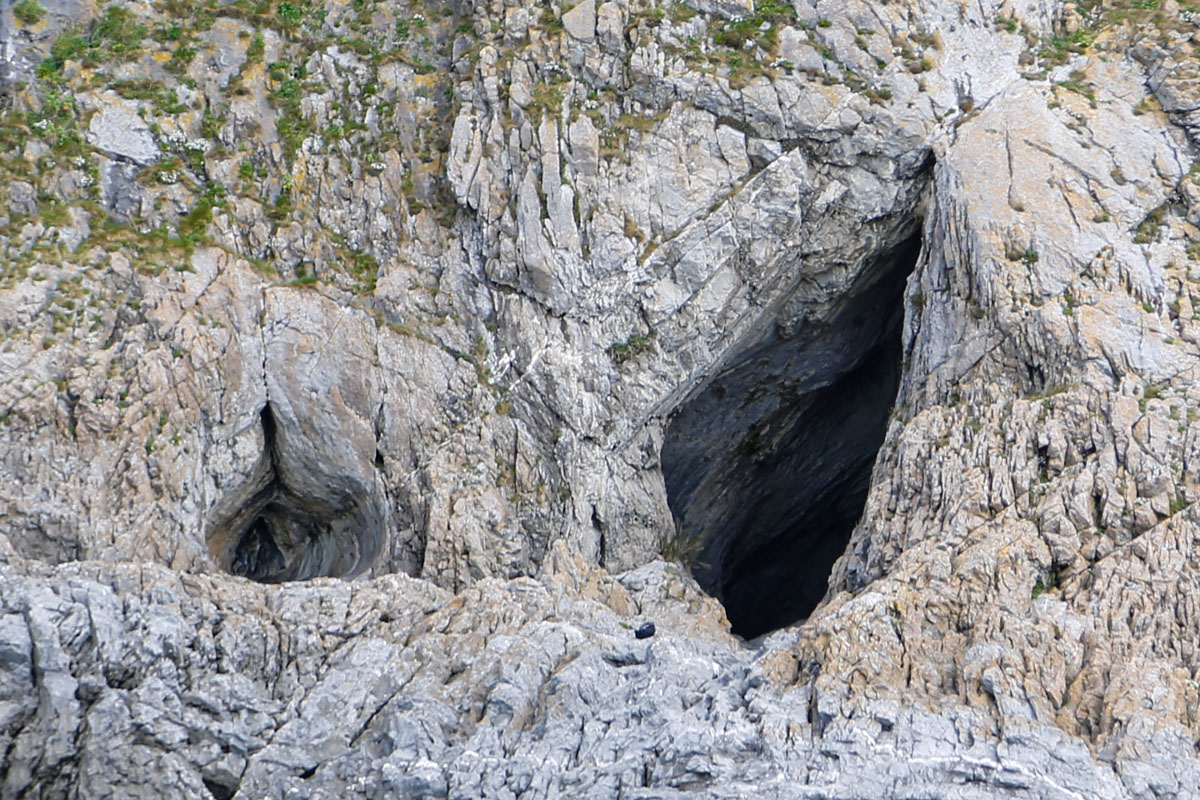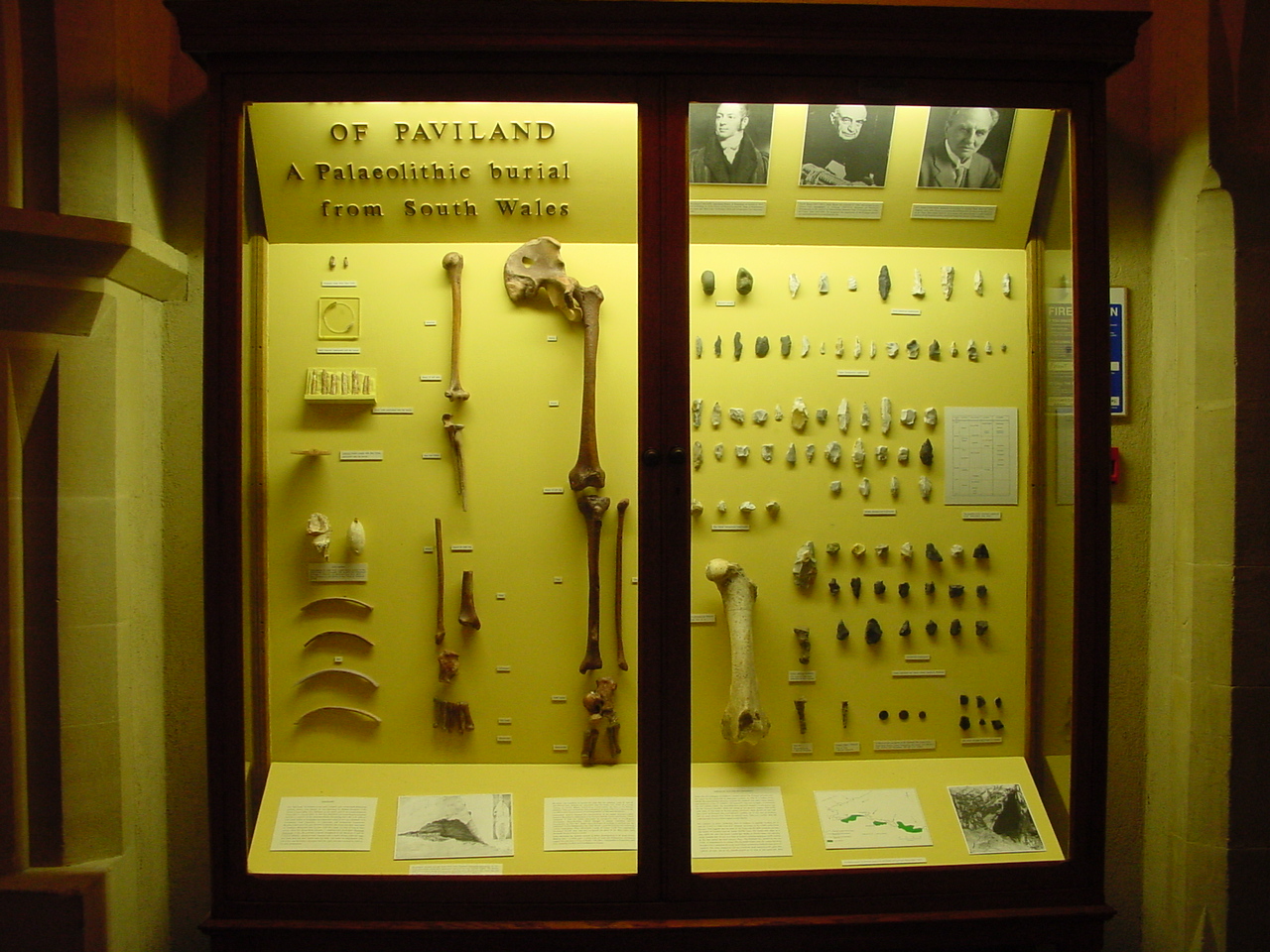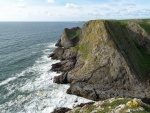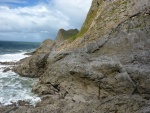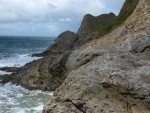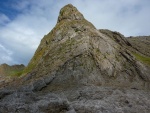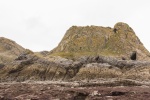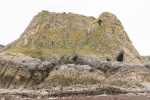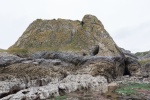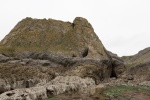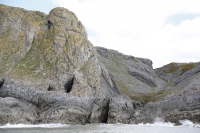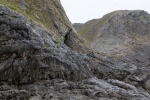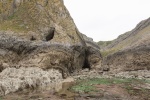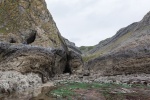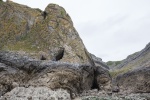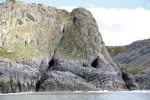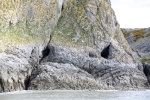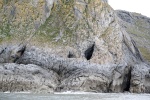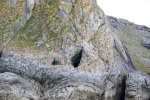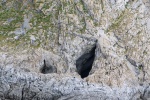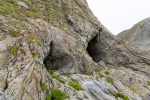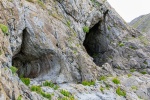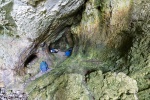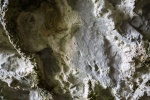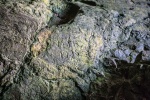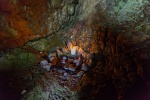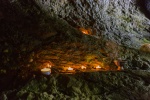Location
- Site Name
- Paviland Cave (Goat's Hole)
- Parish
- Rhossili
- Gower Region
- South-West Gower
- Latitude
- 51.55
- Longitude
- -4.256
- X
- 243714
- Y
- 185881
- Z
- 8.15
- OSNG
- SS 43714 85881
Identification
- Position
- Entrance
- Entrance Height (m)
- 8
- Entrance Width (m)
- 3
- Type of Cave
- Archaeological, Palaeontological
- Access
The cave is only easily accessible at low tide for 6 days in the month. The cave is reached via Foxhole Slade keeping to the east side of the dry stone walling. A rough scramble is required etc etc.
Description
Header
Paviland is perhaps .....Sed ultrices scelerisque enim ut malesuada. Nullam viverra risus eget purus posuere, quis tincidunt sem varius. Nulla luctus posuere congue. Curabitur convallis ut libero quis tincidunt . Nullam sit amet mattis risus. Integer eleifend justo.
Paviland is perhaps .....Mauris, posuere tempus ipsum auctor id. Aenean sit amet turpis non mauris pulvinar lobortis sit amet sit amet lorem . Nunc tristique est at nibh ullamcorper, dignissim varius magna condimentum. Nam fermentum diam velit, sed viverra quam commodo in .
References
{1902014:AA45Z296};{1902014:QAXMFEBQ};{1902014:QW6H2EX6} author asc no 1 1 2180%7B%22status%22%3A%22success%22%2C%22updateneeded%22%3Afalse%2C%22instance%22%3A%22zotpress-c02a0a0010e5384294efda12ca5a1249%22%2C%22meta%22%3A%7B%22request_last%22%3A0%2C%22request_next%22%3A0%2C%22used_cache%22%3Atrue%7D%2C%22data%22%3A%5B%7B%22key%22%3A%22AA45Z296%22%2C%22library%22%3A%7B%22id%22%3A1902014%7D%2C%22meta%22%3A%7B%22creatorSummary%22%3A%22Aldhouse-Green%20and%20Pettitt%22%2C%22parsedDate%22%3A%221998%22%2C%22numChildren%22%3A1%7D%2C%22bib%22%3A%22%3Cdiv%20class%3D%5C%22csl-bib-body%5C%22%20style%3D%5C%22line-height%3A%201.35%3B%20%5C%22%3E%5Cn%20%20%3Cdiv%20class%3D%5C%22csl-entry%5C%22%3EAldhouse-Green%2C%20S.%20and%20Pettitt%2C%20P.%20%281998%29%20%26%23x2018%3BPaviland%20Cave%3A%20contextualizing%20the%20%26%23x2018%3BRed%20Lady%26%23x2019%3B%2C%20%3Ci%3EAntiquity%3C%5C%2Fi%3E%2C%2072%28278%29%2C%20pp.%20756%26%23x2013%3B772.%20Available%20at%3A%20%3Ca%20target%3D%27_blank%27%20href%3D%27http%3A%5C%2F%5C%2Fjournals.cambridge.org%5C%2Faction%5C%2FdisplayAbstract%3FfromPage%3Donline%26aid%3D9435403%26fulltextType%3DRA%26fileId%3DS0003598X00087354%27%3Ehttp%3A%5C%2F%5C%2Fjournals.cambridge.org%5C%2Faction%5C%2FdisplayAbstract%3FfromPage%3Donline%26aid%3D9435403%26fulltextType%3DRA%26fileId%3DS0003598X00087354%3C%5C%2Fa%3E%20%28Accessed%3A%2020%20June%202015%29.%3C%5C%2Fdiv%3E%5Cn%3C%5C%2Fdiv%3E%22%2C%22data%22%3A%7B%22itemType%22%3A%22journalArticle%22%2C%22title%22%3A%22Paviland%20Cave%3A%20contextualizing%20the%20%5Cu2018Red%20Lady%22%2C%22creators%22%3A%5B%7B%22creatorType%22%3A%22author%22%2C%22firstName%22%3A%22Stephen%22%2C%22lastName%22%3A%22Aldhouse-Green%22%7D%2C%7B%22creatorType%22%3A%22author%22%2C%22firstName%22%3A%22Paul%22%2C%22lastName%22%3A%22Pettitt%22%7D%5D%2C%22abstractNote%22%3A%22Paviland%20is%20the%20richest%20Early%20Upper%20Palaeolithic%20site%20in%20the%20British%20Isles%20and%20has%20produced%20Britain%27s%20only%20ceremonial%20burial%20%28the%20%5Cu2018Red%20Lady%5Cu2019%29%20of%20that%20age.%20Excavations%20in%20the%2019th%20and%20early%2020th%20centuries%2C%20combined%20with%20the%20action%20of%20the%20sea%2C%20have%20removed%20virtually%20all%20of%20the%20cave%27s%20sedimentary%20sequence.%20A%20new%2C%20definitive%20study%20of%20the%20site%20and%20its%20finds%2C%20together%20with%20over%2040%20radiocarbon%20dates%2C%20shows%20that%20Paviland%20currently%20holds%20the%20key%20to%20our%20understanding%20of%20the%20chronology%20of%20human%20activity%20and%20settlement%20from%20c.%2030%2C000%20to%2021%2C000%20years%20ago.%20The%20age%20of%20the%20%5Cu2018Red%20Lady%5Cu2019%20is%20also%20finally%20resolved%20at%20c.%2026%2C000%20b.p.%22%2C%22date%22%3A%221998%22%2C%22language%22%3A%22%22%2C%22DOI%22%3A%22%22%2C%22ISSN%22%3A%22%22%2C%22url%22%3A%22http%3A%5C%2F%5C%2Fjournals.cambridge.org%5C%2Faction%5C%2FdisplayAbstract%3FfromPage%3Donline%26aid%3D9435403%26fulltextType%3DRA%26fileId%3DS0003598X00087354%22%2C%22collections%22%3A%5B%5D%2C%22dateModified%22%3A%222019-06-25T15%3A28%3A15Z%22%7D%7D%2C%7B%22key%22%3A%22QW6H2EX6%22%2C%22library%22%3A%7B%22id%22%3A1902014%7D%2C%22meta%22%3A%7B%22creatorSummary%22%3A%22Griffiths%22%2C%22parsedDate%22%3A%221972%22%2C%22numChildren%22%3A0%7D%2C%22bib%22%3A%22%3Cdiv%20class%3D%5C%22csl-bib-body%5C%22%20style%3D%5C%22line-height%3A%201.35%3B%20%5C%22%3E%5Cn%20%20%3Cdiv%20class%3D%5C%22csl-entry%5C%22%3EGriffiths%2C%20A.P.%20%281972%29%20%26%23x2018%3BRecent%20work%20at%20Bacon%20Hole%26%23x2019%3B%2C%20%3Ci%3EGower%20journal%20of%20the%20Gower%20Society%3C%5C%2Fi%3E%2C%2023%2C%20pp.%2076%26%23x2013%3B77.%3C%5C%2Fdiv%3E%5Cn%3C%5C%2Fdiv%3E%22%2C%22data%22%3A%7B%22itemType%22%3A%22journalArticle%22%2C%22title%22%3A%22Recent%20work%20at%20Bacon%20Hole%22%2C%22creators%22%3A%5B%7B%22creatorType%22%3A%22author%22%2C%22firstName%22%3A%22A.%20P.%22%2C%22lastName%22%3A%22Griffiths%22%7D%5D%2C%22abstractNote%22%3A%22%22%2C%22date%22%3A%221972%22%2C%22language%22%3A%22%22%2C%22DOI%22%3A%22%22%2C%22ISSN%22%3A%22%22%2C%22url%22%3A%22%22%2C%22collections%22%3A%5B%5D%2C%22dateModified%22%3A%222021-12-30T16%3A32%3A10Z%22%7D%7D%2C%7B%22key%22%3A%22QAXMFEBQ%22%2C%22library%22%3A%7B%22id%22%3A1902014%7D%2C%22meta%22%3A%7B%22creatorSummary%22%3A%22Rutter%22%2C%22parsedDate%22%3A%221949%22%2C%22numChildren%22%3A1%7D%2C%22bib%22%3A%22%3Cdiv%20class%3D%5C%22csl-bib-body%5C%22%20style%3D%5C%22line-height%3A%201.35%3B%20%5C%22%3E%5Cn%20%20%3Cdiv%20class%3D%5C%22csl-entry%5C%22%3ERutter%2C%20J.G.%20%281949%29%20%26%23x2018%3BArchaeology%20of%20Gower%26%23x2019%3B%2C%20%3Ci%3EGower%20journal%20of%20the%20Gower%20Society%3C%5C%2Fi%3E%2C%20%28Vol.%202%2C%201949%29%2C%20pp.%2011%26%23x2013%3B13.%20Available%20at%3A%20%3Ca%20target%3D%27_blank%27%20href%3D%27http%3A%5C%2F%5C%2Fwelshjournals.llgc.org.uk%5C%2Fbrowse%5C%2Fllgc-id%3A1272866%5C%2Fllgc-id%3A1272920%27%3Ehttp%3A%5C%2F%5C%2Fwelshjournals.llgc.org.uk%5C%2Fbrowse%5C%2Fllgc-id%3A1272866%5C%2Fllgc-id%3A1272920%3C%5C%2Fa%3E%20%28Accessed%3A%201%20July%202016%29.%3C%5C%2Fdiv%3E%5Cn%3C%5C%2Fdiv%3E%22%2C%22data%22%3A%7B%22itemType%22%3A%22journalArticle%22%2C%22title%22%3A%22Archaeology%20of%20Gower%22%2C%22creators%22%3A%5B%7B%22creatorType%22%3A%22author%22%2C%22firstName%22%3A%22J.%20G.%22%2C%22lastName%22%3A%22Rutter%22%7D%5D%2C%22abstractNote%22%3A%22%22%2C%22date%22%3A%221949%22%2C%22language%22%3A%22%22%2C%22DOI%22%3A%22%22%2C%22ISSN%22%3A%22%22%2C%22url%22%3A%22http%3A%5C%2F%5C%2Fwelshjournals.llgc.org.uk%5C%2Fbrowse%5C%2Fllgc-id%3A1272866%5C%2Fllgc-id%3A1272920%22%2C%22collections%22%3A%5B%5D%2C%22dateModified%22%3A%222019-06-25T15%3A24%3A46Z%22%7D%7D%5D%7DAldhouse-Green, S. and Pettitt, P. (1998) ‘Paviland Cave: contextualizing the ‘Red Lady’, Antiquity, 72(278), pp. 756–772. Available at: http://journals.cambridge.org/action/displayAbstract?fromPage=online&aid=9435403&fulltextType=RA&fileId=S0003598X00087354 (Accessed: 20 June 2015).Griffiths, A.P. (1972) ‘Recent work at Bacon Hole’, Gower journal of the Gower Society, 23, pp. 76–77.Rutter, J.G. (1949) ‘Archaeology of Gower’, Gower journal of the Gower Society, (Vol. 2, 1949), pp. 11–13. Available at: http://welshjournals.llgc.org.uk/browse/llgc-id:1272866/llgc-id:1272920 (Accessed: 1 July 2016).
Discoveries
- Archaeology
- Human Remains, Inhumation, Flint Tools, Flint Debitage, Bone, Ivory, Ornaments, Charcoal
- Time Period-Culture
- Palaeolithic Upper (Aurignacian), Mesolithic
- Fauna
- Badger - Meles meles, Brown Bear - Ursus arctos, Fox - Vulpes vulpes, Hyaena - Crocuta crocuta, Wolf - Canis lupus, Bison - Bison priscus, Irish Deer - Megaceros hibernicus, Red Deer - Cervus elaphus, Reindeer - Rangifer tarundus, Sheep - Ovis aries, Woolly Rhinoceros - R. antiquitalis, Wild Horse - Equus caballus, Wild Pig - Sus scrofa, Mammoth - Elephas primigenius, Water Vole - Arvicola amphibius
- Notes
Gallery
Bibliography
- 1902014 Paviland Cave - Goats Hole items 1 harvard1 0 author asc year 1 1 1 2180 https://www.gowerbonecaves.org.uk/wp-content/plugins/zotpress/%7B%22status%22%3A%22success%22%2C%22updateneeded%22%3Afalse%2C%22instance%22%3A%22zotpress-01788ade72a1984025eb6a30fc494ebe%22%2C%22meta%22%3A%7B%22request_last%22%3A50%2C%22request_next%22%3A50%2C%22used_cache%22%3Atrue%7D%2C%22data%22%3A%5B%7B%22key%22%3A%22I3XRZXZA%22%2C%22library%22%3A%7B%22id%22%3A1902014%7D%2C%22meta%22%3A%7B%22creatorSummary%22%3A%22Aldhouse-Green%22%2C%22parsedDate%22%3A%222001%22%2C%22numChildren%22%3A1%7D%2C%22bib%22%3A%22%3Cdiv%20class%3D%5C%22csl-bib-body%5C%22%20style%3D%5C%22line-height%3A%201.35%3B%20%5C%22%3E%5Cn%20%20%3Cdiv%20class%3D%5C%22csl-entry%5C%22%3EAldhouse-Green%2C%20S.%20%282001%29%20%26%23x2018%3BGreat%20Sites%3A%20Paviland%20Cave%26%23x2019%3B%2C%20%3Ci%3EBritish%20Archaeology%3C%5C%2Fi%3E.%20Available%20at%3A%20%3Ca%20target%3D%27_blank%27%20href%3D%27http%3A%5C%2F%5C%2Fwww.archaeologyuk.org%5C%2Fba%5C%2Fba61%5C%2Ffeat3.shtml%27%3Ehttp%3A%5C%2F%5C%2Fwww.archaeologyuk.org%5C%2Fba%5C%2Fba61%5C%2Ffeat3.shtml%3C%5C%2Fa%3E%20%28Accessed%3A%2020%20June%202015%29.%3C%5C%2Fdiv%3E%5Cn%3C%5C%2Fdiv%3E%22%2C%22data%22%3A%7B%22itemType%22%3A%22magazineArticle%22%2C%22title%22%3A%22Great%20Sites%3A%20Paviland%20Cave%22%2C%22creators%22%3A%5B%7B%22creatorType%22%3A%22author%22%2C%22firstName%22%3A%22Stephen%22%2C%22lastName%22%3A%22Aldhouse-Green%22%7D%5D%2C%22abstractNote%22%3A%22Stephen%20Aldhouse-Green%20looks%20at%20new%20research%20on%20the%20site%20of%20Britain%5Cu2019s%20best-known%20Palaeolithic%20burial%2C%20a%20young%20man%20who%20died%20some%2026%2C000%20years%20ago.%22%2C%22date%22%3A%222001%22%2C%22language%22%3A%22%22%2C%22ISSN%22%3A%22%22%2C%22url%22%3A%22http%3A%5C%2F%5C%2Fwww.archaeologyuk.org%5C%2Fba%5C%2Fba61%5C%2Ffeat3.shtml%22%2C%22collections%22%3A%5B%5D%2C%22dateModified%22%3A%222018-03-01T18%3A15%3A50Z%22%7D%7D%2C%7B%22key%22%3A%227MTRRJPZ%22%2C%22library%22%3A%7B%22id%22%3A1902014%7D%2C%22meta%22%3A%7B%22creatorSummary%22%3A%22Aldhouse-Green%22%2C%22parsedDate%22%3A%222000%22%2C%22numChildren%22%3A1%7D%2C%22bib%22%3A%22%3Cdiv%20class%3D%5C%22csl-bib-body%5C%22%20style%3D%5C%22line-height%3A%201.35%3B%20%5C%22%3E%5Cn%20%20%3Cdiv%20class%3D%5C%22csl-entry%5C%22%3EAldhouse-Green%2C%20S.%20%28ed.%29%20%282000%29%20%3Ci%3EPaviland%20Cave%20and%20the%20Red%20Lady%3A%20A%20Definitive%20Report%3C%5C%2Fi%3E.%20Bristol%3A%20Western%20Academic%20and%20Specialist%20Press%20Ltd.%20Available%20at%3A%20%3Ca%20target%3D%27_blank%27%20href%3D%27http%3A%5C%2F%5C%2Fwww.amazon.co.uk%5C%2Fgp%5C%2Fproduct%5C%2F0953541819%3Fie%3DUTF8%26linkCode%3Das2%26camp%3D1634%26creative%3D6738%26tag%3Dicknielwaymorr0a%26creativeASIN%3D0953541819%27%3Ehttp%3A%5C%2F%5C%2Fwww.amazon.co.uk%5C%2Fgp%5C%2Fproduct%5C%2F0953541819%3Fie%3DUTF8%26linkCode%3Das2%26camp%3D1634%26creative%3D6738%26tag%3Dicknielwaymorr0a%26creativeASIN%3D0953541819%3C%5C%2Fa%3E%20%28Accessed%3A%2023%20June%202015%29.%3C%5C%2Fdiv%3E%5Cn%3C%5C%2Fdiv%3E%22%2C%22data%22%3A%7B%22itemType%22%3A%22book%22%2C%22title%22%3A%22Paviland%20Cave%20and%20the%20Red%20Lady%3A%20A%20Definitive%20Report%22%2C%22creators%22%3A%5B%7B%22creatorType%22%3A%22editor%22%2C%22firstName%22%3A%22Stephen%22%2C%22lastName%22%3A%22Aldhouse-Green%22%7D%5D%2C%22abstractNote%22%3A%22Paviland%20Cave%20on%20Wales%27%20Gower%20Peninsula%2C%20discovered%20in%201823%2C%20contained%20the%20remains%20of%20a%20young%20adult%20male%2C%20covered%20with%20red%20ochre%2C%20misidentified%20as%20%27the%20red%20lady%27.%20The%20richest%20Early%20Upper%20Palaeolithic%20site%20in%20Britain%2C%20its%20recent%20re-excavation%2C%20a%20study%20of%20previously%20excavated%20artefacts%20and%20a%20suite%20of%20radiocarbon%20dates%20have%20enabled%20intriguing%20new%20interpretations%20to%20be%20made%20of%20Paviland.%20Paviland%20Cave%20on%20the%20Gower%20Peninsula%20of%20Wales%20is%20the%20richest%20Early%20Upper%20Palaeolithic%20site%20in%20Britain.%20It%20came%20to%20light%20in%201823%20when%20the%20Reverend%20William%20Buckland%20discovered%20the%20remains%20of%20a%20young%20adult%20male%2C%20covered%20with%20red%20ochre%2C%20in%20Goat%27s%20Hole%20Cave%2C%20Paviland.%20The%20circumstances%20of%20the%20burial%20hint%20at%20a%20ritual%20or%20shamanic%20use%20of%20the%20site.%20Ceremonially%20buried%2C%20with%20ivory%20ornaments%20and%20perforated%20sea%20shells%2C%20the%20body%20soon%20became%20the%20subject%20of%20debate%2C%20not%20least%20because%20the%20original%20finder%20of%20the%20skeleton%20pronounced%20it%20that%20of%20a%20woman%2C%20the%20%27Red%20Lady%27%20of%20Paviland.%20The%20recent%20re-excavation%20of%20the%20site%2C%20a%20new%20study%20of%20previously%20excavated%20artefacts%2C%20and%20a%20suite%20of%20radiocarbon%20dates%2C%20have%20enabled%20reconstruction%20of%20the%20phases%20and%20nature%20of%20human%20use%20of%20the%20cave.%20Set%20in%20the%20context%20of%20climatic%20and%20environmental%20change%2C%20this%20has%20allowed%20new%2C%20intriguing%20interpretations%20to%20be%20made%20of%20Paviland.%20The%20first%20human%20presence%2C%20in%20this%20case%20that%20of%20Neanderthals%2C%20may%20date%20back%20to%2050%2C000%20years%20ago.%20The%20presence%20of%20an%20anatomically%20modern%20human%20at%20Paviland%20c.%2026%2C000%20BP%2C%20with%20no%20trace%20of%20Neanderthal%20features%2C%20poses%20questions%20about%20the%20timing%20of%20the%20colonisation%20of%20the%20British%20Peninsula%20by%20modern%20humans.%20The%20issue%20of%20whether%20parts%20of%20Britain%20were%20either%20empty%20of%20human%20population%20at%20this%20time%20or%2C%20alternatively%2C%20served%20as%20refugia%20for%20the%20last%20surviving%20populations%20of%20Neanderthals%20is%20discussed.%20The%20dating%20evidence%20from%20Paviland%20suggests%20that%20the%20Aurignacian%20appeared%20relatively%20late%20in%20Britain%2C%20towards%2028%2C000%20BP%2C%20and%20the%20Britain%20was%20only%20infrequently%20visited%20by%20task%20groups%20or%20-%20more%20controversially%20-%20pilgrims%20during%20the%20climatic%20downturn%20from%2027%2C000%20BP%20until%20the%20onset%20of%20the%20Last%20Glacial%20Maximum.%20The%20project%20to%20re-evaluate%20the%20site%20and%20to%20re-study%20the%20artefacts%20began%20in%201996%2C%20led%20by%20Dr%20Stephen%20Aldhouse-Green%20of%20the%20University%20of%20Wales%20College%2C%20Newport%2C%20and%20was%20completed%20in%201999.%20This%20volume%20is%20the%20definitive%20report%20of%20that%20study%22%2C%22date%22%3A%222000%22%2C%22language%22%3A%22%22%2C%22ISBN%22%3A%22978-0-9535418-1-9%22%2C%22url%22%3A%22http%3A%5C%2F%5C%2Fwww.amazon.co.uk%5C%2Fgp%5C%2Fproduct%5C%2F0953541819%3Fie%3DUTF8%26linkCode%3Das2%26camp%3D1634%26creative%3D6738%26tag%3Dicknielwaymorr0a%26creativeASIN%3D0953541819%22%2C%22collections%22%3A%5B%5D%2C%22dateModified%22%3A%222020-12-27T18%3A05%3A37Z%22%7D%7D%2C%7B%22key%22%3A%22L7VWTPHN%22%2C%22library%22%3A%7B%22id%22%3A1902014%7D%2C%22meta%22%3A%7B%22creatorSummary%22%3A%22Aldhouse-Green%22%2C%22parsedDate%22%3A%222012%22%2C%22numChildren%22%3A0%7D%2C%22bib%22%3A%22%3Cdiv%20class%3D%5C%22csl-bib-body%5C%22%20style%3D%5C%22line-height%3A%201.35%3B%20%5C%22%3E%5Cn%20%20%3Cdiv%20class%3D%5C%22csl-entry%5C%22%3EAldhouse-Green%2C%20S.%20%282012%29%20%26%23x2018%3BBooks%20and%20the%20Night%3A%20Paviland%2C%20Pontnewydd%20and%20Palaeolithic%20Journeys%26%23x2019%3B%2C%20in%20J.R.%20Trigg%20%28ed.%29%20%3Ci%3EOf%20Things%20Gone%20but%20not%20Forgotten%3A%20Essays%20in%20archaeology%20for%20Joan%20Taylor%3C%5C%2Fi%3E.%20Oxford%3A%20Archaeopress%20%28British%20Archaeological%20Report%20International%20Series%2C%202434%29%2C%20pp.%2025%26%23x2013%3B35.%3C%5C%2Fdiv%3E%5Cn%3C%5C%2Fdiv%3E%22%2C%22data%22%3A%7B%22itemType%22%3A%22bookSection%22%2C%22title%22%3A%22Books%20and%20the%20Night%3A%20Paviland%2C%20Pontnewydd%20and%20Palaeolithic%20Journeys%22%2C%22creators%22%3A%5B%7B%22creatorType%22%3A%22author%22%2C%22firstName%22%3A%22S%22%2C%22lastName%22%3A%22Aldhouse-Green%22%7D%2C%7B%22creatorType%22%3A%22editor%22%2C%22firstName%22%3A%22J.%20R.%22%2C%22lastName%22%3A%22Trigg%22%7D%5D%2C%22abstractNote%22%3A%22%22%2C%22bookTitle%22%3A%22Of%20Things%20Gone%20but%20not%20Forgotten%3A%20Essays%20in%20archaeology%20for%20Joan%20Taylor%22%2C%22date%22%3A%222012%22%2C%22language%22%3A%22%22%2C%22ISBN%22%3A%22%22%2C%22url%22%3A%22%22%2C%22collections%22%3A%5B%5D%2C%22dateModified%22%3A%222021-12-30T16%3A32%3A11Z%22%7D%7D%2C%7B%22key%22%3A%2233DAR92R%22%2C%22library%22%3A%7B%22id%22%3A1902014%7D%2C%22meta%22%3A%7B%22creatorSummary%22%3A%22Aldhouse-Green%22%2C%22parsedDate%22%3A%222000%22%2C%22numChildren%22%3A0%7D%2C%22bib%22%3A%22%3Cdiv%20class%3D%5C%22csl-bib-body%5C%22%20style%3D%5C%22line-height%3A%201.35%3B%20%5C%22%3E%5Cn%20%20%3Cdiv%20class%3D%5C%22csl-entry%5C%22%3EAldhouse-Green%2C%20S.%20%28ed.%29%20%282000%29%20%26%23x2018%3BThe%20Paviland%20radiocarbon%20dating%20programme%26%23x2019%3B%2C%20in%20%3Ci%3EPaviland%20Cave%20and%20the%20Red%20Lady%3A%20A%20Definitive%20Report%3C%5C%2Fi%3E.%20Bristol%3A%20Western%20Academic%20and%20Specialist%20Press%20Ltd.%2C%20pp.%2063%26%23x2013%3B71.%20Available%20at%3A%20%3Ca%20target%3D%27_blank%27%20href%3D%27http%3A%5C%2F%5C%2Fwww.amazon.co.uk%5C%2Fgp%5C%2Fproduct%5C%2F0953541819%3Fie%3DUTF8%26linkCode%3Das2%26camp%3D1634%26creative%3D6738%26tag%3Dicknielwaymorr0a%26creativeASIN%3D0953541819%27%3Ehttp%3A%5C%2F%5C%2Fwww.amazon.co.uk%5C%2Fgp%5C%2Fproduct%5C%2F0953541819%3Fie%3DUTF8%26linkCode%3Das2%26camp%3D1634%26creative%3D6738%26tag%3Dicknielwaymorr0a%26creativeASIN%3D0953541819%3C%5C%2Fa%3E%20%28Accessed%3A%2023%20June%202015%29.%3C%5C%2Fdiv%3E%5Cn%3C%5C%2Fdiv%3E%22%2C%22data%22%3A%7B%22itemType%22%3A%22bookSection%22%2C%22title%22%3A%22The%20Paviland%20radiocarbon%20dating%20programme%22%2C%22creators%22%3A%5B%7B%22creatorType%22%3A%22contributor%22%2C%22firstName%22%3A%22Paul%22%2C%22lastName%22%3A%22Pettitt%22%7D%2C%7B%22creatorType%22%3A%22editor%22%2C%22firstName%22%3A%22Stephen%22%2C%22lastName%22%3A%22Aldhouse-Green%22%7D%5D%2C%22abstractNote%22%3A%22Paviland%20Cave%20on%20Wales%27%20Gower%20Peninsula%2C%20discovered%20in%201823%2C%20contained%20the%20remains%20of%20a%20young%20adult%20male%2C%20covered%20with%20red%20ochre%2C%20misidentified%20as%20%27the%20red%20lady%27.%20The%20richest%20Early%20Upper%20Palaeolithic%20site%20in%20Britain%2C%20its%20recent%20re-excavation%2C%20a%20study%20of%20previously%20excavated%20artefacts%20and%20a%20suite%20of%20radiocarbon%20dates%20have%20enabled%20intriguing%20new%20interpretations%20to%20be%20made%20of%20Paviland.%20Paviland%20Cave%20on%20the%20Gower%20Peninsula%20of%20Wales%20is%20the%20richest%20Early%20Upper%20Palaeolithic%20site%20in%20Britain.%20It%20came%20to%20light%20in%201823%20when%20the%20Reverend%20William%20Buckland%20discovered%20the%20remains%20of%20a%20young%20adult%20male%2C%20covered%20with%20red%20ochre%2C%20in%20Goat%27s%20Hole%20Cave%2C%20Paviland.%20The%20circumstances%20of%20the%20burial%20hint%20at%20a%20ritual%20or%20shamanic%20use%20of%20the%20site.%20Ceremonially%20buried%2C%20with%20ivory%20ornaments%20and%20perforated%20sea%20shells%2C%20the%20body%20soon%20became%20the%20subject%20of%20debate%2C%20not%20least%20because%20the%20original%20finder%20of%20the%20skeleton%20pronounced%20it%20that%20of%20a%20woman%2C%20the%20%27Red%20Lady%27%20of%20Paviland.%20The%20recent%20re-excavation%20of%20the%20site%2C%20a%20new%20study%20of%20previously%20excavated%20artefacts%2C%20and%20a%20suite%20of%20radiocarbon%20dates%2C%20have%20enabled%20reconstruction%20of%20the%20phases%20and%20nature%20of%20human%20use%20of%20the%20cave.%20Set%20in%20the%20context%20of%20climatic%20and%20environmental%20change%2C%20this%20has%20allowed%20new%2C%20intriguing%20interpretations%20to%20be%20made%20of%20Paviland.%20The%20first%20human%20presence%2C%20in%20this%20case%20that%20of%20Neanderthals%2C%20may%20date%20back%20to%2050%2C000%20years%20ago.%20The%20presence%20of%20an%20anatomically%20modern%20human%20at%20Paviland%20c.%2026%2C000%20BP%2C%20with%20no%20trace%20of%20Neanderthal%20features%2C%20poses%20questions%20about%20the%20timing%20of%20the%20colonisation%20of%20the%20British%20Peninsula%20by%20modern%20humans.%20The%20issue%20of%20whether%20parts%20of%20Britain%20were%20either%20empty%20of%20human%20population%20at%20this%20time%20or%2C%20alternatively%2C%20served%20as%20refugia%20for%20the%20last%20surviving%20populations%20of%20Neanderthals%20is%20discussed.%20The%20dating%20evidence%20from%20Paviland%20suggests%20that%20the%20Aurignacian%20appeared%20relatively%20late%20in%20Britain%2C%20towards%2028%2C000%20BP%2C%20and%20the%20Britain%20was%20only%20infrequently%20visited%20by%20task%20groups%20or%20-%20more%20controversially%20-%20pilgrims%20during%20the%20climatic%20downturn%20from%2027%2C000%20BP%20until%20the%20onset%20of%20the%20Last%20Glacial%20Maximum.%20The%20project%20to%20re-evaluate%20the%20site%20and%20to%20re-study%20the%20artefacts%20began%20in%201996%2C%20led%20by%20Dr%20Stephen%20Aldhouse-Green%20of%20the%20University%20of%20Wales%20College%2C%20Newport%2C%20and%20was%20completed%20in%201999.%20This%20volume%20is%20the%20definitive%20report%20of%20that%20study%22%2C%22bookTitle%22%3A%22Paviland%20Cave%20and%20the%20Red%20Lady%3A%20A%20Definitive%20Report%22%2C%22date%22%3A%222000%22%2C%22language%22%3A%22%22%2C%22ISBN%22%3A%22978-0-9535418-1-9%22%2C%22url%22%3A%22http%3A%5C%2F%5C%2Fwww.amazon.co.uk%5C%2Fgp%5C%2Fproduct%5C%2F0953541819%3Fie%3DUTF8%26linkCode%3Das2%26camp%3D1634%26creative%3D6738%26tag%3Dicknielwaymorr0a%26creativeASIN%3D0953541819%22%2C%22collections%22%3A%5B%5D%2C%22dateModified%22%3A%222023-07-25T12%3A20%3A48Z%22%7D%7D%2C%7B%22key%22%3A%22AA45Z296%22%2C%22library%22%3A%7B%22id%22%3A1902014%7D%2C%22meta%22%3A%7B%22creatorSummary%22%3A%22Aldhouse-Green%20and%20Pettitt%22%2C%22parsedDate%22%3A%221998%22%2C%22numChildren%22%3A1%7D%2C%22bib%22%3A%22%3Cdiv%20class%3D%5C%22csl-bib-body%5C%22%20style%3D%5C%22line-height%3A%201.35%3B%20%5C%22%3E%5Cn%20%20%3Cdiv%20class%3D%5C%22csl-entry%5C%22%3EAldhouse-Green%2C%20S.%20and%20Pettitt%2C%20P.%20%281998%29%20%26%23x2018%3BPaviland%20Cave%3A%20contextualizing%20the%20%26%23x2018%3BRed%20Lady%26%23x2019%3B%2C%20%3Ci%3EAntiquity%3C%5C%2Fi%3E%2C%2072%28278%29%2C%20pp.%20756%26%23x2013%3B772.%20Available%20at%3A%20%3Ca%20target%3D%27_blank%27%20href%3D%27http%3A%5C%2F%5C%2Fjournals.cambridge.org%5C%2Faction%5C%2FdisplayAbstract%3FfromPage%3Donline%26aid%3D9435403%26fulltextType%3DRA%26fileId%3DS0003598X00087354%27%3Ehttp%3A%5C%2F%5C%2Fjournals.cambridge.org%5C%2Faction%5C%2FdisplayAbstract%3FfromPage%3Donline%26aid%3D9435403%26fulltextType%3DRA%26fileId%3DS0003598X00087354%3C%5C%2Fa%3E%20%28Accessed%3A%2020%20June%202015%29.%3C%5C%2Fdiv%3E%5Cn%3C%5C%2Fdiv%3E%22%2C%22data%22%3A%7B%22itemType%22%3A%22journalArticle%22%2C%22title%22%3A%22Paviland%20Cave%3A%20contextualizing%20the%20%5Cu2018Red%20Lady%22%2C%22creators%22%3A%5B%7B%22creatorType%22%3A%22author%22%2C%22firstName%22%3A%22Stephen%22%2C%22lastName%22%3A%22Aldhouse-Green%22%7D%2C%7B%22creatorType%22%3A%22author%22%2C%22firstName%22%3A%22Paul%22%2C%22lastName%22%3A%22Pettitt%22%7D%5D%2C%22abstractNote%22%3A%22Paviland%20is%20the%20richest%20Early%20Upper%20Palaeolithic%20site%20in%20the%20British%20Isles%20and%20has%20produced%20Britain%27s%20only%20ceremonial%20burial%20%28the%20%5Cu2018Red%20Lady%5Cu2019%29%20of%20that%20age.%20Excavations%20in%20the%2019th%20and%20early%2020th%20centuries%2C%20combined%20with%20the%20action%20of%20the%20sea%2C%20have%20removed%20virtually%20all%20of%20the%20cave%27s%20sedimentary%20sequence.%20A%20new%2C%20definitive%20study%20of%20the%20site%20and%20its%20finds%2C%20together%20with%20over%2040%20radiocarbon%20dates%2C%20shows%20that%20Paviland%20currently%20holds%20the%20key%20to%20our%20understanding%20of%20the%20chronology%20of%20human%20activity%20and%20settlement%20from%20c.%2030%2C000%20to%2021%2C000%20years%20ago.%20The%20age%20of%20the%20%5Cu2018Red%20Lady%5Cu2019%20is%20also%20finally%20resolved%20at%20c.%2026%2C000%20b.p.%22%2C%22date%22%3A%221998%22%2C%22language%22%3A%22%22%2C%22DOI%22%3A%22%22%2C%22ISSN%22%3A%22%22%2C%22url%22%3A%22http%3A%5C%2F%5C%2Fjournals.cambridge.org%5C%2Faction%5C%2FdisplayAbstract%3FfromPage%3Donline%26aid%3D9435403%26fulltextType%3DRA%26fileId%3DS0003598X00087354%22%2C%22collections%22%3A%5B%5D%2C%22dateModified%22%3A%222019-06-25T15%3A28%3A15Z%22%7D%7D%2C%7B%22key%22%3A%228P59XW86%22%2C%22library%22%3A%7B%22id%22%3A1902014%7D%2C%22meta%22%3A%7B%22creatorSummary%22%3A%22Allen%20and%20Rutter%22%2C%22parsedDate%22%3A%221948%22%2C%22numChildren%22%3A1%7D%2C%22bib%22%3A%22%3Cdiv%20class%3D%5C%22csl-bib-body%5C%22%20style%3D%5C%22line-height%3A%201.35%3B%20%5C%22%3E%5Cn%20%20%3Cdiv%20class%3D%5C%22csl-entry%5C%22%3EAllen%2C%20E.E.%20and%20Rutter%2C%20J.G.%20%281948%29%20%3Ci%3EGower%20Caves%3A%20A%20Survey%20of%20the%20Gower%20Caves%20with%20an%20Account%20of%20Recent%20Excavations%2C%20Part%202%3C%5C%2Fi%3E.%20Welsh%20Guides.%20Available%20at%3A%20%3Ca%20target%3D%27_blank%27%20href%3D%27https%3A%5C%2F%5C%2Fbooks.google.co.uk%5C%2Fbooks%3Fid%3DZNNQOgAACAAJ%26dq%3Dinauthor%3A%2522J.%2BG.%2BRutter%2522%26hl%3Den%26sa%3DX%26ei%3DbwicVcu5EcHYU-mYqKAL%26ved%3D0CDQQ6AEwAg%27%3Ehttps%3A%5C%2F%5C%2Fbooks.google.co.uk%5C%2Fbooks%3Fid%3DZNNQOgAACAAJ%26dq%3Dinauthor%3A%2522J.%2BG.%2BRutter%2522%26hl%3Den%26sa%3DX%26ei%3DbwicVcu5EcHYU-mYqKAL%26ved%3D0CDQQ6AEwAg%3C%5C%2Fa%3E%20%28Accessed%3A%207%20July%202015%29.%3C%5C%2Fdiv%3E%5Cn%3C%5C%2Fdiv%3E%22%2C%22data%22%3A%7B%22itemType%22%3A%22book%22%2C%22title%22%3A%22Gower%20Caves%3A%20A%20Survey%20of%20the%20Gower%20Caves%20with%20an%20Account%20of%20Recent%20Excavations%2C%20Part%202%22%2C%22creators%22%3A%5B%7B%22creatorType%22%3A%22author%22%2C%22firstName%22%3A%22Ernest%20Edgar%22%2C%22lastName%22%3A%22Allen%22%7D%2C%7B%22creatorType%22%3A%22author%22%2C%22firstName%22%3A%22J.G.%22%2C%22lastName%22%3A%22Rutter%22%7D%5D%2C%22abstractNote%22%3A%22%22%2C%22date%22%3A%221948%22%2C%22language%22%3A%22%22%2C%22ISBN%22%3A%22%22%2C%22url%22%3A%22https%3A%5C%2F%5C%2Fbooks.google.co.uk%5C%2Fbooks%3Fid%3DZNNQOgAACAAJ%26dq%3Dinauthor%3A%2522J.%2BG.%2BRutter%2522%26hl%3Den%26sa%3DX%26ei%3DbwicVcu5EcHYU-mYqKAL%26ved%3D0CDQQ6AEwAg%22%2C%22collections%22%3A%5B%5D%2C%22dateModified%22%3A%222019-07-18T15%3A16%3A36Z%22%7D%7D%2C%7B%22key%22%3A%22K7C4EE3E%22%2C%22library%22%3A%7B%22id%22%3A1902014%7D%2C%22meta%22%3A%7B%22creatorSummary%22%3A%22Allen%20and%20Rutter%22%2C%22parsedDate%22%3A%221946%22%2C%22numChildren%22%3A1%7D%2C%22bib%22%3A%22%3Cdiv%20class%3D%5C%22csl-bib-body%5C%22%20style%3D%5C%22line-height%3A%201.35%3B%20%5C%22%3E%5Cn%20%20%3Cdiv%20class%3D%5C%22csl-entry%5C%22%3EAllen%2C%20E.E.%20and%20Rutter%2C%20J.G.%20%281946%29%20%3Ci%3EGower%20Caves%3A%20A%20Survey%20of%20the%20Gower%20Caves%20with%20an%20Account%20of%20Recent%20Excavations%2C%20Part%201%3C%5C%2Fi%3E.%20Vaughan%20Thomas.%20Available%20at%3A%20%3Ca%20target%3D%27_blank%27%20href%3D%27https%3A%5C%2F%5C%2Fbooks.google.co.uk%5C%2Fbooks%3Fid%3DXC8nkgAACAAJ%26dq%3Dinauthor%3A%2522J.%2BG.%2BRutter%2522%26hl%3Den%26sa%3DX%26ei%3DbwicVcu5EcHYU-mYqKAL%26ved%3D0CCoQ6AEwAA%27%3Ehttps%3A%5C%2F%5C%2Fbooks.google.co.uk%5C%2Fbooks%3Fid%3DXC8nkgAACAAJ%26dq%3Dinauthor%3A%2522J.%2BG.%2BRutter%2522%26hl%3Den%26sa%3DX%26ei%3DbwicVcu5EcHYU-mYqKAL%26ved%3D0CCoQ6AEwAA%3C%5C%2Fa%3E%20%28Accessed%3A%207%20July%202015%29.%3C%5C%2Fdiv%3E%5Cn%3C%5C%2Fdiv%3E%22%2C%22data%22%3A%7B%22itemType%22%3A%22book%22%2C%22title%22%3A%22Gower%20Caves%3A%20A%20Survey%20of%20the%20Gower%20Caves%20with%20an%20Account%20of%20Recent%20Excavations%2C%20Part%201%22%2C%22creators%22%3A%5B%7B%22creatorType%22%3A%22author%22%2C%22firstName%22%3A%22Ernest%20Edgar%22%2C%22lastName%22%3A%22Allen%22%7D%2C%7B%22creatorType%22%3A%22author%22%2C%22firstName%22%3A%22J.G.%22%2C%22lastName%22%3A%22Rutter%22%7D%5D%2C%22abstractNote%22%3A%22%22%2C%22date%22%3A%221946%22%2C%22language%22%3A%22%22%2C%22ISBN%22%3A%22%22%2C%22url%22%3A%22https%3A%5C%2F%5C%2Fbooks.google.co.uk%5C%2Fbooks%3Fid%3DXC8nkgAACAAJ%26dq%3Dinauthor%3A%2522J.%2BG.%2BRutter%2522%26hl%3Den%26sa%3DX%26ei%3DbwicVcu5EcHYU-mYqKAL%26ved%3D0CCoQ6AEwAA%22%2C%22collections%22%3A%5B%5D%2C%22dateModified%22%3A%222019-07-18T14%3A14%3A26Z%22%7D%7D%2C%7B%22key%22%3A%22B2CPFJFV%22%2C%22library%22%3A%7B%22id%22%3A1902014%7D%2C%22meta%22%3A%7B%22creatorSummary%22%3A%22Anon%22%2C%22numChildren%22%3A1%7D%2C%22bib%22%3A%22%3Cdiv%20class%3D%5C%22csl-bib-body%5C%22%20style%3D%5C%22line-height%3A%201.35%3B%20%5C%22%3E%5Cn%20%20%3Cdiv%20class%3D%5C%22csl-entry%5C%22%3EAnon%20%28no%20date%29%20%3Ci%3ERed%20Lady%20of%20Paviland%3C%5C%2Fi%3E%2C%20%3Ci%3EWikipedia%2C%20the%20free%20encyclopedia%3C%5C%2Fi%3E.%20Available%20at%3A%20%3Ca%20target%3D%27_blank%27%20href%3D%27https%3A%5C%2F%5C%2Fen.wikipedia.org%5C%2Fwiki%5C%2FRed_Lady_of_Paviland%27%3Ehttps%3A%5C%2F%5C%2Fen.wikipedia.org%5C%2Fwiki%5C%2FRed_Lady_of_Paviland%3C%5C%2Fa%3E%20%28Accessed%3A%2023%20June%202015%29.%3C%5C%2Fdiv%3E%5Cn%3C%5C%2Fdiv%3E%22%2C%22data%22%3A%7B%22itemType%22%3A%22webpage%22%2C%22title%22%3A%22Red%20Lady%20of%20Paviland%22%2C%22creators%22%3A%5B%7B%22creatorType%22%3A%22author%22%2C%22firstName%22%3A%22%22%2C%22lastName%22%3A%22Anon%22%7D%5D%2C%22abstractNote%22%3A%22The%20Red%20Lady%20of%20Paviland%20is%20a%20fairly%20complete%20Upper%20Paleolithic-era%20human%20male%20skeleton%20dyed%20in%20red%20ochre.%20Discovered%20in%201823%2C%20at%2033%2C000%20years%20old%20it%20is%20one%20of%20the%20oldest%20ceremonial%20burials%20of%20a%20modern%20human%20discovered%20anywhere%20in%20Western%20Europe.%5B1%5D%20The%20bones%20were%20discovered%20between%2018%20and%2025%20January%201823%20by%20Rev.%20William%20Buckland%20during%20an%20archaeological%20dig%20at%20Goat%27s%20Hole%20Cave%2C%20one%20of%20the%20limestone%20caves%20between%20Port%20Eynon%20and%20Rhossili%2C%20on%20the%20Gower%20Peninsula%2C%20south%20Wales.%5B2%5D%5Cn%5CnBuckland%20believed%20the%20remains%20to%20be%20those%20of%20a%20female%2C%20dating%20to%20Roman%20Britain.%20However%20later%20analysis%20of%20the%20remains%20showed%20them%20to%20have%20been%20of%20a%20young%20male%2C%20and%20the%20most%20recent%20re-calibrated%20radiocarbon%20dating%20in%202009%20indicated%20that%20the%20skeleton%20can%20be%20dated%20to%20around%2033%2C000%20years%20before%20present%20%28BP%29.%5B3%5D%22%2C%22date%22%3A%22%22%2C%22url%22%3A%22https%3A%5C%2F%5C%2Fen.wikipedia.org%5C%2Fwiki%5C%2FRed_Lady_of_Paviland%22%2C%22language%22%3A%22%22%2C%22collections%22%3A%5B%5D%2C%22dateModified%22%3A%222020-03-11T16%3A02%3A04Z%22%7D%7D%2C%7B%22key%22%3A%22LMCSBZ5G%22%2C%22library%22%3A%7B%22id%22%3A1902014%7D%2C%22meta%22%3A%7B%22creatorSummary%22%3A%22Anon%22%2C%22numChildren%22%3A1%7D%2C%22bib%22%3A%22%3Cdiv%20class%3D%5C%22csl-bib-body%5C%22%20style%3D%5C%22line-height%3A%201.35%3B%20%5C%22%3E%5Cn%20%20%3Cdiv%20class%3D%5C%22csl-entry%5C%22%3EAnon%20%28no%20date%29%20%3Ci%3EThe%20Red%20Lady%20of%20Paviland%3C%5C%2Fi%3E%2C%20%3Ci%3EBradshaw%20Foundation%3C%5C%2Fi%3E.%20Available%20at%3A%20%3Ca%20target%3D%27_blank%27%20href%3D%27http%3A%5C%2F%5C%2Fwww.bradshawfoundation.com%5C%2Fbritish_isles_prehistory_archive%5C%2Fred_lady_paviland%5C%2Findex.php%27%3Ehttp%3A%5C%2F%5C%2Fwww.bradshawfoundation.com%5C%2Fbritish_isles_prehistory_archive%5C%2Fred_lady_paviland%5C%2Findex.php%3C%5C%2Fa%3E%20%28Accessed%3A%204%20March%202020%29.%3C%5C%2Fdiv%3E%5Cn%3C%5C%2Fdiv%3E%22%2C%22data%22%3A%7B%22itemType%22%3A%22webpage%22%2C%22title%22%3A%22The%20Red%20Lady%20of%20Paviland%22%2C%22creators%22%3A%5B%7B%22creatorType%22%3A%22author%22%2C%22firstName%22%3A%22%22%2C%22lastName%22%3A%22Anon%22%7D%5D%2C%22abstractNote%22%3A%22The%20Red%20Lady%20of%20Paviland.%20The%20oldest%20known%20buried%20remains%20in%20Britain%20are%2029%2C000%20years%20old%2C%204%2C000%20years%20older%20than%20previously%20thought.%20The%20findings%20show%20that%20ceremonial%20burials%20were%20taking%20place%20in%20Western%20Europe%20much%20earlier%20than%20researchers%20had%20believed.%22%2C%22date%22%3A%22%22%2C%22url%22%3A%22http%3A%5C%2F%5C%2Fwww.bradshawfoundation.com%5C%2Fbritish_isles_prehistory_archive%5C%2Fred_lady_paviland%5C%2Findex.php%22%2C%22language%22%3A%22en%22%2C%22collections%22%3A%5B%5D%2C%22dateModified%22%3A%222020-12-24T18%3A40%3A48Z%22%7D%7D%2C%7B%22key%22%3A%225AP7KBET%22%2C%22library%22%3A%7B%22id%22%3A1902014%7D%2C%22meta%22%3A%7B%22creatorSummary%22%3A%22Bates%20et%20al.%22%2C%22parsedDate%22%3A%222016%22%2C%22numChildren%22%3A1%7D%2C%22bib%22%3A%22%3Cdiv%20class%3D%5C%22csl-bib-body%5C%22%20style%3D%5C%22line-height%3A%201.35%3B%20%5C%22%3E%5Cn%20%20%3Cdiv%20class%3D%5C%22csl-entry%5C%22%3EBates%2C%20D.M.%20%3Ci%3Eet%20al.%3C%5C%2Fi%3E%20%282016%29%20%3Ci%3ERefresh%20of%20the%20Welsh%20Research%20Agenda%20for%20Palaeolithic%20%26amp%3B%20Mesolithic%20Archaeology%202016%3C%5C%2Fi%3E%2C%20p.%2015.%20%3Ca%20title%3D%27Download%27%20class%3D%27zp-DownloadURL%27%20href%3D%27https%3A%5C%2F%5C%2Fwww.gowerbonecaves.org.uk%5C%2Fwp-content%5C%2Fplugins%5C%2Fzotpress%5C%2Flib%5C%2Frequest%5C%2Frequest.dl.php%3Fapi_user_id%3D1902014%26amp%3Bdlkey%3DBAGJJRFK%26amp%3Bcontent_type%3Dapplication%5C%2Fpdf%27%3EDownload%3C%5C%2Fa%3E%3C%5C%2Fdiv%3E%5Cn%3C%5C%2Fdiv%3E%22%2C%22data%22%3A%7B%22itemType%22%3A%22report%22%2C%22title%22%3A%22Refresh%20of%20the%20Welsh%20Research%20Agenda%20for%20Palaeolithic%20%26%20Mesolithic%20Archaeology%202016%22%2C%22creators%22%3A%5B%7B%22creatorType%22%3A%22author%22%2C%22firstName%22%3A%22Dr%20Martin%22%2C%22lastName%22%3A%22Bates%22%7D%2C%7B%22creatorType%22%3A%22author%22%2C%22firstName%22%3A%22Professor%20Martin%22%2C%22lastName%22%3A%22Bell%22%7D%2C%7B%22creatorType%22%3A%22author%22%2C%22firstName%22%3A%22Dr%20Ian%22%2C%22lastName%22%3A%22Brooks%22%7D%2C%7B%22creatorType%22%3A%22author%22%2C%22firstName%22%3A%22Dr%20Astrid%22%2C%22lastName%22%3A%22Caseldine%22%7D%2C%7B%22creatorType%22%3A%22author%22%2C%22firstName%22%3A%22Dr%20Andrew%22%2C%22lastName%22%3A%22David%22%7D%2C%7B%22creatorType%22%3A%22author%22%2C%22firstName%22%3A%22Dr%20Rob%22%2C%22lastName%22%3A%22Dinnis%22%7D%2C%7B%22creatorType%22%3A%22author%22%2C%22firstName%22%3A%22Richard%22%2C%22lastName%22%3A%22Hankinson%22%7D%2C%7B%22creatorType%22%3A%22author%22%2C%22firstName%22%3A%22Dr%20George%22%2C%22lastName%22%3A%22Nash%22%7D%2C%7B%22creatorType%22%3A%22author%22%2C%22firstName%22%3A%22Dr%20Rick%22%2C%22lastName%22%3A%22Schulting%22%7D%2C%7B%22creatorType%22%3A%22author%22%2C%22firstName%22%3A%22George%22%2C%22lastName%22%3A%22Smith%22%7D%2C%7B%22creatorType%22%3A%22author%22%2C%22firstName%22%3A%22Elizabeth%22%2C%22lastName%22%3A%22Walker%22%7D%5D%2C%22abstractNote%22%3A%22%22%2C%22reportNumber%22%3A%22%22%2C%22reportType%22%3A%22%22%2C%22institution%22%3A%22%22%2C%22date%22%3A%222016%22%2C%22language%22%3A%22en%22%2C%22url%22%3A%22%22%2C%22collections%22%3A%5B%5D%2C%22dateModified%22%3A%222020-12-24T10%3A36%3A23Z%22%7D%7D%2C%7B%22key%22%3A%227NVK3G9N%22%2C%22library%22%3A%7B%22id%22%3A1902014%7D%2C%22meta%22%3A%7B%22creatorSummary%22%3A%22Bowen%22%2C%22parsedDate%22%3A%221970%22%2C%22numChildren%22%3A1%7D%2C%22bib%22%3A%22%3Cdiv%20class%3D%5C%22csl-bib-body%5C%22%20style%3D%5C%22line-height%3A%201.35%3B%20%5C%22%3E%5Cn%20%20%3Cdiv%20class%3D%5C%22csl-entry%5C%22%3EBowen%2C%20D.Q.%20%281970%29%20%26%23x2018%3BThe%20Palaeoenvironment%20of%20the%20%26%23x201C%3BRed%20Lady%26%23x201D%3B%20of%20Paviland%26%23x2019%3B%2C%20%3Ci%3EAntiquity%3C%5C%2Fi%3E%2C%2044%28174%29%2C%20pp.%20134%26%23x2013%3B136.%20Available%20at%3A%20%3Ca%20target%3D%27_blank%27%20href%3D%27https%3A%5C%2F%5C%2Fdoi.org%5C%2F10.1017%5C%2FS0003598X00104697%27%3Ehttps%3A%5C%2F%5C%2Fdoi.org%5C%2F10.1017%5C%2FS0003598X00104697%3C%5C%2Fa%3E.%3C%5C%2Fdiv%3E%5Cn%3C%5C%2Fdiv%3E%22%2C%22data%22%3A%7B%22itemType%22%3A%22journalArticle%22%2C%22title%22%3A%22The%20Palaeoenvironment%20of%20the%20%5Cu2018Red%20Lady%5Cu2019%20of%20Paviland%22%2C%22creators%22%3A%5B%7B%22creatorType%22%3A%22author%22%2C%22firstName%22%3A%22D.%20Q.%22%2C%22lastName%22%3A%22Bowen%22%7D%5D%2C%22abstractNote%22%3A%22%22%2C%22date%22%3A%221970%22%2C%22language%22%3A%22%22%2C%22DOI%22%3A%2210.1017%5C%2FS0003598X00104697%22%2C%22ISSN%22%3A%221745-1744%22%2C%22url%22%3A%22http%3A%5C%2F%5C%2Fjournals.cambridge.org%5C%2Faction%5C%2FdisplayAbstract%3FfromPage%3Donline%26aid%3D9486027%26fulltextType%3DXX%26fileId%3DS0003598X00104697%22%2C%22collections%22%3A%5B%5D%2C%22dateModified%22%3A%222020-03-08T18%3A48%3A46Z%22%7D%7D%2C%7B%22key%22%3A%22FWZEQJUM%22%2C%22library%22%3A%7B%22id%22%3A1902014%7D%2C%22meta%22%3A%7B%22creatorSummary%22%3A%22Buckland%22%2C%22parsedDate%22%3A%222011%22%2C%22numChildren%22%3A1%7D%2C%22bib%22%3A%22%3Cdiv%20class%3D%5C%22csl-bib-body%5C%22%20style%3D%5C%22line-height%3A%201.35%3B%20%5C%22%3E%5Cn%20%20%3Cdiv%20class%3D%5C%22csl-entry%5C%22%3EBuckland%2C%20W.%20%282011%29%20%3Ci%3EReliquiae%20Diluvianae%20Or%2C%20Observations%20on%20the%20Organic%20Remains%20Contained%20in%20Caves%2C%20Fissures%2C%20and%20Diluvial%20Gravel%2C%20and%20on%20Other%20Geological%20Phenomena%2C%20Attesting%20the%20Action%20of%20an%20Universal%20Deluge%3C%5C%2Fi%3E.%20Cambridge%20University%20Press.%20Available%20at%3A%20%3Ca%20target%3D%27_blank%27%20href%3D%27http%3A%5C%2F%5C%2Febooks.cambridge.org%5C%2Febook.jsf%3Fbid%3DCBO9780511694820%27%3Ehttp%3A%5C%2F%5C%2Febooks.cambridge.org%5C%2Febook.jsf%3Fbid%3DCBO9780511694820%3C%5C%2Fa%3E%20%28Accessed%3A%2020%20June%202015%29.%3C%5C%2Fdiv%3E%5Cn%3C%5C%2Fdiv%3E%22%2C%22data%22%3A%7B%22itemType%22%3A%22book%22%2C%22title%22%3A%22Reliquiae%20Diluvianae%20Or%2C%20Observations%20on%20the%20Organic%20Remains%20Contained%20in%20Caves%2C%20Fissures%2C%20and%20Diluvial%20Gravel%2C%20and%20on%20Other%20Geological%20Phenomena%2C%20Attesting%20the%20Action%20of%20an%20Universal%20Deluge%22%2C%22creators%22%3A%5B%7B%22creatorType%22%3A%22author%22%2C%22firstName%22%3A%22William%22%2C%22lastName%22%3A%22Buckland%22%7D%5D%2C%22abstractNote%22%3A%22%22%2C%22date%22%3A%222011%22%2C%22language%22%3A%22%22%2C%22ISBN%22%3A%22978-1-108-02114-2%22%2C%22url%22%3A%22http%3A%5C%2F%5C%2Febooks.cambridge.org%5C%2Febook.jsf%3Fbid%3DCBO9780511694820%22%2C%22collections%22%3A%5B%5D%2C%22dateModified%22%3A%222018-03-01T18%3A16%3A29Z%22%7D%7D%2C%7B%22key%22%3A%22GG7326VL%22%2C%22library%22%3A%7B%22id%22%3A1902014%7D%2C%22meta%22%3A%7B%22creatorSummary%22%3A%22Buckland%22%2C%22parsedDate%22%3A%221823%22%2C%22numChildren%22%3A0%7D%2C%22bib%22%3A%22%3Cdiv%20class%3D%5C%22csl-bib-body%5C%22%20style%3D%5C%22line-height%3A%201.35%3B%20%5C%22%3E%5Cn%20%20%3Cdiv%20class%3D%5C%22csl-entry%5C%22%3EBuckland%2C%20W.%20%281823%29%20%3Ci%3EReliquiae%20Diluvianae%20Or%2C%20Observations%20on%20the%20Organic%20Remains%20Contained%20in%20Caves%2C%20Fissures%2C%20and%20Diluvial%20Gravel%2C%20and%20on%20Other%20Geological%20Phenomena%2C%20Attesting%20the%20Action%20of%20an%20Universal%20Deluge%3C%5C%2Fi%3E.%20London.%3C%5C%2Fdiv%3E%5Cn%3C%5C%2Fdiv%3E%22%2C%22data%22%3A%7B%22itemType%22%3A%22book%22%2C%22title%22%3A%22Reliquiae%20Diluvianae%20Or%2C%20Observations%20on%20the%20Organic%20Remains%20Contained%20in%20Caves%2C%20Fissures%2C%20and%20Diluvial%20Gravel%2C%20and%20on%20Other%20Geological%20Phenomena%2C%20Attesting%20the%20Action%20of%20an%20Universal%20Deluge%22%2C%22creators%22%3A%5B%7B%22creatorType%22%3A%22author%22%2C%22firstName%22%3A%22William%22%2C%22lastName%22%3A%22Buckland%22%7D%5D%2C%22abstractNote%22%3A%22%22%2C%22date%22%3A%221823%22%2C%22language%22%3A%22%22%2C%22ISBN%22%3A%22%22%2C%22url%22%3A%22%22%2C%22collections%22%3A%5B%5D%2C%22dateModified%22%3A%222021-12-30T16%3A32%3A05Z%22%7D%7D%2C%7B%22key%22%3A%22KHVK3BTX%22%2C%22library%22%3A%7B%22id%22%3A1902014%7D%2C%22meta%22%3A%7B%22creatorSummary%22%3A%22Cooper%22%2C%22parsedDate%22%3A%222013%22%2C%22numChildren%22%3A1%7D%2C%22bib%22%3A%22%3Cdiv%20class%3D%5C%22csl-bib-body%5C%22%20style%3D%5C%22line-height%3A%201.35%3B%20%5C%22%3E%5Cn%20%20%3Cdiv%20class%3D%5C%22csl-entry%5C%22%3ECooper%2C%20J.%20%282013%29%20%3Ci%3EPaviland%20Revisited%28or%20Two%20%26%23x2018%3BRed%20Ladies%26%23x2019%3B%20in%20a%20crystal%20cave%26%23x2026%3B%26%23x2026%3B%26%23x2026%3B..%29%3C%5C%2Fi%3E%2C%20%3Ci%3EAcademia.edu%3C%5C%2Fi%3E.%3C%5C%2Fdiv%3E%5Cn%3C%5C%2Fdiv%3E%22%2C%22data%22%3A%7B%22itemType%22%3A%22webpage%22%2C%22title%22%3A%22Paviland%20Revisited%28or%20Two%20%5Cu2018Red%20Ladies%5Cu2019%20in%20a%20crystal%20cave%5Cu2026%5Cu2026%5Cu2026..%29%22%2C%22creators%22%3A%5B%7B%22creatorType%22%3A%22author%22%2C%22firstName%22%3A%22John%22%2C%22lastName%22%3A%22Cooper%22%7D%5D%2C%22abstractNote%22%3A%22Although%20over%20the%20past%20150%20years%20much%20has%5Cnbeen%20written%20about%20the%20%5Cu2018Red%20Lady%5Cnof%20Paviland%27%20less%20attention%20hasbeen%20given%20to%20the%20site%20of%20the%20burial%2C%20the%20cave%20itself.%20New%20discoveries%20made%20in%20this%20cave%20during%202012%20have%20ledto%20a%20re-examination%20of%20some%20of%20the%20key%20excavation%20reports%2C%20a%20re-evaluation%20of%20published%20data%20and%20areappraisal%20of%20the%20original%20interpretation%20for%20the%20burial.It%20was%20found%20that%20sunlight%20illuminates%5Cnthe%20%5Cu2018Red%20lady%5Cu2019s%5Cu2019%20burial%20site%5Cnat%20the%20winter%20solar%20noon%20and%20then%20sweepsacross%20the%20rear%20wall%20of%20the%20cave%20to%20illuminate%20a%20previously%20unrecorded%20image%20high%20in%20an%20alcove%20in%20the%20endchamber.%20Formed%20within%20a%20red%20coloured%20flowstone%2C%20the%20image%20is%20perceived%20to%20represent%20a%20skull%3B%20or%20a%20femaleface%20and%20below%20that%20a%20second%20image%2C%20accentuated%20by%20deep%20red%20and%20green%20mineral%20staining%20within%20theflowstone%2C%20is%20perceived%20to%20be%20that%20of%20a%20child.Previously%20unrecorded%20sources%20of%20red%20and%20amber%20ochre%20have%20been%20found%20in%20roof%20fissures%20and%20a%20reconstructionof%20the%20post-glacial%20floor%20levels%20show%20that%20the%20rear%20chamber%20of%20the%20cave%20was%20almost%20sealed%20off%20by%20debris%2C%20withaccess%20into%20this%20only%20directly%20underneath%20these%20roof%20fissures.%20The%20shape%20of%20the%20roof%20fissures%20enabled%20sunlightto%20enter%20the%20rear%20chamber%2C%20but%20only%20for%20a%20few%20minutes%20late%20in%20the%20day%2C%20and%20only%20during%20the%20period%20of%20thewinter%20solstice%20standstill.%20This%20brief%20burst%20of%20sunlight%20illuminates%20the%20chamber%2C%20the%20alcove%20and%20the%20images%20inthe%20flowstone.Finally%20revised%20dates%20from%20recognised%20sources%20indicate%20that%20the%20burial%20of%20the%20Red%20Lady%20of%20Paviland%5Cu2019%20could%20beearlier%20than%20the%20Late%20Aurignacian%20lithics%20found%20in%20the%20cave.%20These%20were%20previously%20regarded%20to%20have%20predatedthe%20burial.%20Also%20that%20some%20of%20the%20artefacts%20associated%20with%20the%20burial%20are%20much%20younger%20than%20the%20remains%20of%20%5Cnthe%20%5Cu2018Red%20lady%5Cu2019%20and%2C%20possibly%20washed%20out%20by%20wave%20action%20collapsing%20the%20cave%20fill%20cliff%20directly%20above%2C%20fell%20intothe%20thin%20layer%20of%20fill%20left%20covering%20this%20badly%20eroded%20grave%20site.Combining%20the%20known%20and%20new%20data%2C%20including%20previously%20unpublished%20drawings%20of%20the%20cave%2C%20provides%20theopportunity%20to%20explore%20the%20hypothesis%20that%20this%20site%20could%20be%20seen%20not%20only%20to%20represent%20the%20beginnings%20of%20thepractice%20of%20ritual%20burial%2C%20but%20also%20the%20ritual%20of%20solar%20worship%20associated%20with%20an%20earth%20mother%20cult.These%20new%20findings%20help%20reinforce%20views%20previously%20expressed%20that%20this%20cave%20was%20indeed%20considered%20a%20specialand%20sacred%20place%20by%20the%20early%20people%20who%20hunted%20across%20the%20lands%20of%20Gower.%22%2C%22date%22%3A%222013%22%2C%22url%22%3A%22%22%2C%22language%22%3A%22%22%2C%22collections%22%3A%5B%5D%2C%22dateModified%22%3A%222019-06-26T09%3A50%3A21Z%22%7D%7D%2C%7B%22key%22%3A%22JBDD25RV%22%2C%22library%22%3A%7B%22id%22%3A1902014%7D%2C%22meta%22%3A%7B%22creatorSummary%22%3A%22Culver%22%2C%22parsedDate%22%3A%221976%22%2C%22numChildren%22%3A0%7D%2C%22bib%22%3A%22%3Cdiv%20class%3D%5C%22csl-bib-body%5C%22%20style%3D%5C%22line-height%3A%201.35%3B%20%5C%22%3E%5Cn%20%20%3Cdiv%20class%3D%5C%22csl-entry%5C%22%3ECulver%2C%20S.J.%20%281976%29%20%26%23x2018%3BThe%20development%20of%20the%20Swansea%20Bay%20Area%20During%20the%20Past%2020%2C000%20Years%26%23x2019%3B%2C%20%3Ci%3EGower%20journal%20of%20the%20Gower%20Society%3C%5C%2Fi%3E%2C%2027%2C%20pp.%2058%26%23x2013%3B62.%3C%5C%2Fdiv%3E%5Cn%3C%5C%2Fdiv%3E%22%2C%22data%22%3A%7B%22itemType%22%3A%22journalArticle%22%2C%22title%22%3A%22The%20development%20of%20the%20Swansea%20Bay%20Area%20During%20the%20Past%2020%2C000%20Years%22%2C%22creators%22%3A%5B%7B%22creatorType%22%3A%22author%22%2C%22firstName%22%3A%22S.%20J.%22%2C%22lastName%22%3A%22Culver%22%7D%5D%2C%22abstractNote%22%3A%22%22%2C%22date%22%3A%221976%22%2C%22language%22%3A%22%22%2C%22DOI%22%3A%22%22%2C%22ISSN%22%3A%22%22%2C%22url%22%3A%22%22%2C%22collections%22%3A%5B%5D%2C%22dateModified%22%3A%222023-05-18T15%3A00%3A18Z%22%7D%7D%2C%7B%22key%22%3A%22G4GFSZK4%22%2C%22library%22%3A%7B%22id%22%3A1902014%7D%2C%22meta%22%3A%7B%22creatorSummary%22%3A%22Davies%22%2C%22parsedDate%22%3A%222011%22%2C%22numChildren%22%3A1%7D%2C%22bib%22%3A%22%3Cdiv%20class%3D%5C%22csl-bib-body%5C%22%20style%3D%5C%22line-height%3A%201.35%3B%20%5C%22%3E%5Cn%20%20%3Cdiv%20class%3D%5C%22csl-entry%5C%22%3EDavies%2C%20J.D.%20%282011%29%20%3Ci%3EA%20History%20of%20W.%20Gower%2C%20Glamorganshire%20PT.%202.%20Historical%20Notices%20of%20the%20Parishes%20of%20Llanmadoc%20and%20Cheriton%2C%20PT.%203.%20Historical%20Notices%20of%20the%20Parishes%20...%20the%20Parishes%20of%20Penrice%2C%20Oxwich%20%26amp%3B%20Nicholaston%3C%5C%2Fi%3E.%20Lightning%20Source%20UK%20Ltd.%20%3Ca%20title%3D%27Download%27%20class%3D%27zp-DownloadURL%27%20href%3D%27https%3A%5C%2F%5C%2Fwww.amazon.co.uk%5C%2FGlamorganshire-Historical-Parishes-Llanmadoc-Nicholaston%5C%2Fdp%5C%2F1241511187%27%3EDownload%3C%5C%2Fa%3E%3C%5C%2Fdiv%3E%5Cn%3C%5C%2Fdiv%3E%22%2C%22data%22%3A%7B%22itemType%22%3A%22book%22%2C%22title%22%3A%22A%20History%20of%20W.%20Gower%2C%20Glamorganshire%20PT.%202.%20Historical%20Notices%20of%20the%20Parishes%20of%20Llanmadoc%20and%20Cheriton%2C%20PT.%203.%20Historical%20Notices%20of%20the%20Parishes%20...%20the%20Parishes%20of%20Penrice%2C%20Oxwich%20%26%20Nicholaston%22%2C%22creators%22%3A%5B%7B%22creatorType%22%3A%22author%22%2C%22firstName%22%3A%22John%20David%22%2C%22lastName%22%3A%22Davies%22%7D%5D%2C%22abstractNote%22%3A%22Title%3A%20A%20History%20of%20West%20Gower%2C%20Glamorganshire.%20%28pt.%202.%20Historical%20Notices%20of%20the%20Parishes%20of%20Llanmadoc%20and%20Cheriton%2C%20etc.-pt.%203.%20Historical%20Notices%20of%20the%20Parishes%20of%20Llangenydd%20and%20Rhosili%2C%20etc.-pt.%204.%20Historical%20Notices%20of%20the%20Parishes%20of%20Penrice%2C%20Oxwich%20and%20Nicholaston%2C%20etc.%29.Publisher%3A%20British%20Library%2C%20Historical%20Print%20EditionsThe%20British%20Library%20is%20the%20national%20library%20of%20the%20United%20Kingdom.%20It%20is%20one%20of%20the%20world%27s%20largest%20research%20libraries%20holding%20over%20150%20million%20items%20in%20all%20known%20languages%20and%20formats%3A%20books%2C%20journals%2C%20newspapers%2C%20sound%20recordings%2C%20patents%2C%20maps%2C%20stamps%2C%20prints%20and%20much%20more.%20Its%20collections%20include%20around%2014%20million%20books%2C%20along%20with%20substantial%20additional%20collections%20of%20manuscripts%20and%20historical%20items%20dating%20back%20as%20far%20as%20300%20BC.The%20HISTORY%20OF%20BRITAIN%20%26%20IRELAND%20collection%20includes%20books%20from%20the%20British%20Library%20digitised%20by%20Microsoft.%20%20As%20well%20as%20historical%20works%2C%20this%20collection%20includes%20geographies%2C%20travelogues%2C%20and%20titles%20covering%20periods%20of%20competition%20and%20cooperation%20among%20the%20people%20of%20Great%20Britain%20and%20Ireland.%20Works%20also%20explore%20the%20countries%27%20relations%20with%20France%2C%20Germany%2C%20the%20Low%20Countries%2C%20Denmark%2C%20and%20Scandinavia.%20%20%20%20%2B%2B%2B%2BThe%20below%20data%20was%20compiled%20from%20various%20identification%20fields%20in%20the%20bibliographic%20record%20of%20this%20title.%20This%20data%20is%20provided%20as%20an%20additional%20tool%20in%20helping%20to%20insure%20edition%20identification%3A%2B%2B%2B%2B%20British%20Library%20Davies%2C%20John%20David%3B%20%201877-94.%204%20pt.%20%3B%208%5Cu00ba.%2010369.h.1.%22%2C%22date%22%3A%222011%22%2C%22language%22%3A%22English%22%2C%22ISBN%22%3A%22978-1-241-51118-0%22%2C%22url%22%3A%22%22%2C%22collections%22%3A%5B%5D%2C%22dateModified%22%3A%222018-03-25T19%3A33%3A45Z%22%7D%7D%2C%7B%22key%22%3A%22CR85MVK9%22%2C%22library%22%3A%7B%22id%22%3A1902014%7D%2C%22meta%22%3A%7B%22creatorSummary%22%3A%22Dawkins%22%2C%22parsedDate%22%3A%221874%22%2C%22numChildren%22%3A0%7D%2C%22bib%22%3A%22%3Cdiv%20class%3D%5C%22csl-bib-body%5C%22%20style%3D%5C%22line-height%3A%201.35%3B%20%5C%22%3E%5Cn%20%20%3Cdiv%20class%3D%5C%22csl-entry%5C%22%3EDawkins%2C%20W.B.%20%281874%29%20%3Ci%3ECave%20Hunting%20Researches%20on%20the%20evidence%20of%20caves%20respecting%20the%20early%20inhabitants%20of%20Europe%3C%5C%2Fi%3E.%20London.%20Available%20at%3A%20%3Ca%20target%3D%27_blank%27%20href%3D%27http%3A%5C%2F%5C%2Fwww.gutenberg.org%5C%2Febooks%5C%2F52424%27%3Ehttp%3A%5C%2F%5C%2Fwww.gutenberg.org%5C%2Febooks%5C%2F52424%3C%5C%2Fa%3E%20%28Accessed%3A%2023%20March%202018%29.%3C%5C%2Fdiv%3E%5Cn%3C%5C%2Fdiv%3E%22%2C%22data%22%3A%7B%22itemType%22%3A%22book%22%2C%22title%22%3A%22Cave%20Hunting%20Researches%20on%20the%20evidence%20of%20caves%20respecting%20the%20early%20inhabitants%20of%20Europe%22%2C%22creators%22%3A%5B%7B%22creatorType%22%3A%22author%22%2C%22firstName%22%3A%22William%20Boyd%22%2C%22lastName%22%3A%22Dawkins%22%7D%5D%2C%22abstractNote%22%3A%22%22%2C%22date%22%3A%221874%22%2C%22language%22%3A%22English%22%2C%22ISBN%22%3A%22%22%2C%22url%22%3A%22http%3A%5C%2F%5C%2Fwww.gutenberg.org%5C%2Febooks%5C%2F52424%22%2C%22collections%22%3A%5B%5D%2C%22dateModified%22%3A%222021-12-30T16%3A32%3A10Z%22%7D%7D%2C%7B%22key%22%3A%22HNZXANZK%22%2C%22library%22%3A%7B%22id%22%3A1902014%7D%2C%22meta%22%3A%7B%22creatorSummary%22%3A%22Dinnis%22%2C%22parsedDate%22%3A%222011%22%2C%22numChildren%22%3A1%7D%2C%22bib%22%3A%22%3Cdiv%20class%3D%5C%22csl-bib-body%5C%22%20style%3D%5C%22line-height%3A%201.35%3B%20%5C%22%3E%5Cn%20%20%3Cdiv%20class%3D%5C%22csl-entry%5C%22%3EDinnis%2C%20R.%20%282011%29%20%26%23x2018%3BThe%20Paviland%20burin%2C%20the%20burin%20busqu%26%23xE9%3B%20and%20Aurignacian%20occupation%20of%20Britain.%26%23x2019%3B%2C%20%3Ci%3EAnthropologica%20et%20Pr%26%23xE6%3Bhistorica%3C%5C%2Fi%3E%2C%20122%2C%20pp.%205%26%23x2013%3B17.%20Available%20at%3A%20%3Ca%20target%3D%27_blank%27%20href%3D%27https%3A%5C%2F%5C%2Fwww.academia.edu%5C%2F1842542%5C%2FDinnis_R._2011._The_Paviland_burin_the_burin_busqu%25C3%25A9_and_Aurignacian_occupation_of_Britain._Anthropologica_et_Pr%25C3%25A6historica_122_5-17%27%3Ehttps%3A%5C%2F%5C%2Fwww.academia.edu%5C%2F1842542%5C%2FDinnis_R._2011._The_Paviland_burin_the_burin_busqu%25C3%25A9_and_Aurignacian_occupation_of_Britain._Anthropologica_et_Pr%25C3%25A6historica_122_5-17%3C%5C%2Fa%3E%20%28Accessed%3A%2019%20June%202015%29.%3C%5C%2Fdiv%3E%5Cn%3C%5C%2Fdiv%3E%22%2C%22data%22%3A%7B%22itemType%22%3A%22journalArticle%22%2C%22title%22%3A%22The%20Paviland%20burin%2C%20the%20burin%20busqu%5Cu00e9%20and%20Aurignacian%20occupation%20of%20Britain.%22%2C%22creators%22%3A%5B%7B%22creatorType%22%3A%22author%22%2C%22firstName%22%3A%22Rob%22%2C%22lastName%22%3A%22Dinnis%22%7D%5D%2C%22abstractNote%22%3A%22Aurignacian%20material%20in%20British%20collections%20has%20previously%20been%20described%20as%20typologically%20uniform%2C%20and%20this%20uniformity%20used%20to%20suggest%20that%20Aurignacian%20occupation%20of%20Britain%20may%20have%20been%20a%20single%20and%20potentially%20very%20brief%20event.%20The%20two%20defining%20artefact%20types%20of%20the%20British%20Aurignacian%20are%20the%20burin%20busqu%5Cu00e9%20and%20the%20Paviland%20burin%3A%20both%20bladelet%20cores%20which%20apparently%20produced%20bladelets%20of%20comparable%20morphology.%20The%20presence%20of%20these%20two%20types%20could%20therefore%20be%20seen%20to%20contradict%20this%20perceived%20typological%20uniformity.%20Here%2C%20the%20burin%20busqu%5Cu00e9%20and%20Paviland%20burin%20are%20described%20and%20discussed%2C%20and%20their%20technological%20independence%20assessed.%20Importantly%2C%20the%20techno-%20morphological%20differences%20between%20the%20two%20core%20types%20cannot%20be%20explained%20with%20reference%20to%20differential%20stages%20of%20core%20reduction%20and%5C%2For%20raw%20material%20factors%20alone.%20Instead%2C%20they%20represent%20two%20different%20technological%20approaches%20to%20bladelet%20production.%20Their%20presence%20in%20British%20collections%20can%20be%20seen%20as%20evidence%20for%20more%20than%20one%20Aurignacian%20occupation%20of%20British%20terrain%2C%20or%20at%20least%20that%20occupation%20was%20sufficiently%20prolonged%20that%20it%20encompassed%20the%20time%20when%20one%20technique%20was%20replaced%20by%20the%20other.%22%2C%22date%22%3A%222011%22%2C%22language%22%3A%22%22%2C%22DOI%22%3A%22%22%2C%22ISSN%22%3A%22%22%2C%22url%22%3A%22https%3A%5C%2F%5C%2Fwww.academia.edu%5C%2F1842542%5C%2FDinnis_R._2011._The_Paviland_burin_the_burin_busqu%25C3%25A9_and_Aurignacian_occupation_of_Britain._Anthropologica_et_Pr%25C3%25A6historica_122_5-17%22%2C%22collections%22%3A%5B%5D%2C%22dateModified%22%3A%222018-03-01T18%3A17%3A44Z%22%7D%7D%2C%7B%22key%22%3A%2294JPXCAJ%22%2C%22library%22%3A%7B%22id%22%3A1902014%7D%2C%22meta%22%3A%7B%22creatorSummary%22%3A%22Dinnis%22%2C%22parsedDate%22%3A%222008%22%2C%22numChildren%22%3A1%7D%2C%22bib%22%3A%22%3Cdiv%20class%3D%5C%22csl-bib-body%5C%22%20style%3D%5C%22line-height%3A%201.35%3B%20%5C%22%3E%5Cn%20%20%3Cdiv%20class%3D%5C%22csl-entry%5C%22%3EDinnis%2C%20R.%20%282008%29%20%26%23x2018%3BOn%20the%20technology%20of%20late%20Aurignacian%20burin%20and%20scraper%20production%2C%20and%20the%20importance%20of%20the%20Paviland%20lithic%20assemblage%20and%20the%20Paviland%20burin.%26%23x2019%3B%2C%20%3Ci%3ELithics%3A%20The%20Journal%20of%20the%20Lithic%20Studies%20Society%3C%5C%2Fi%3E%2C%2029%2C%20pp.%2018%26%23x2013%3B35.%20Available%20at%3A%20%3Ca%20target%3D%27_blank%27%20href%3D%27https%3A%5C%2F%5C%2Fwww.academia.edu%5C%2F200327%5C%2FDinnis_R._2008._On_the_technology_of_late_Aurignacian_burin_and_scraper_production_and_the_importance_of_the_Paviland_lithic_assemblage_and_the_Paviland_burin._Lithics_The_Journal_of_the_Lithic_Studies_Society_29_18_35%27%3Ehttps%3A%5C%2F%5C%2Fwww.academia.edu%5C%2F200327%5C%2FDinnis_R._2008._On_the_technology_of_late_Aurignacian_burin_and_scraper_production_and_the_importance_of_the_Paviland_lithic_assemblage_and_the_Paviland_burin._Lithics_The_Journal_of_the_Lithic_Studies_Society_29_18_35%3C%5C%2Fa%3E%20%28Accessed%3A%2019%20June%202015%29.%3C%5C%2Fdiv%3E%5Cn%3C%5C%2Fdiv%3E%22%2C%22data%22%3A%7B%22itemType%22%3A%22journalArticle%22%2C%22title%22%3A%22On%20the%20technology%20of%20late%20Aurignacian%20burin%20and%20scraper%20production%2C%20and%20the%20importance%20of%20the%20Paviland%20lithic%20assemblage%20and%20the%20Paviland%20burin.%22%2C%22creators%22%3A%5B%7B%22creatorType%22%3A%22author%22%2C%22firstName%22%3A%22Rob%22%2C%22lastName%22%3A%22Dinnis%22%7D%5D%2C%22abstractNote%22%3A%22Due%20to%20recent%20improvements%20in%20understanding%20of%20the%20lithic%20technology%20of%20the%20Early%20Upper%20Palaeolithic%20it%20is%20now%20clear%20that%20many%20classic%20Aurignacian%20%5Cu2018tools%5Cu2019%20are%20in%20fact%20discarded%20cores%20from%20the%20regular%20production%20of%20bladelets.%20The%20complexity%20and%20standardisation%20of%20many%20of%20these%20core%20artefacts%20indicates%20that%20bladelet%20production%20techniques%20were%20designed%20to%20create%20bladelets%20of%20predetermined%20form.%20The%20Paviland%20burin%20%5Cu2014%20an%20artefact%20defined%20here%20and%20proposed%20as%20a%20bladelet%20core%20on%20the%20basis%20of%20similarities%20to%20another%2C%20contemporary%20artefact%20%5Cu2014%20is%20an%20important%20feature%20of%20the%20late%20Aurignacian%20of%20Britain%20and%20Belgium.%20Its%20geographical%20distribution%20may%20have%20implications%20for%20our%20understanding%20of%20the%20Aurignacian%20of%20northern%20Europe.%22%2C%22date%22%3A%222008%22%2C%22language%22%3A%22%22%2C%22DOI%22%3A%22%22%2C%22ISSN%22%3A%22%22%2C%22url%22%3A%22https%3A%5C%2F%5C%2Fwww.academia.edu%5C%2F200327%5C%2FDinnis_R._2008._On_the_technology_of_late_Aurignacian_burin_and_scraper_production_and_the_importance_of_the_Paviland_lithic_assemblage_and_the_Paviland_burin._Lithics_The_Journal_of_the_Lithic_Studies_Society_29_18_35%22%2C%22collections%22%3A%5B%5D%2C%22dateModified%22%3A%222018-03-01T18%3A17%3A34Z%22%7D%7D%2C%7B%22key%22%3A%223UEKR35A%22%2C%22library%22%3A%7B%22id%22%3A1902014%7D%2C%22meta%22%3A%7B%22creatorSummary%22%3A%22Dinnis%22%2C%22parsedDate%22%3A%222012%22%2C%22numChildren%22%3A2%7D%2C%22bib%22%3A%22%3Cdiv%20class%3D%5C%22csl-bib-body%5C%22%20style%3D%5C%22line-height%3A%201.35%3B%20%5C%22%3E%5Cn%20%20%3Cdiv%20class%3D%5C%22csl-entry%5C%22%3EDinnis%2C%20R.%20%282012%29%20%26%23x2018%3BThe%20archaeology%20of%20Britain%26%23x2019%3Bs%20first%20modern%20humans%26%23x2019%3B%2C%20%3Ci%3EAntiquity%3C%5C%2Fi%3E%2C%2086%28333%29%2C%20pp.%20627%26%23x2013%3B641.%20Available%20at%3A%20%3Ca%20target%3D%27_blank%27%20href%3D%27https%3A%5C%2F%5C%2Fwww.academia.edu%5C%2F1845544%5C%2FDinnis_R._2012._The_archaeology_of_Britains_first_modern_humans._Antiquity_86_333_pp._627-641%27%3Ehttps%3A%5C%2F%5C%2Fwww.academia.edu%5C%2F1845544%5C%2FDinnis_R._2012._The_archaeology_of_Britains_first_modern_humans._Antiquity_86_333_pp._627-641%3C%5C%2Fa%3E%20%28Accessed%3A%2019%20June%202015%29.%3C%5C%2Fdiv%3E%5Cn%3C%5C%2Fdiv%3E%22%2C%22data%22%3A%7B%22itemType%22%3A%22journalArticle%22%2C%22title%22%3A%22The%20archaeology%20of%20Britain%27s%20first%20modern%20humans%22%2C%22creators%22%3A%5B%7B%22creatorType%22%3A%22author%22%2C%22firstName%22%3A%22Rob%22%2C%22lastName%22%3A%22Dinnis%22%7D%5D%2C%22abstractNote%22%3A%22The%20sites%20of%20the%20%5Cufb01rst%20modern%20humans%20who%20occupied%20what%20is%20now%20Britain%20have%20been%20reduced%20to%20a%20handful%20by%20subsequent%20%20glaciation%20and%20the%20rise%20in%20sea%20level%2Cand%20their%20assemblages%20have%20been%20further%20depleted%20because%20early%20excavators%20ignored%20the%20microliths.%20Confronting%20the%20challenges%20of%20this%20exiguous%20material%2C%20the%20author%20succeeds%20in%20painting%20a%20vivid%20picture%20of%20Aurignacianhunters%20following%20prey%20down%20the%20now%20submerged%20Channel%20River%20Valley%2C%20colonising%20the%20preferred%20hilly%20zones%20at%20the%20west%20of%20%20Britain.%20The%20presence%20of%20two%20types%20of%20bladelet%20manufacture%20suggests%20a%20lengthy%20or%20repeated%20%20period%20of%20subsequent%20occupation.%22%2C%22date%22%3A%222012%22%2C%22language%22%3A%22%22%2C%22DOI%22%3A%22%22%2C%22ISSN%22%3A%22%22%2C%22url%22%3A%22https%3A%5C%2F%5C%2Fwww.academia.edu%5C%2F1845544%5C%2FDinnis_R._2012._The_archaeology_of_Britains_first_modern_humans._Antiquity_86_333_pp._627-641%22%2C%22collections%22%3A%5B%5D%2C%22dateModified%22%3A%222018-03-01T18%3A17%3A54Z%22%7D%7D%2C%7B%22key%22%3A%22TUF6TEYS%22%2C%22library%22%3A%7B%22id%22%3A1902014%7D%2C%22meta%22%3A%7B%22creatorSummary%22%3A%22Dinnis%22%2C%22parsedDate%22%3A%222015%22%2C%22numChildren%22%3A1%7D%2C%22bib%22%3A%22%3Cdiv%20class%3D%5C%22csl-bib-body%5C%22%20style%3D%5C%22line-height%3A%201.35%3B%20%5C%22%3E%5Cn%20%20%3Cdiv%20class%3D%5C%22csl-entry%5C%22%3EDinnis%2C%20R.%20%282015%29%20%26%23x2018%3BA%20survey%20of%20northwestern%20European%20Aurignacian%20sites%20and%20some%20comments%20regarding%20their%20potential%20chrono-cultural%20significance.%20In%20N.%20Ashton%20%26amp%3Bamp%3B%20C.%20Harris%20%28ed.%29%2C%20No%20Stone%20Unturned%3A%20Papers%20in%20Honour%20of%20Roger%20Jacobi%26%23x2019%3B%2C%20%3Ci%3ELithics%20Studies%20Society%20Occasional%20Paper%209.%3C%5C%2Fi%3E%2C%20pp.%2059%26%23x2013%3B76.%20Available%20at%3A%20%3Ca%20target%3D%27_blank%27%20href%3D%27https%3A%5C%2F%5C%2Fwww.academia.edu%5C%2F11766075%5C%2FDinnis_R._2015._A_survey_of_northwestern_European_Aurignacian_sites_and_some_comments_regarding_their_potential_chrono-cultural_significance._In_N._Ashton_and_C._Harris_ed._No_Stone_Unturned_Papers_in_Honour_of_Roger_Jacobi_pp._59-76._Lithics_Studies_Society_Occasional_Paper_9%27%3Ehttps%3A%5C%2F%5C%2Fwww.academia.edu%5C%2F11766075%5C%2FDinnis_R._2015._A_survey_of_northwestern_European_Aurignacian_sites_and_some_comments_regarding_their_potential_chrono-cultural_significance._In_N._Ashton_and_C._Harris_ed._No_Stone_Unturned_Papers_in_Honour_of_Roger_Jacobi_pp._59-76._Lithics_Studies_Society_Occasional_Paper_9%3C%5C%2Fa%3E%20%28Accessed%3A%202%20April%202018%29.%3C%5C%2Fdiv%3E%5Cn%3C%5C%2Fdiv%3E%22%2C%22data%22%3A%7B%22itemType%22%3A%22journalArticle%22%2C%22title%22%3A%22A%20survey%20of%20northwestern%20European%20Aurignacian%20sites%20and%20some%20comments%20regarding%20their%20potential%20chrono-cultural%20significance.%20In%20N.%20Ashton%20%26amp%3B%20C.%20Harris%20%28ed.%29%2C%20No%20Stone%20Unturned%3A%20Papers%20in%20Honour%20of%20Roger%20Jacobi%22%2C%22creators%22%3A%5B%7B%22creatorType%22%3A%22author%22%2C%22firstName%22%3A%22Rob%22%2C%22lastName%22%3A%22Dinnis%22%7D%5D%2C%22abstractNote%22%3A%22Aurignacian%20assemblages%20in%20northwestern%20Europe%2C%20here%20defined%20as%20Britain%2C%20Belgium%2C%20Luxembourg%20and%20France%20north%20of%20c.%2047%5Cu00b0N%2C%20are%20relatively%20meagre%2C%20most%20often%20undated%20and%2C%20in%20comparison%20with%20those%20farther%20south%2C%20incompletely%20understood.%20An%20overview%20of%22%2C%22date%22%3A%222015%22%2C%22language%22%3A%22en%22%2C%22DOI%22%3A%22%22%2C%22ISSN%22%3A%22%22%2C%22url%22%3A%22https%3A%5C%2F%5C%2Fwww.academia.edu%5C%2F11766075%5C%2FDinnis_R._2015._A_survey_of_northwestern_European_Aurignacian_sites_and_some_comments_regarding_their_potential_chrono-cultural_significance._In_N._Ashton_and_C._Harris_ed._No_Stone_Unturned_Papers_in_Honour_of_Roger_Jacobi_pp._59-76._Lithics_Studies_Society_Occasional_Paper_9%22%2C%22collections%22%3A%5B%5D%2C%22dateModified%22%3A%222019-06-25T15%3A26%3A30Z%22%7D%7D%2C%7B%22key%22%3A%223SNW8QC4%22%2C%22library%22%3A%7B%22id%22%3A1902014%7D%2C%22meta%22%3A%7B%22creatorSummary%22%3A%22Garrod%22%2C%22parsedDate%22%3A%221926%22%2C%22numChildren%22%3A1%7D%2C%22bib%22%3A%22%3Cdiv%20class%3D%5C%22csl-bib-body%5C%22%20style%3D%5C%22line-height%3A%201.35%3B%20%5C%22%3E%5Cn%20%20%3Cdiv%20class%3D%5C%22csl-entry%5C%22%3EGarrod%2C%20D.A.E.%20%281926%29%20%3Ci%3EThe%20upper%20palaeolithic%20age%20in%20Britain%3C%5C%2Fi%3E.%20Oxford%3A%20The%20Clarendon%20Press.%20Available%20at%3A%20%3Ca%20target%3D%27_blank%27%20href%3D%27http%3A%5C%2F%5C%2Fwww.amazon.co.uk%5C%2FThe-upper-palaeolithic-age-Britain%5C%2Fdp%5C%2FB003HKLC0C%27%3Ehttp%3A%5C%2F%5C%2Fwww.amazon.co.uk%5C%2FThe-upper-palaeolithic-age-Britain%5C%2Fdp%5C%2FB003HKLC0C%3C%5C%2Fa%3E%20%28Accessed%3A%208%20July%202015%29.%3C%5C%2Fdiv%3E%5Cn%3C%5C%2Fdiv%3E%22%2C%22data%22%3A%7B%22itemType%22%3A%22book%22%2C%22title%22%3A%22The%20upper%20palaeolithic%20age%20in%20Britain%22%2C%22creators%22%3A%5B%7B%22creatorType%22%3A%22author%22%2C%22firstName%22%3A%22Dorothy%20Anne%20Elizabeth%22%2C%22lastName%22%3A%22Garrod%22%7D%5D%2C%22abstractNote%22%3A%22%22%2C%22date%22%3A%221926%22%2C%22language%22%3A%22%22%2C%22ISBN%22%3A%22%22%2C%22url%22%3A%22http%3A%5C%2F%5C%2Fwww.amazon.co.uk%5C%2FThe-upper-palaeolithic-age-Britain%5C%2Fdp%5C%2FB003HKLC0C%22%2C%22collections%22%3A%5B%5D%2C%22dateModified%22%3A%222018-03-01T18%3A18%3A02Z%22%7D%7D%2C%7B%22key%22%3A%227FU77PXX%22%2C%22library%22%3A%7B%22id%22%3A1902014%7D%2C%22meta%22%3A%7B%22creatorSummary%22%3A%22Gowlett%22%2C%22parsedDate%22%3A%221987%22%2C%22numChildren%22%3A1%7D%2C%22bib%22%3A%22%3Cdiv%20class%3D%5C%22csl-bib-body%5C%22%20style%3D%5C%22line-height%3A%201.35%3B%20%5C%22%3E%5Cn%20%20%3Cdiv%20class%3D%5C%22csl-entry%5C%22%3EGowlett%2C%20J.A.J.%20%28ed.%29%20%281987%29%20%26%23x2018%3BThe%20archaeology%20of%20radiocarbon%20accelerator%20dating%26%23x2019%3B%2C%20%3Ci%3EJournal%20of%20World%20Prehistory%3C%5C%2Fi%3E%2C%201%282%29%2C%20pp.%20127%26%23x2013%3B170.%20Available%20at%3A%20%3Ca%20target%3D%27_blank%27%20href%3D%27https%3A%5C%2F%5C%2Fdoi.org%5C%2F10.1007%5C%2FBF00975492%27%3Ehttps%3A%5C%2F%5C%2Fdoi.org%5C%2F10.1007%5C%2FBF00975492%3C%5C%2Fa%3E.%3C%5C%2Fdiv%3E%5Cn%3C%5C%2Fdiv%3E%22%2C%22data%22%3A%7B%22itemType%22%3A%22journalArticle%22%2C%22title%22%3A%22The%20archaeology%20of%20radiocarbon%20accelerator%20dating%22%2C%22creators%22%3A%5B%7B%22creatorType%22%3A%22editor%22%2C%22firstName%22%3A%22J.%20A%20J.%22%2C%22lastName%22%3A%22Gowlett%22%7D%5D%2C%22abstractNote%22%3A%22Accelerator%20mass%20spectrometry%20%28AMS%29%20allows%20radiocarbon%20dating%20to%20be%20carried%20out%20by%20direct%20counting%20of14C%20atoms%2C%20rather%20than%20the%20conventional%20counting%20of%20radioactive%20disintegrations.%20The%20result%20is%20that%20samples%20up%20to%201000%20times%20smaller%20can%20be%20handled.%20The%20approach%20was%20tested%20in%20principle%20by%201977%20and%20for%20archaeological%20operation%20by%201983.%20More%20than%202000%20samples%20per%20year%20are%20now%20being%20dated%20worldwide.%20The%20machines%20can%20now%20operate%20to%20about%20%5Cu00b1%2080%20years%20or%20better.%20Dates%20older%20than%2040%2C000%20years%20have%20not%20yet%20been%20achieved%2C%20but%20the%20ability%20to%20use%20small%20samples%20has%20already%20had%20considerable%20impact%20on%20dating%20the%20period%2010%2C000%5Cu201330%2C000%20years%20ago.%20Bone%20is%20an%20ideal%20material%20for%20the%20new%20technique%2C%20since%20amino%20acids%20can%20normally%20be%20isolated%20and%20purified%20from%20gram-size%20samples.%20Studies%20of%20the%20origins%20of%20domestication%20are%20aided%20by%20the%20dating%20of%20individual%20grains%20and%20seeds.%20Because%20small%20samples%20can%20be%20mobile%20in%20the%20soil%2C%20careful%20sample%20selection%20strategies%20and%20procedures%20are%20required.%20The%20full%20impact%20of%20the%20technique%20can%20be%20assessed%20only%20through%20the%20rapid%20and%20comprehensive%20publication%20of%20archaeological%20results.%22%2C%22date%22%3A%221987%22%2C%22language%22%3A%22en%22%2C%22DOI%22%3A%2210.1007%5C%2FBF00975492%22%2C%22ISSN%22%3A%220892-7537%2C%201573-7802%22%2C%22url%22%3A%22https%3A%5C%2F%5C%2Flink.springer.com%5C%2Farticle%5C%2F10.1007%5C%2FBF00975492%22%2C%22collections%22%3A%5B%5D%2C%22dateModified%22%3A%222020-03-08T19%3A01%3A48Z%22%7D%7D%2C%7B%22key%22%3A%22HUAEN5XX%22%2C%22library%22%3A%7B%22id%22%3A1902014%7D%2C%22meta%22%3A%7B%22creatorSummary%22%3A%22Gowlett%20et%20al.%22%2C%22parsedDate%22%3A%221986%22%2C%22numChildren%22%3A1%7D%2C%22bib%22%3A%22%3Cdiv%20class%3D%5C%22csl-bib-body%5C%22%20style%3D%5C%22line-height%3A%201.35%3B%20%5C%22%3E%5Cn%20%20%3Cdiv%20class%3D%5C%22csl-entry%5C%22%3EGowlett%2C%20J.A.J.%20%3Ci%3Eet%20al.%3C%5C%2Fi%3E%20%281986%29%20%26%23x2018%3BRadiocarbon%20Dates%20from%20the%20Oxford%20AMS%20System%3A%20Archaeometry%20Datelist%203%26%23x2019%3B%2C%20%3Ci%3EArchaeometry%3C%5C%2Fi%3E%2C%2028%281%29%2C%20pp.%20116%26%23x2013%3B125.%20Available%20at%3A%20%3Ca%20target%3D%27_blank%27%20href%3D%27https%3A%5C%2F%5C%2Fdoi.org%5C%2F10.1111%5C%2Fj.1475-4754.1986.tb00379.x%27%3Ehttps%3A%5C%2F%5C%2Fdoi.org%5C%2F10.1111%5C%2Fj.1475-4754.1986.tb00379.x%3C%5C%2Fa%3E.%3C%5C%2Fdiv%3E%5Cn%3C%5C%2Fdiv%3E%22%2C%22data%22%3A%7B%22itemType%22%3A%22journalArticle%22%2C%22title%22%3A%22Radiocarbon%20Dates%20from%20the%20Oxford%20AMS%20System%3A%20Archaeometry%20Datelist%203%22%2C%22creators%22%3A%5B%7B%22creatorType%22%3A%22author%22%2C%22firstName%22%3A%22J.%20A.%20J.%22%2C%22lastName%22%3A%22Gowlett%22%7D%2C%7B%22creatorType%22%3A%22author%22%2C%22firstName%22%3A%22E.%20T.%22%2C%22lastName%22%3A%22Hall%22%7D%2C%7B%22creatorType%22%3A%22author%22%2C%22firstName%22%3A%22R.%20E.%20M.%22%2C%22lastName%22%3A%22Hedges%22%7D%2C%7B%22creatorType%22%3A%22author%22%2C%22firstName%22%3A%22C.%22%2C%22lastName%22%3A%22Perry%22%7D%5D%2C%22abstractNote%22%3A%22This%20third%20list%20of%20accelerator%20dates%20includes%20material%20dated%20in%20the%20same%20period%20as%20datelist%202%20%28Gillespi%5Cu0119et%20al.%201985%29%20and%20subsequently.%20The%20dates%20have%20been%20achieved%20by%20the%20same%20methods%20as%20described%20there.%22%2C%22date%22%3A%221986%22%2C%22language%22%3A%22en%22%2C%22DOI%22%3A%2210.1111%5C%2Fj.1475-4754.1986.tb00379.x%22%2C%22ISSN%22%3A%221475-4754%22%2C%22url%22%3A%22http%3A%5C%2F%5C%2Fonlinelibrary.wiley.com%5C%2Fdoi%5C%2F10.1111%5C%2Fj.1475-4754.1986.tb00379.x%5C%2Fabstract%22%2C%22collections%22%3A%5B%5D%2C%22dateModified%22%3A%222020-11-30T17%3A16%3A32Z%22%7D%7D%2C%7B%22key%22%3A%22FPGWPU2X%22%2C%22library%22%3A%7B%22id%22%3A1902014%7D%2C%22meta%22%3A%7B%22creatorSummary%22%3A%22Gowlett%20et%20al.%22%2C%22parsedDate%22%3A%221986%22%2C%22numChildren%22%3A2%7D%2C%22bib%22%3A%22%3Cdiv%20class%3D%5C%22csl-bib-body%5C%22%20style%3D%5C%22line-height%3A%201.35%3B%20%5C%22%3E%5Cn%20%20%3Cdiv%20class%3D%5C%22csl-entry%5C%22%3EGowlett%2C%20J.%20a.%20J.%20%3Ci%3Eet%20al.%3C%5C%2Fi%3E%20%281986%29%20%26%23x2018%3BRadiocarbon%20Dates%20from%20the%20Oxford%20AMS%20System%3A%20Archaeometry%20Datelist%204%26%23x2019%3B%2C%20%3Ci%3EArchaeometry%3C%5C%2Fi%3E%2C%2028%282%29%2C%20pp.%20206%26%23x2013%3B221.%20Available%20at%3A%20%3Ca%20target%3D%27_blank%27%20href%3D%27http%3A%5C%2F%5C%2Finis.iaea.org%5C%2FSearch%5C%2Fsearch.aspx%3Forig_q%3DRN%3A17086256%27%3Ehttp%3A%5C%2F%5C%2Finis.iaea.org%5C%2FSearch%5C%2Fsearch.aspx%3Forig_q%3DRN%3A17086256%3C%5C%2Fa%3E%20%28Accessed%3A%209%20March%202020%29.%20%3Ca%20title%3D%27Download%27%20class%3D%27zp-DownloadURL%27%20href%3D%27https%3A%5C%2F%5C%2Fwww.gowerbonecaves.org.uk%5C%2Fwp-content%5C%2Fplugins%5C%2Fzotpress%5C%2Flib%5C%2Frequest%5C%2Frequest.dl.php%3Fapi_user_id%3D1902014%26amp%3Bdlkey%3DR9XRKQNM%26amp%3Bcontent_type%3Dapplication%5C%2Fpdf%27%3EDownload%3C%5C%2Fa%3E%3C%5C%2Fdiv%3E%5Cn%3C%5C%2Fdiv%3E%22%2C%22data%22%3A%7B%22itemType%22%3A%22journalArticle%22%2C%22title%22%3A%22Radiocarbon%20Dates%20from%20the%20Oxford%20AMS%20System%3A%20Archaeometry%20Datelist%204%22%2C%22creators%22%3A%5B%7B%22creatorType%22%3A%22author%22%2C%22firstName%22%3A%22J.%20a.%20J.%22%2C%22lastName%22%3A%22Gowlett%22%7D%2C%7B%22creatorType%22%3A%22author%22%2C%22firstName%22%3A%22R.%20E.%20M.%22%2C%22lastName%22%3A%22Hedges%22%7D%2C%7B%22creatorType%22%3A%22author%22%2C%22firstName%22%3A%22I.%20A.%22%2C%22lastName%22%3A%22Law%22%7D%2C%7B%22creatorType%22%3A%22author%22%2C%22firstName%22%3A%22C.%22%2C%22lastName%22%3A%22Perry%22%7D%5D%2C%22abstractNote%22%3A%22Radiocarbon%20dates%20from%20the%20Oxford%20AMS%20system%20are%20presented%20in%20the%20fourth%20archaeometry%20datelist.%20The%20list%20includes%3A%20low%20collagen%20bones%2C%20known%20age%20material%2C%20old%20world%20palaeolithic%20and%20mesolithic%20dates%2C%20human%20remains%20from%20Europe%2C%20origins%20of%20agriculture%2C%20and%20British%20Neolithic%20deposits.%20%28UK%29%22%2C%22date%22%3A%221986%22%2C%22language%22%3A%22en%22%2C%22DOI%22%3A%22%22%2C%22ISSN%22%3A%22ISSN%200003-813X%22%2C%22url%22%3A%22http%3A%5C%2F%5C%2Finis.iaea.org%5C%2FSearch%5C%2Fsearch.aspx%3Forig_q%3DRN%3A17086256%22%2C%22collections%22%3A%5B%5D%2C%22dateModified%22%3A%222020-12-22T14%3A29%3A11Z%22%7D%7D%2C%7B%22key%22%3A%22WPS6ZGAQ%22%2C%22library%22%3A%7B%22id%22%3A1902014%7D%2C%22meta%22%3A%7B%22creatorSummary%22%3A%22Green%20and%20Walker%22%2C%22parsedDate%22%3A%221991%22%2C%22numChildren%22%3A1%7D%2C%22bib%22%3A%22%3Cdiv%20class%3D%5C%22csl-bib-body%5C%22%20style%3D%5C%22line-height%3A%201.35%3B%20%5C%22%3E%5Cn%20%20%3Cdiv%20class%3D%5C%22csl-entry%5C%22%3EGreen%2C%20S.%20and%20Walker%2C%20S.%20%281991%29%20%3Ci%3EIce%20Age%20Hunters%3A%20Neanderthals%20and%20Early%20Modern%20Hunters%20in%20Wales%3C%5C%2Fi%3E.%20Cardiff%3A%20National%20Museum%20of%20Wales.%20Available%20at%3A%20%3Ca%20target%3D%27_blank%27%20href%3D%27http%3A%5C%2F%5C%2Fwww.amazon.com%5C%2FIce-Age-Hunters-Simon-Walker%5C%2Fdp%5C%2F072000358X%27%3Ehttp%3A%5C%2F%5C%2Fwww.amazon.com%5C%2FIce-Age-Hunters-Simon-Walker%5C%2Fdp%5C%2F072000358X%3C%5C%2Fa%3E%20%28Accessed%3A%208%20July%202015%29.%3C%5C%2Fdiv%3E%5Cn%3C%5C%2Fdiv%3E%22%2C%22data%22%3A%7B%22itemType%22%3A%22book%22%2C%22title%22%3A%22Ice%20Age%20Hunters%3A%20Neanderthals%20and%20Early%20Modern%20Hunters%20in%20Wales%22%2C%22creators%22%3A%5B%7B%22creatorType%22%3A%22author%22%2C%22firstName%22%3A%22Stephen%22%2C%22lastName%22%3A%22Green%22%7D%2C%7B%22creatorType%22%3A%22author%22%2C%22firstName%22%3A%22Simon%22%2C%22lastName%22%3A%22Walker%22%7D%5D%2C%22abstractNote%22%3A%22Humans%20have%20lived%20in%20Wales%20for%20over%20a%20quarter%20of%20a%20million%20years%2C%20first%20by%20the%20Neanderthals%20and%20then%20by%20modern%20humans.%20Evidence%20for%20the%20first%20human%20occupation%20of%20Wales%20can%20be%20found%20in%20caves%20around%20the%20country.%5Cn%5CnThe%20%27Palaeolithic%27%20or%20%27Early%20Stone%20Age%27%20period%20is%20the%20time%20popularly%20known%20as%20the%20%27Ice%20Age%27.%20It%20saw%20very%20cold%20periods%20%28known%20as%20glacials%29%20when%20ice%20covered%20all%20of%20Wales%2C%20and%20warm%20periods%20%28interglacials%29%2C%20like%20the%20one%20in%20which%20we%20live%20today.%5Cn%5CnIt%20is%20against%20this%20backdrop%20of%20changing%20climate%20that%20our%20earliest%20ancestors%20evolved%20from%20their%20African%20origins%2C%20migrated%20across%20Europe%20and%20Asia%2C%20and%20developed%20into%20modern%20humans.%5Cn%5CnIn%20Wales%20most%20of%20the%20evidence%20we%20have%20for%20the%20earliest%20Palaeolithic%20settlements%20come%20from%20caves.%20These%20caves%20are%20found%20in%20limestone%20areas%2C%20for%20example%20in%20parts%20of%20Denbighshire%2C%20Gower%20and%20south%20Pembrokeshire%22%2C%22date%22%3A%221991%22%2C%22language%22%3A%22%22%2C%22ISBN%22%3A%22978-0-7200-0358-1%22%2C%22url%22%3A%22http%3A%5C%2F%5C%2Fwww.amazon.com%5C%2FIce-Age-Hunters-Simon-Walker%5C%2Fdp%5C%2F072000358X%22%2C%22collections%22%3A%5B%5D%2C%22dateModified%22%3A%222021-01-02T15%3A36%3A55Z%22%7D%7D%2C%7B%22key%22%3A%22GAG2R2DZ%22%2C%22library%22%3A%7B%22id%22%3A1902014%7D%2C%22meta%22%3A%7B%22creatorSummary%22%3A%22Hellewell%20and%20Milner%22%2C%22parsedDate%22%3A%222011-12-31%22%2C%22numChildren%22%3A2%7D%2C%22bib%22%3A%22%3Cdiv%20class%3D%5C%22csl-bib-body%5C%22%20style%3D%5C%22line-height%3A%201.35%3B%20%5C%22%3E%5Cn%20%20%3Cdiv%20class%3D%5C%22csl-entry%5C%22%3EHellewell%2C%20E.%20and%20Milner%2C%20N.%20%282011%29%20%26%23x2018%3BBurial%20practices%20at%20the%20Mesolithic-Neolithic%20transition%20in%20Britain%3A%20change%20or%20continuity%3F%26%23x2019%3B%2C%20%3Ci%3EDocumenta%20Praehistorica%3C%5C%2Fi%3E%2C%2038%2C%20pp.%2061%26%23x2013%3B68.%20Available%20at%3A%20%3Ca%20target%3D%27_blank%27%20href%3D%27https%3A%5C%2F%5C%2Fdoi.org%5C%2F10.4312%5C%2Fdp.38.5%27%3Ehttps%3A%5C%2F%5C%2Fdoi.org%5C%2F10.4312%5C%2Fdp.38.5%3C%5C%2Fa%3E.%20%3Ca%20title%3D%27Download%27%20class%3D%27zp-DownloadURL%27%20href%3D%27https%3A%5C%2F%5C%2Fwww.gowerbonecaves.org.uk%5C%2Fwp-content%5C%2Fplugins%5C%2Fzotpress%5C%2Flib%5C%2Frequest%5C%2Frequest.dl.php%3Fapi_user_id%3D1902014%26amp%3Bdlkey%3DNCSE8GK3%26amp%3Bcontent_type%3Dapplication%5C%2Fpdf%27%3EDownload%3C%5C%2Fa%3E%3C%5C%2Fdiv%3E%5Cn%3C%5C%2Fdiv%3E%22%2C%22data%22%3A%7B%22itemType%22%3A%22journalArticle%22%2C%22title%22%3A%22Burial%20practices%20at%20the%20Mesolithic-Neolithic%20transition%20in%20Britain%3A%20change%20or%20continuity%3F%22%2C%22creators%22%3A%5B%7B%22creatorType%22%3A%22author%22%2C%22firstName%22%3A%22Emily%22%2C%22lastName%22%3A%22Hellewell%22%7D%2C%7B%22creatorType%22%3A%22author%22%2C%22firstName%22%3A%22Nicky%22%2C%22lastName%22%3A%22Milner%22%7D%5D%2C%22abstractNote%22%3A%22There%20is%20no%20doubt%20that%20the%20Mesolithic-Neolithic%20transition%20was%20a%20time%20of%20great%20change.%20It%20has%20been%20suggested%20that%20at%20this%20time%20people%20began%20to%20disarticulate%20their%20dead%20and%20use%20caves%20and%20monuments%20as%20ways%20of%20interacting%20with%20the%20ancestors.%20This%20paper%20looks%20at%20the%20transition%20from%20a%20Mesolithic%20perspective%20in%20order%20to%20identify%20evidence%20for%20change%20and%20continuity.%20It%20is%20suggested%20that%20certain%20practices%20such%20as%20disarticulation%20and%20the%20use%20of%20caves%20are%20much%20earlier%20in%20date%20and%20thus%20provide%20some%20continuity.%20Practices%20such%20as%20the%20use%20of%20shell%20middens%20for%20the%20deposition%20of%20human%20remains%20and%20the%20construction%20of%20monuments%20stand%20out%20as%20innovations%2C%20but%20are%20not%20necessarily%20the%20result%20of%20a%20new%20ideology.%22%2C%22date%22%3A%222011%5C%2F12%5C%2F31%22%2C%22language%22%3A%22en%22%2C%22DOI%22%3A%2210.4312%5C%2Fdp.38.5%22%2C%22ISSN%22%3A%221854-2492%22%2C%22url%22%3A%22https%3A%5C%2F%5C%2Frevije.ff.uni-lj.si%5C%2FDocumentaPraehistorica%5C%2Farticle%5C%2Fview%5C%2F38.5%22%2C%22collections%22%3A%5B%5D%2C%22dateModified%22%3A%222021-01-04T15%3A46%3A57Z%22%7D%7D%2C%7B%22key%22%3A%22GJN7E2LJ%22%2C%22library%22%3A%7B%22id%22%3A1902014%7D%2C%22meta%22%3A%7B%22creatorSummary%22%3A%22Higham%22%2C%22parsedDate%22%3A%222015-03-31%22%2C%22numChildren%22%3A1%7D%2C%22bib%22%3A%22%3Cdiv%20class%3D%5C%22csl-bib-body%5C%22%20style%3D%5C%22line-height%3A%201.35%3B%20%5C%22%3E%5Cn%20%20%3Cdiv%20class%3D%5C%22csl-entry%5C%22%3EHigham%2C%20Z.%20%282015%29%20%3Ci%3EInterred%20in%20the%20Deep-delved%20Earth%3A%20An%20Analysis%20of%20Dated%20Human%20Remains%20From%20British%20Caves.%20Exam%20Number%3A%20B015287%3C%5C%2Fi%3E.%20University%20of%20Edinburgh.%20Available%20at%3A%20%3Ca%20target%3D%27_blank%27%20href%3D%27https%3A%5C%2F%5C%2Fwww.academia.edu%5C%2F31139889%5C%2FInterred_in_the_Deep-delved_Earth_An_Analysis_of_Dated_Human_Remains_From_British_Caves%27%3Ehttps%3A%5C%2F%5C%2Fwww.academia.edu%5C%2F31139889%5C%2FInterred_in_the_Deep-delved_Earth_An_Analysis_of_Dated_Human_Remains_From_British_Caves%3C%5C%2Fa%3E%20%28Accessed%3A%2028%20February%202020%29.%3C%5C%2Fdiv%3E%5Cn%3C%5C%2Fdiv%3E%22%2C%22data%22%3A%7B%22itemType%22%3A%22thesis%22%2C%22title%22%3A%22Interred%20in%20the%20Deep-delved%20Earth%3A%20An%20Analysis%20of%20Dated%20Human%20Remains%20From%20British%20Caves.%20Exam%20Number%3A%20B015287%22%2C%22creators%22%3A%5B%7B%22creatorType%22%3A%22author%22%2C%22firstName%22%3A%22Zac%22%2C%22lastName%22%3A%22Higham%22%7D%5D%2C%22abstractNote%22%3A%22Britain%20has%20a%20history%20of%20cave%20burial%20dating%20back%20to%20its%20earliest%20human%20occupation.%20%20Data%20have%20been%20collected%20on%20all%20dated%20human%20remains%20found%20in%20British%20caves.%20%20This%20dissertation%20focuses%20on%20two%20periods%2C%20the%20Mesolithic%20and%20Early%20Neolithic%2C%20both%20of%20which%20exhibit%20intense%20periods%20of%20use%20for%20burial.%20The%20first%20part%20of%20the%20discussion%20is%20an%20interpretation%20of%20a%20significant%20hiatus%20in%20the%20burial%20record%20during%20the%20later%20Mesolithic.%20%20Subsequent%20discussion%20focusses%20on%20the%20Neolithic.%20%20Although%20archaeological%20discussion%20of%20Neolithic%20burial%20tends%20to%20focus%20on%20monumental%20megalithic%20tombs%2C%20the%20argument%20is%20made%20that%20cave%20burial%20was%20a%20major%20type%20of%20funerary%20rite%20in%20this%20period.%20%20Several%20areas%20of%20British%20cave%20archaeology%20which%20are%20in%20need%20of%20further%20research%20have%20been%20highlighted.%22%2C%22thesisType%22%3A%22%22%2C%22university%22%3A%22University%20of%20Edinburgh%22%2C%22date%22%3A%2231%20March%2C%202015%22%2C%22language%22%3A%22en%22%2C%22url%22%3A%22https%3A%5C%2F%5C%2Fwww.academia.edu%5C%2F31139889%5C%2FInterred_in_the_Deep-delved_Earth_An_Analysis_of_Dated_Human_Remains_From_British_Caves%22%2C%22collections%22%3A%5B%5D%2C%22dateModified%22%3A%222020-03-10T09%3A09%3A42Z%22%7D%7D%2C%7B%22key%22%3A%228ZKL39BH%22%2C%22library%22%3A%7B%22id%22%3A1902014%7D%2C%22meta%22%3A%7B%22creatorSummary%22%3A%22J.G.D.C%22%2C%22parsedDate%22%3A%221939%22%2C%22numChildren%22%3A1%7D%2C%22bib%22%3A%22%3Cdiv%20class%3D%5C%22csl-bib-body%5C%22%20style%3D%5C%22line-height%3A%201.35%3B%20%5C%22%3E%5Cn%20%20%3Cdiv%20class%3D%5C%22csl-entry%5C%22%3EJ.G.D.C%20%281939%29%20%26%23x2018%3BGuide%20to%20the%20Collection%20Illustrating%20the%20Prehistory%20of%20Wales%2C%20by%20Grimes%20W.%20F.%2C%20pp.%20254%2C%20text%20figs.%2078%2C%20plates%20IX.%20National%20Museum%20of%20Wales%2C%20Cardiff%2C%201939%26%23x2019%3B%2C%20%3Ci%3EProceedings%20of%20the%20Prehistoric%20Society%3C%5C%2Fi%3E%2C%205%281%29%2C%20pp.%20208%26%23x2013%3B208.%20Available%20at%3A%20%3Ca%20target%3D%27_blank%27%20href%3D%27https%3A%5C%2F%5C%2Fdoi.org%5C%2F10.1017%5C%2FS0079497X00020855%27%3Ehttps%3A%5C%2F%5C%2Fdoi.org%5C%2F10.1017%5C%2FS0079497X00020855%3C%5C%2Fa%3E.%3C%5C%2Fdiv%3E%5Cn%3C%5C%2Fdiv%3E%22%2C%22data%22%3A%7B%22itemType%22%3A%22journalArticle%22%2C%22title%22%3A%22Guide%20to%20the%20Collection%20Illustrating%20the%20Prehistory%20of%20Wales%2C%20by%20Grimes%20W.%20F.%2C%20pp.%20254%2C%20text%20figs.%2078%2C%20plates%20IX.%20National%20Museum%20of%20Wales%2C%20Cardiff%2C%201939%22%2C%22creators%22%3A%5B%7B%22creatorType%22%3A%22author%22%2C%22firstName%22%3A%22%22%2C%22lastName%22%3A%22J.G.D.C%22%7D%5D%2C%22abstractNote%22%3A%22Guide%20to%20the%20Collection%20Illustrating%20the%20Prehistory%20of%20Wales%2C%20by%20Grimes%20W.%20F.%2C%20pp.%20254%2C%20text%20figs.%2078%2C%20plates%20IX.%20National%20Museum%20of%20Wales%2C%20Cardiff%2C%201939.%20Price%2C%204s.%20-%20Volume%205%20Issue%201%20-%20%20J.G.D.C.%22%2C%22date%22%3A%221939%22%2C%22language%22%3A%22en%22%2C%22DOI%22%3A%2210.1017%5C%2FS0079497X00020855%22%2C%22ISSN%22%3A%222050-2729%2C%200079-497X%22%2C%22url%22%3A%22https%3A%5C%2F%5C%2Fwww.cambridge.org%5C%2Fcore%5C%2Fjournals%5C%2Fproceedings-of-the-prehistoric-society%5C%2Farticle%5C%2Fguide-to-the-collection-illustrating-the-prehistory-of-wales-by-grimes-w-f-pp-254-text-figs-78-plates-ix-national-museum-of-wales-cardiff-1939-price-4s%5C%2F0C5D5256688888F046D71EC5BB903B8A%22%2C%22collections%22%3A%5B%5D%2C%22dateModified%22%3A%222018-03-25T19%3A43%3A02Z%22%7D%7D%2C%7B%22key%22%3A%22FIBJS6H8%22%2C%22library%22%3A%7B%22id%22%3A1902014%7D%2C%22meta%22%3A%7B%22creatorSummary%22%3A%22Jacobi%22%2C%22parsedDate%22%3A%221980%22%2C%22numChildren%22%3A1%7D%2C%22bib%22%3A%22%3Cdiv%20class%3D%5C%22csl-bib-body%5C%22%20style%3D%5C%22line-height%3A%201.35%3B%20%5C%22%3E%5Cn%20%20%3Cdiv%20class%3D%5C%22csl-entry%5C%22%3EJacobi%2C%20R.%20%281980%29%20%3Ci%3EThe%20Upper%20Palaeolithic%20of%20Britain%20with%20special%20reference%20to%20Wales.%20In%20J.%20A.%20Taylor%20%28ed.%29%2C%20Culture%20and%20Environment%20in%20Prehistoric%20Wales%3C%5C%2Fi%3E%2C%20pp.%2015%26%23x2013%3B100.%20Available%20at%3A%20%3Ca%20target%3D%27_blank%27%20href%3D%27https%3A%5C%2F%5C%2Fbooks.google.co.uk%5C%2Fbooks%5C%2Fabout%5C%2FCulture_and_environment_in_prehistoric_W.html%3Fid%3D2JNWAAAAMAAJ%26redir_esc%3Dy%27%3Ehttps%3A%5C%2F%5C%2Fbooks.google.co.uk%5C%2Fbooks%5C%2Fabout%5C%2FCulture_and_environment_in_prehistoric_W.html%3Fid%3D2JNWAAAAMAAJ%26redir_esc%3Dy%3C%5C%2Fa%3E%20%28Accessed%3A%207%20July%202015%29.%3C%5C%2Fdiv%3E%5Cn%3C%5C%2Fdiv%3E%22%2C%22data%22%3A%7B%22itemType%22%3A%22report%22%2C%22title%22%3A%22The%20Upper%20Palaeolithic%20of%20Britain%20with%20special%20reference%20to%20Wales.%20In%20J.%20A.%20Taylor%20%28ed.%29%2C%20Culture%20and%20Environment%20in%20Prehistoric%20Wales%22%2C%22creators%22%3A%5B%7B%22creatorType%22%3A%22author%22%2C%22firstName%22%3A%22R%22%2C%22lastName%22%3A%22Jacobi%22%7D%5D%2C%22abstractNote%22%3A%22%22%2C%22reportNumber%22%3A%22%22%2C%22reportType%22%3A%22%22%2C%22institution%22%3A%22%22%2C%22date%22%3A%221980%22%2C%22language%22%3A%22%22%2C%22url%22%3A%22https%3A%5C%2F%5C%2Fbooks.google.co.uk%5C%2Fbooks%5C%2Fabout%5C%2FCulture_and_environment_in_prehistoric_W.html%3Fid%3D2JNWAAAAMAAJ%26redir_esc%3Dy%22%2C%22collections%22%3A%5B%5D%2C%22dateModified%22%3A%222018-03-01T18%3A18%3A31Z%22%7D%7D%2C%7B%22key%22%3A%22RMISFPMX%22%2C%22library%22%3A%7B%22id%22%3A1902014%7D%2C%22meta%22%3A%7B%22creatorSummary%22%3A%22Jacobi%20and%20Higham%22%2C%22parsedDate%22%3A%222008%22%2C%22numChildren%22%3A1%7D%2C%22bib%22%3A%22%3Cdiv%20class%3D%5C%22csl-bib-body%5C%22%20style%3D%5C%22line-height%3A%201.35%3B%20%5C%22%3E%5Cn%20%20%3Cdiv%20class%3D%5C%22csl-entry%5C%22%3EJacobi%2C%20R.%20and%20Higham%2C%20T.F.G.%20%282008%29%20%26%23x2018%3BThe%20%26%23x201C%3BRed%20Lady%26%23x201D%3B%20ages%20gracefully%3A%20new%20ultrafiltration%20AMS%20determinations%20from%20Paviland%26%23x2019%3B%2C%20%3Ci%3EJournal%20of%20Human%20Evolution%3C%5C%2Fi%3E%2C%2055%2C%20pp.%20898%26%23x2013%3B90.%20Available%20at%3A%20%3Ca%20target%3D%27_blank%27%20href%3D%27http%3A%5C%2F%5C%2Fwww.ncbi.nlm.nih.gov%5C%2Fpubmed%5C%2F18929395%27%3Ehttp%3A%5C%2F%5C%2Fwww.ncbi.nlm.nih.gov%5C%2Fpubmed%5C%2F18929395%3C%5C%2Fa%3E%20%28Accessed%3A%2024%20June%202015%29.%3C%5C%2Fdiv%3E%5Cn%3C%5C%2Fdiv%3E%22%2C%22data%22%3A%7B%22itemType%22%3A%22journalArticle%22%2C%22title%22%3A%22The%20%5C%22Red%20Lady%5C%22%20ages%20gracefully%3A%20new%20ultrafiltration%20AMS%20determinations%20from%20Paviland%22%2C%22creators%22%3A%5B%7B%22creatorType%22%3A%22author%22%2C%22firstName%22%3A%22R%22%2C%22lastName%22%3A%22Jacobi%22%7D%2C%7B%22creatorType%22%3A%22author%22%2C%22firstName%22%3A%22T.%20F.%20G.%22%2C%22lastName%22%3A%22Higham%22%7D%5D%2C%22abstractNote%22%3A%22The%20%5C%22Red%20Lady%5C%22%20partial%20human%20skeleton%20found%20at%20Goat%27s%20Hole%2C%20Paviland%2C%20in%20south%20Wales%20by%20William%20Buckland%20in%201823%20is%20one%20of%20the%20iconic%20relics%20of%20the%20British%20Paleolithic.%20Originally%20thought%20to%20be%20Roman%2C%20a%20Paleolithic%20age%20has%20been%20suspected%20from%20the%20middle%20of%20the%2019th%20century.%20Several%20attempts%20have%20been%20made%20at%20directly%20radiocarbon%20dating%20the%20%5C%22Red%20Lady%2C%5C%22%20and%20here%20we%20report%20new%20determinations%20that%20suggest%20that%20it%20is%2C%20by%20a%20significant%20margin%2C%20the%20oldest%20of%20a%20group%20of%20%27rich%2C%27%20Mid-Upper%20Paleolithic%20burials.%20We%20list%20similar%20Gravettian-aged%20burials%20from%20Europe%2C%20which%20have%20been%20dated%20recently%20for%20comparison.%20In%20this%20paper%2C%20we%20also%20reconsider%20the%20chronology%20of%20human%20use%20of%20the%20cave%2C%20apart%20from%20as%20a%20burial%20location.%22%2C%22date%22%3A%222008%22%2C%22language%22%3A%22%22%2C%22DOI%22%3A%22%22%2C%22ISSN%22%3A%22%22%2C%22url%22%3A%22http%3A%5C%2F%5C%2Fwww.ncbi.nlm.nih.gov%5C%2Fpubmed%5C%2F18929395%22%2C%22collections%22%3A%5B%5D%2C%22dateModified%22%3A%222019-06-25T15%3A28%3A37Z%22%7D%7D%2C%7B%22key%22%3A%22G9A3FDDA%22%2C%22library%22%3A%7B%22id%22%3A1902014%7D%2C%22meta%22%3A%7B%22creatorSummary%22%3A%22John%22%2C%22parsedDate%22%3A%221971%22%2C%22numChildren%22%3A0%7D%2C%22bib%22%3A%22%3Cdiv%20class%3D%5C%22csl-bib-body%5C%22%20style%3D%5C%22line-height%3A%201.35%3B%20%5C%22%3E%5Cn%20%20%3Cdiv%20class%3D%5C%22csl-entry%5C%22%3EJohn%2C%20B.S.%20%281971%29%20%26%23x2018%3BThe%20%26%23x201C%3BRed%20Lady%26%23x201D%3B%20of%20Paviland%2C%20a%20comment%26%23x2019%3B%2C%20%3Ci%3EAntiquity%3C%5C%2Fi%3E%2C%2045%2C%20pp.%20141%26%23x2013%3B144.%3C%5C%2Fdiv%3E%5Cn%3C%5C%2Fdiv%3E%22%2C%22data%22%3A%7B%22itemType%22%3A%22journalArticle%22%2C%22title%22%3A%22The%20%5Cu2018Red%20Lady%5Cu2019%20of%20Paviland%2C%20a%20comment%22%2C%22creators%22%3A%5B%7B%22creatorType%22%3A%22author%22%2C%22firstName%22%3A%22B.S.%22%2C%22lastName%22%3A%22John%22%7D%5D%2C%22abstractNote%22%3A%22%22%2C%22date%22%3A%221971%22%2C%22language%22%3A%22%22%2C%22DOI%22%3A%22%22%2C%22ISSN%22%3A%22%22%2C%22url%22%3A%22%22%2C%22collections%22%3A%5B%5D%2C%22dateModified%22%3A%222021-12-30T16%3A32%3A05Z%22%7D%7D%2C%7B%22key%22%3A%22LTZUY4I7%22%2C%22library%22%3A%7B%22id%22%3A1902014%7D%2C%22meta%22%3A%7B%22creatorSummary%22%3A%22Lucas%22%2C%22parsedDate%22%3A%221977%22%2C%22numChildren%22%3A0%7D%2C%22bib%22%3A%22%3Cdiv%20class%3D%5C%22csl-bib-body%5C%22%20style%3D%5C%22line-height%3A%201.35%3B%20%5C%22%3E%5Cn%20%20%3Cdiv%20class%3D%5C%22csl-entry%5C%22%3ELucas%2C%20R.L.T.%20%281977%29%20%26%23x2018%3BParson%20Davies%26%23x2019%3B%2C%20%3Ci%3EGower%20journal%20of%20the%20Gower%20Society%3C%5C%2Fi%3E%2C%2028%2C%20pp.%205%26%23x2013%3B15.%3C%5C%2Fdiv%3E%5Cn%3C%5C%2Fdiv%3E%22%2C%22data%22%3A%7B%22itemType%22%3A%22journalArticle%22%2C%22title%22%3A%22Parson%20Davies%22%2C%22creators%22%3A%5B%7B%22creatorType%22%3A%22author%22%2C%22firstName%22%3A%22R.%20L.%20T.%22%2C%22lastName%22%3A%22Lucas%22%7D%5D%2C%22abstractNote%22%3A%22%22%2C%22date%22%3A%221977%22%2C%22language%22%3A%22%22%2C%22DOI%22%3A%22%22%2C%22ISSN%22%3A%22%22%2C%22url%22%3A%22%22%2C%22collections%22%3A%5B%5D%2C%22dateModified%22%3A%222023-05-18T15%3A08%3A24Z%22%7D%7D%2C%7B%22key%22%3A%22WCC9IWUE%22%2C%22library%22%3A%7B%22id%22%3A1902014%7D%2C%22meta%22%3A%7B%22creatorSummary%22%3A%22McComb%22%2C%22parsedDate%22%3A%221989%22%2C%22numChildren%22%3A1%7D%2C%22bib%22%3A%22%3Cdiv%20class%3D%5C%22csl-bib-body%5C%22%20style%3D%5C%22line-height%3A%201.35%3B%20%5C%22%3E%5Cn%20%20%3Cdiv%20class%3D%5C%22csl-entry%5C%22%3EMcComb%2C%20P.%20%281989%29%20%3Ci%3EUpper%20Palaeolithic%20Osseous%20Artifacts%20from%20Britain%20and%20Belgium%3A%20An%20Inventory%20and%20Technological%20Description%3C%5C%2Fi%3E.%20British%20Archaeological%20Reports%20%28International%20Series%2C%20481%29.%20Available%20at%3A%20%3Ca%20target%3D%27_blank%27%20href%3D%27http%3A%5C%2F%5C%2Fwww.oxbowbooks.com%5C%2Foxbow%5C%2Fupper-palaeolithic-osseous-artifacts-from-britain-and-belgium.html%27%3Ehttp%3A%5C%2F%5C%2Fwww.oxbowbooks.com%5C%2Foxbow%5C%2Fupper-palaeolithic-osseous-artifacts-from-britain-and-belgium.html%3C%5C%2Fa%3E%20%28Accessed%3A%207%20July%202015%29.%3C%5C%2Fdiv%3E%5Cn%3C%5C%2Fdiv%3E%22%2C%22data%22%3A%7B%22itemType%22%3A%22book%22%2C%22title%22%3A%22Upper%20Palaeolithic%20Osseous%20Artifacts%20from%20Britain%20and%20Belgium%3A%20An%20Inventory%20and%20Technological%20Description%22%2C%22creators%22%3A%5B%7B%22creatorType%22%3A%22author%22%2C%22firstName%22%3A%22Patricia%22%2C%22lastName%22%3A%22McComb%22%7D%5D%2C%22abstractNote%22%3A%22%22%2C%22date%22%3A%221989%22%2C%22language%22%3A%22%22%2C%22ISBN%22%3A%22978-0-86054-618-4%22%2C%22url%22%3A%22http%3A%5C%2F%5C%2Fwww.oxbowbooks.com%5C%2Foxbow%5C%2Fupper-palaeolithic-osseous-artifacts-from-britain-and-belgium.html%22%2C%22collections%22%3A%5B%5D%2C%22dateModified%22%3A%222018-03-01T18%3A18%3A47Z%22%7D%7D%2C%7B%22key%22%3A%22F7WBNRVC%22%2C%22library%22%3A%7B%22id%22%3A1902014%7D%2C%22meta%22%3A%7B%22creatorSummary%22%3A%22Molleson%22%2C%22parsedDate%22%3A%221976%22%2C%22numChildren%22%3A0%7D%2C%22bib%22%3A%22%3Cdiv%20class%3D%5C%22csl-bib-body%5C%22%20style%3D%5C%22line-height%3A%201.35%3B%20%5C%22%3E%5Cn%20%20%3Cdiv%20class%3D%5C%22csl-entry%5C%22%3EMolleson%2C%20T.%20%281976%29%20%26%23x2018%3BRemains%20of%20Pleistocene%20man%20in%20Paviland%20and%20Pontnewydd%20Caves.%26%23x2019%3B%2C%20%3Ci%3ETransactions%20of%20the%20British%20Cave%20Research%20Association%3C%5C%2Fi%3E%2C%203%2C%20pp.%20112%26%23x2013%3B116.%3C%5C%2Fdiv%3E%5Cn%3C%5C%2Fdiv%3E%22%2C%22data%22%3A%7B%22itemType%22%3A%22journalArticle%22%2C%22title%22%3A%22Remains%20of%20Pleistocene%20man%20in%20Paviland%20and%20Pontnewydd%20Caves.%22%2C%22creators%22%3A%5B%7B%22creatorType%22%3A%22author%22%2C%22firstName%22%3A%22Theya%22%2C%22lastName%22%3A%22Molleson%22%7D%5D%2C%22abstractNote%22%3A%22%22%2C%22date%22%3A%221976%22%2C%22language%22%3A%22%22%2C%22DOI%22%3A%22%22%2C%22ISSN%22%3A%22%22%2C%22url%22%3A%22%22%2C%22collections%22%3A%5B%5D%2C%22dateModified%22%3A%222021-12-30T16%3A32%3A05Z%22%7D%7D%2C%7B%22key%22%3A%22TJAGMQ4T%22%2C%22library%22%3A%7B%22id%22%3A1902014%7D%2C%22meta%22%3A%7B%22creatorSummary%22%3A%22Molleson%20and%20Burleigh%22%2C%22parsedDate%22%3A%221978%22%2C%22numChildren%22%3A1%7D%2C%22bib%22%3A%22%3Cdiv%20class%3D%5C%22csl-bib-body%5C%22%20style%3D%5C%22line-height%3A%201.35%3B%20%5C%22%3E%5Cn%20%20%3Cdiv%20class%3D%5C%22csl-entry%5C%22%3EMolleson%2C%20T.%20and%20Burleigh%2C%20R.%20%281978%29%20%26%23x2018%3BA%20new%20date%20for%20Goat%26%23x2019%3Bs%20Hole%20Cave%26%23x2019%3B%2C%20%3Ci%3EAntiquity%3C%5C%2Fi%3E%2C%2062%28205%29%2C%20pp.%20143%26%23x2013%3B146.%20Available%20at%3A%20%3Ca%20target%3D%27_blank%27%20href%3D%27http%3A%5C%2F%5C%2Fjournals.cambridge.org%5C%2Faction%5C%2FdisplayAbstract%3FfromPage%3Donline%26aid%3D9487158%26fulltextType%3DXX%26fileId%3DS0003598X00105484%27%3Ehttp%3A%5C%2F%5C%2Fjournals.cambridge.org%5C%2Faction%5C%2FdisplayAbstract%3FfromPage%3Donline%26aid%3D9487158%26fulltextType%3DXX%26fileId%3DS0003598X00105484%3C%5C%2Fa%3E%20%28Accessed%3A%2020%20June%202015%29.%3C%5C%2Fdiv%3E%5Cn%3C%5C%2Fdiv%3E%22%2C%22data%22%3A%7B%22itemType%22%3A%22journalArticle%22%2C%22title%22%3A%22A%20new%20date%20for%20Goat%5Cu2019s%20Hole%20Cave%22%2C%22creators%22%3A%5B%7B%22creatorType%22%3A%22author%22%2C%22firstName%22%3A%22Theya%22%2C%22lastName%22%3A%22Molleson%22%7D%2C%7B%22creatorType%22%3A%22author%22%2C%22firstName%22%3A%22Richard%22%2C%22lastName%22%3A%22Burleigh%22%7D%5D%2C%22abstractNote%22%3A%22%22%2C%22date%22%3A%221978%22%2C%22language%22%3A%22%22%2C%22DOI%22%3A%22%22%2C%22ISSN%22%3A%22%22%2C%22url%22%3A%22http%3A%5C%2F%5C%2Fjournals.cambridge.org%5C%2Faction%5C%2FdisplayAbstract%3FfromPage%3Donline%26aid%3D9487158%26fulltextType%3DXX%26fileId%3DS0003598X00105484%22%2C%22collections%22%3A%5B%5D%2C%22dateModified%22%3A%222019-06-25T15%3A27%3A07Z%22%7D%7D%2C%7B%22key%22%3A%22RD3Z26F8%22%2C%22library%22%3A%7B%22id%22%3A1902014%7D%2C%22meta%22%3A%7B%22creatorSummary%22%3A%22Morris%22%2C%22parsedDate%22%3A%221960%22%2C%22numChildren%22%3A1%7D%2C%22bib%22%3A%22%3Cdiv%20class%3D%5C%22csl-bib-body%5C%22%20style%3D%5C%22line-height%3A%201.35%3B%20%5C%22%3E%5Cn%20%20%3Cdiv%20class%3D%5C%22csl-entry%5C%22%3EMorris%2C%20B.%20%281960%29%20%26%23x2018%3BHow%20to%20get%20to%20Paviland%20Cave%26%23x2019%3B%2C%20%3Ci%3EGower%20journal%20of%20the%20Gower%20Society%3C%5C%2Fi%3E%2C%2013%2C%20pp.%2026%26%23x2013%3B27.%20Available%20at%3A%20%3Ca%20target%3D%27_blank%27%20href%3D%27http%3A%5C%2F%5C%2Fwelshjournals.llgc.org.uk%5C%2Fbrowse%5C%2Fviewpage%5C%2Fllgc-id%3A1272866%5C%2Fllgc-id%3A1273611%5C%2Fllgc-id%3A1273639%5C%2Fget650%27%3Ehttp%3A%5C%2F%5C%2Fwelshjournals.llgc.org.uk%5C%2Fbrowse%5C%2Fviewpage%5C%2Fllgc-id%3A1272866%5C%2Fllgc-id%3A1273611%5C%2Fllgc-id%3A1273639%5C%2Fget650%3C%5C%2Fa%3E%20%28Accessed%3A%2027%20July%202015%29.%3C%5C%2Fdiv%3E%5Cn%3C%5C%2Fdiv%3E%22%2C%22data%22%3A%7B%22itemType%22%3A%22journalArticle%22%2C%22title%22%3A%22How%20to%20get%20to%20Paviland%20Cave%22%2C%22creators%22%3A%5B%7B%22creatorType%22%3A%22author%22%2C%22firstName%22%3A%22Bernard%22%2C%22lastName%22%3A%22Morris%22%7D%5D%2C%22abstractNote%22%3A%22%22%2C%22date%22%3A%221960%22%2C%22language%22%3A%22%22%2C%22DOI%22%3A%22%22%2C%22ISSN%22%3A%22%22%2C%22url%22%3A%22http%3A%5C%2F%5C%2Fwelshjournals.llgc.org.uk%5C%2Fbrowse%5C%2Fviewpage%5C%2Fllgc-id%3A1272866%5C%2Fllgc-id%3A1273611%5C%2Fllgc-id%3A1273639%5C%2Fget650%22%2C%22collections%22%3A%5B%5D%2C%22dateModified%22%3A%222018-03-01T18%3A19%3A09Z%22%7D%7D%2C%7B%22key%22%3A%22HBMISXAT%22%2C%22library%22%3A%7B%22id%22%3A1902014%7D%2C%22meta%22%3A%7B%22creatorSummary%22%3A%22Morris%22%2C%22parsedDate%22%3A%221977%22%2C%22numChildren%22%3A0%7D%2C%22bib%22%3A%22%3Cdiv%20class%3D%5C%22csl-bib-body%5C%22%20style%3D%5C%22line-height%3A%201.35%3B%20%5C%22%3E%5Cn%20%20%3Cdiv%20class%3D%5C%22csl-entry%5C%22%3EMorris%2C%20R.%20%281977%29%20%26%23x2018%3BJohn%20Dillwyn%20Llewelyn%2C%201810-1882%26%23x2019%3B%2C%20%3Ci%3EGower%20journal%20of%20the%20Gower%20Society%3C%5C%2Fi%3E%2C%2028%2C%20pp.%2020%26%23x2013%3B23.%3C%5C%2Fdiv%3E%5Cn%3C%5C%2Fdiv%3E%22%2C%22data%22%3A%7B%22itemType%22%3A%22journalArticle%22%2C%22title%22%3A%22John%20Dillwyn%20Llewelyn%2C%201810-1882%22%2C%22creators%22%3A%5B%7B%22creatorType%22%3A%22author%22%2C%22firstName%22%3A%22Richard%22%2C%22lastName%22%3A%22Morris%22%7D%5D%2C%22abstractNote%22%3A%22%22%2C%22date%22%3A%221977%22%2C%22language%22%3A%22%22%2C%22DOI%22%3A%22%22%2C%22ISSN%22%3A%22%22%2C%22url%22%3A%22%22%2C%22collections%22%3A%5B%5D%2C%22dateModified%22%3A%222023-05-18T16%3A09%3A32Z%22%7D%7D%2C%7B%22key%22%3A%22M8FRXEDF%22%2C%22library%22%3A%7B%22id%22%3A1902014%7D%2C%22meta%22%3A%7B%22creatorSummary%22%3A%22Morris%20and%20Grenfell%22%2C%22parsedDate%22%3A%221970%22%2C%22numChildren%22%3A1%7D%2C%22bib%22%3A%22%3Cdiv%20class%3D%5C%22csl-bib-body%5C%22%20style%3D%5C%22line-height%3A%201.35%3B%20%5C%22%3E%5Cn%20%20%3Cdiv%20class%3D%5C%22csl-entry%5C%22%3EMorris%2C%20B.%20and%20Grenfell%2C%20H.%20%281970%29%20%26%23x2018%3BThe%20Caves%20of%20Gower%26%23x2019%3B%2C%20%3Ci%3EGower%20journal%20of%20the%20Gower%20Society%3C%5C%2Fi%3E%2C%2021%2C%20pp.%2036%26%23x2013%3B49.%20Available%20at%3A%20%3Ca%20target%3D%27_blank%27%20href%3D%27http%3A%5C%2F%5C%2Fwelshjournals.llgc.org.uk%5C%2Fbrowse%5C%2Fviewpage%5C%2Fllgc-id%3A1272866%5C%2Fllgc-id%3A1274315%5C%2Fllgc-id%3A1274353%5C%2Fget650%27%3Ehttp%3A%5C%2F%5C%2Fwelshjournals.llgc.org.uk%5C%2Fbrowse%5C%2Fviewpage%5C%2Fllgc-id%3A1272866%5C%2Fllgc-id%3A1274315%5C%2Fllgc-id%3A1274353%5C%2Fget650%3C%5C%2Fa%3E%20%28Accessed%3A%2028%20July%202015%29.%3C%5C%2Fdiv%3E%5Cn%3C%5C%2Fdiv%3E%22%2C%22data%22%3A%7B%22itemType%22%3A%22journalArticle%22%2C%22title%22%3A%22The%20Caves%20of%20Gower%22%2C%22creators%22%3A%5B%7B%22creatorType%22%3A%22author%22%2C%22firstName%22%3A%22Bernard%22%2C%22lastName%22%3A%22Morris%22%7D%2C%7B%22creatorType%22%3A%22author%22%2C%22firstName%22%3A%22Harold%22%2C%22lastName%22%3A%22Grenfell%22%7D%5D%2C%22abstractNote%22%3A%22%22%2C%22date%22%3A%221970%22%2C%22language%22%3A%22%22%2C%22DOI%22%3A%22%22%2C%22ISSN%22%3A%22%22%2C%22url%22%3A%22http%3A%5C%2F%5C%2Fwelshjournals.llgc.org.uk%5C%2Fbrowse%5C%2Fviewpage%5C%2Fllgc-id%3A1272866%5C%2Fllgc-id%3A1274315%5C%2Fllgc-id%3A1274353%5C%2Fget650%22%2C%22collections%22%3A%5B%5D%2C%22dateModified%22%3A%222023-05-18T14%3A40%3A00Z%22%7D%7D%2C%7B%22key%22%3A%22X3J9C6RY%22%2C%22library%22%3A%7B%22id%22%3A1902014%7D%2C%22meta%22%3A%7B%22creatorSummary%22%3A%22Moss%22%2C%22parsedDate%22%3A%222011-04-25%22%2C%22numChildren%22%3A1%7D%2C%22bib%22%3A%22%3Cdiv%20class%3D%5C%22csl-bib-body%5C%22%20style%3D%5C%22line-height%3A%201.35%3B%20%5C%22%3E%5Cn%20%20%3Cdiv%20class%3D%5C%22csl-entry%5C%22%3EMoss%2C%20S.%20%282011%29%20%3Ci%3EThe%20secrets%20of%20Paviland%20Cave%3C%5C%2Fi%3E%2C%20%3Ci%3Ethe%20Guardian%3C%5C%2Fi%3E.%20Available%20at%3A%20%3Ca%20target%3D%27_blank%27%20href%3D%27http%3A%5C%2F%5C%2Fwww.theguardian.com%5C%2Fscience%5C%2F2011%5C%2Fapr%5C%2F25%5C%2Fpaviland-cave-red-lady%27%3Ehttp%3A%5C%2F%5C%2Fwww.theguardian.com%5C%2Fscience%5C%2F2011%5C%2Fapr%5C%2F25%5C%2Fpaviland-cave-red-lady%3C%5C%2Fa%3E%20%28Accessed%3A%2023%20March%202018%29.%3C%5C%2Fdiv%3E%5Cn%3C%5C%2Fdiv%3E%22%2C%22data%22%3A%7B%22itemType%22%3A%22webpage%22%2C%22title%22%3A%22The%20secrets%20of%20Paviland%20Cave%22%2C%22creators%22%3A%5B%7B%22creatorType%22%3A%22author%22%2C%22firstName%22%3A%22Stephen%22%2C%22lastName%22%3A%22Moss%22%7D%5D%2C%22abstractNote%22%3A%22To%20learn%20more%20about%20the%2034%2C000-year-old%20remains%20of%20the%20Red%20Lady%2C%20our%20writer%20spent%20the%20night%20in%20the%20cave%20where%20his%2C%20yes%2C%20his%20bones%20were%20discovered%20in%201823%22%2C%22date%22%3A%222011-04-25T06%3A59%3A01.000Z%22%2C%22url%22%3A%22http%3A%5C%2F%5C%2Fwww.theguardian.com%5C%2Fscience%5C%2F2011%5C%2Fapr%5C%2F25%5C%2Fpaviland-cave-red-lady%22%2C%22language%22%3A%22en%22%2C%22collections%22%3A%5B%5D%2C%22dateModified%22%3A%222018-03-23T20%3A40%3A20Z%22%7D%7D%2C%7B%22key%22%3A%22QV7SJ2SE%22%2C%22library%22%3A%7B%22id%22%3A1902014%7D%2C%22meta%22%3A%7B%22creatorSummary%22%3A%22Oakley%22%2C%22parsedDate%22%3A%221968-12%22%2C%22numChildren%22%3A1%7D%2C%22bib%22%3A%22%3Cdiv%20class%3D%5C%22csl-bib-body%5C%22%20style%3D%5C%22line-height%3A%201.35%3B%20%5C%22%3E%5Cn%20%20%3Cdiv%20class%3D%5C%22csl-entry%5C%22%3EOakley%2C%20K.P.%20%281968%29%20%26%23x2018%3BThe%20Date%20of%20the%20%26%23x201C%3BRed%20Lady%26%23x201D%3B%20of%20Paviland%26%23x2019%3B%2C%20%3Ci%3EAntiquity%3C%5C%2Fi%3E%2C%2042%28168%29%2C%20pp.%20306%26%23x2013%3B307.%20Available%20at%3A%20%3Ca%20target%3D%27_blank%27%20href%3D%27https%3A%5C%2F%5C%2Fdoi.org%5C%2F10.1017%5C%2FS0003598X00118800%27%3Ehttps%3A%5C%2F%5C%2Fdoi.org%5C%2F10.1017%5C%2FS0003598X00118800%3C%5C%2Fa%3E.%3C%5C%2Fdiv%3E%5Cn%3C%5C%2Fdiv%3E%22%2C%22data%22%3A%7B%22itemType%22%3A%22journalArticle%22%2C%22title%22%3A%22The%20Date%20of%20the%20%5Cu2018Red%20Lady%5Cu2019%20of%20Paviland%22%2C%22creators%22%3A%5B%7B%22creatorType%22%3A%22author%22%2C%22firstName%22%3A%22Kenneth%20P.%22%2C%22lastName%22%3A%22Oakley%22%7D%5D%2C%22abstractNote%22%3A%22%22%2C%22date%22%3A%22December%201968%22%2C%22language%22%3A%22%22%2C%22DOI%22%3A%2210.1017%5C%2FS0003598X00118800%22%2C%22ISSN%22%3A%221745-1744%22%2C%22url%22%3A%22http%3A%5C%2F%5C%2Fjournals.cambridge.org%5C%2Farticle_S0003598X00118800%22%2C%22collections%22%3A%5B%5D%2C%22dateModified%22%3A%222019-06-25T15%3A28%3A41Z%22%7D%7D%2C%7B%22key%22%3A%22358VVPB7%22%2C%22library%22%3A%7B%22id%22%3A1902014%7D%2C%22meta%22%3A%7B%22creatorSummary%22%3A%22Oakley%22%2C%22parsedDate%22%3A%221971-05-14%22%2C%22numChildren%22%3A1%7D%2C%22bib%22%3A%22%3Cdiv%20class%3D%5C%22csl-bib-body%5C%22%20style%3D%5C%22line-height%3A%201.35%3B%20%5C%22%3E%5Cn%20%20%3Cdiv%20class%3D%5C%22csl-entry%5C%22%3EOakley%2C%20K.P.%20%281971%29%20%26%23x2018%3BBiological%20Sciences%3A%20Radiocarbon%20Dating%20of%20Proto-Solutrean%20in%20Wales%26%23x2019%3B%2C%20%3Ci%3ENature%3C%5C%2Fi%3E%2C%20231%285298%29%2C%20pp.%20112%26%23x2013%3B112.%20Available%20at%3A%20%3Ca%20target%3D%27_blank%27%20href%3D%27https%3A%5C%2F%5C%2Fdoi.org%5C%2F10.1038%5C%2F231112a0%27%3Ehttps%3A%5C%2F%5C%2Fdoi.org%5C%2F10.1038%5C%2F231112a0%3C%5C%2Fa%3E.%3C%5C%2Fdiv%3E%5Cn%3C%5C%2Fdiv%3E%22%2C%22data%22%3A%7B%22itemType%22%3A%22journalArticle%22%2C%22title%22%3A%22Biological%20Sciences%3A%20Radiocarbon%20Dating%20of%20Proto-Solutrean%20in%20Wales%22%2C%22creators%22%3A%5B%7B%22creatorType%22%3A%22author%22%2C%22firstName%22%3A%22Kenneth%20P.%22%2C%22lastName%22%3A%22Oakley%22%7D%5D%2C%22abstractNote%22%3A%22IN%20his%20report%20on%20radiocarbon%20evidence%20of%20the%20age%20of%20the%20Irish%20Sea%20Glaciation%20in%20the%20Vale%20of%20Clwyd1%2C%20Rowlands%20expressed%20surprise%20that%20the%20radiocarbon%20dating%20of%20a%20mammoth%20carpal%20from%20deposits%20in%20Ffynnon%20Beuno%20cave%20containing%20%5Cu201cAurignacian%20and%20Proto-Solutrean%20artefacts%5Cu201d%20was%20only%2018%2C000%5Cu00b11%2C400%5Cu22121%2C200%20yr%20BP%20%28Birm.%5Cu2212146%29%3B%20because%2C%20on%20the%20basis%20of%20comparison%20with%20the%20radiocarbon%20ages%20of%20such%20industries%20in%20France%2C%20the%20dating%20was%20expected%20to%20be%2010%2C000%20yr%20older.%20I%20believe%20that%20he%20will%20be%20reassured%20to%20hear%20that%20a%20fossil%20bone%20found%20in%20the%20same%20archaeological%20context%20at%20another%20Welsh%20site%20proved%20to%20be%20of%20almost%20identical%20antiquity.%20In%201968%2C%20the%20radiocarbon%20age%20of%20collagen%20extracted%20from%20the%20skeleton%20of%20Paviland%20Man%2C%20preserved%20in%20the%20University%20Museum%2C%20Oxford%2C%20was%20measured%20by%20Richard%20Burleigh%20in%20the%20British%20Museum%20Research%20Laboratory%2C%20and%20the%20result%20he%20obtained%20was%3A%2018%2C460%5Cu00b1340%20yr%20BP%20%28BM%5Cu2212374%29.%20In%20reporting%20this%20date%20of%20the%20%5Cu201cRed%20Lady%20of%20Paviland%5Cu201d2%20I%20pointed%20out%20that%20the%20records%20of%20excavation%20at%20the%20site%20%28Goat%27s%20Hole%29%20showed%20that%20the%20human%20skeleton%20was%20associated%20with%20remains%20of%20mammoth%20and%20with%20Upper%20Palaeolithic%20artefacts%20including%20types%20identified%20by%20D.%20A.%20E.%20Garrod%20as%20Final%20Aurignacian%20and%20Proto-Solutrean.%20Some%20archaeologists%20were%20surprised%20that%20the%20Paviland%20dating%20was%20not%20higher%2C%20but%20I%20was%20sufficiently%20sure%20of%20its%20reliability%20to%20infer%20provisionally%20that%20in%20South-West%20Britain%2C%20Proto-Solutrean%20points%20and%20Aurignacoid%20artefacts%20were%20being%20made%20long%20after%20they%20had%20been%20superseded%20in%20France.%20In%20the%20forthcoming%20Catalogue%20of%20Fossil%20Hominids%2C%20Part%202%20%28Europe%29%2C%20I%20have%20therefore%20indicated%20the%20cultural%20horizon%20of%20Paviland%20Man%20as%20late%20Proto-Solutrean.%22%2C%22date%22%3A%22May%2014%2C%201971%22%2C%22language%22%3A%22en%22%2C%22DOI%22%3A%2210.1038%5C%2F231112a0%22%2C%22ISSN%22%3A%22%22%2C%22url%22%3A%22http%3A%5C%2F%5C%2Fwww.nature.com%5C%2Fnature%5C%2Fjournal%5C%2Fv231%5C%2Fn5298%5C%2Fabs%5C%2F231112a0.html%22%2C%22collections%22%3A%5B%5D%2C%22dateModified%22%3A%222019-06-25T15%3A24%3A12Z%22%7D%7D%2C%7B%22key%22%3A%223HP6P8PC%22%2C%22library%22%3A%7B%22id%22%3A1902014%7D%2C%22meta%22%3A%7B%22creatorSummary%22%3A%22Oakley%22%2C%22parsedDate%22%3A%221980%22%2C%22numChildren%22%3A1%7D%2C%22bib%22%3A%22%3Cdiv%20class%3D%5C%22csl-bib-body%5C%22%20style%3D%5C%22line-height%3A%201.35%3B%20%5C%22%3E%5Cn%20%20%3Cdiv%20class%3D%5C%22csl-entry%5C%22%3EOakley%2C%20K.P.%20%281980%29%20%26%23x2018%3BRelative%20dating%20of%20the%20fossil%20hominids%20of%20Europe%26%23x2019%3B%2C%20%3Ci%3EBulletin%20of%20The%20British%20Museum%20%28Natural%20History%29%20Geology%3C%5C%2Fi%3E%2C%2034%2C%20pp.%201%26%23x2013%3B63.%20Available%20at%3A%20%3Ca%20target%3D%27_blank%27%20href%3D%27http%3A%5C%2F%5C%2Fwww.biodiversitylibrary.org%5C%2Fpage%5C%2F2366984%27%3Ehttp%3A%5C%2F%5C%2Fwww.biodiversitylibrary.org%5C%2Fpage%5C%2F2366984%3C%5C%2Fa%3E.%3C%5C%2Fdiv%3E%5Cn%3C%5C%2Fdiv%3E%22%2C%22data%22%3A%7B%22itemType%22%3A%22journalArticle%22%2C%22title%22%3A%22Relative%20dating%20of%20the%20fossil%20hominids%20of%20Europe%22%2C%22creators%22%3A%5B%7B%22creatorType%22%3A%22author%22%2C%22firstName%22%3A%22K%20P%22%2C%22lastName%22%3A%22Oakley%22%7D%5D%2C%22abstractNote%22%3A%22The%20application%20of%20analysis%20of%20skeletal%20materials%20for%20fluorine%2C%20%27uranium%27%20and%20nitrogen%20contents%20is%20described%5Cn%5Cnas%20a%20method%20of%20relative%20dating%2C%20with%20particular%20reference%20to%20Pleistocene%20and%20early%20Post-Pleistocene%5Cn%5Cnhominids%20and%20associated%20Mammalia%20in%20Europe.%20Tables%20of%20analyses%20are%20presented.%22%2C%22date%22%3A%221980%22%2C%22language%22%3A%22%22%2C%22DOI%22%3A%22%22%2C%22ISSN%22%3A%220007-1471%22%2C%22url%22%3A%22http%3A%5C%2F%5C%2Fwww.biodiversitylibrary.org%5C%2Fpage%5C%2F2366984%22%2C%22collections%22%3A%5B%5D%2C%22dateModified%22%3A%222018-03-01T18%3A19%3A26Z%22%7D%7D%2C%7B%22key%22%3A%22JRCMIVAX%22%2C%22library%22%3A%7B%22id%22%3A1902014%7D%2C%22meta%22%3A%7B%22creatorSummary%22%3A%22Oldham%22%2C%22parsedDate%22%3A%221978%22%2C%22numChildren%22%3A1%7D%2C%22bib%22%3A%22%3Cdiv%20class%3D%5C%22csl-bib-body%5C%22%20style%3D%5C%22line-height%3A%201.35%3B%20%5C%22%3E%5Cn%20%20%3Cdiv%20class%3D%5C%22csl-entry%5C%22%3EOldham%2C%20T.%20%281978%29%20%3Ci%3ECaves%20of%20Gower%3C%5C%2Fi%3E.%20Anne%20Oldham%20%28Privately%20printed%29.%20Available%20at%3A%20%3Ca%20target%3D%27_blank%27%20href%3D%27http%3A%5C%2F%5C%2Fwww.amazon.co.uk%5C%2FCaves-Gower-Tony-Oldham%5C%2Fdp%5C%2F0904899071%27%3Ehttp%3A%5C%2F%5C%2Fwww.amazon.co.uk%5C%2FCaves-Gower-Tony-Oldham%5C%2Fdp%5C%2F0904899071%3C%5C%2Fa%3E%20%28Accessed%3A%208%20July%202015%29.%3C%5C%2Fdiv%3E%5Cn%3C%5C%2Fdiv%3E%22%2C%22data%22%3A%7B%22itemType%22%3A%22book%22%2C%22title%22%3A%22Caves%20of%20Gower%22%2C%22creators%22%3A%5B%7B%22creatorType%22%3A%22author%22%2C%22firstName%22%3A%22Tony%22%2C%22lastName%22%3A%22Oldham%22%7D%5D%2C%22abstractNote%22%3A%22%22%2C%22date%22%3A%221978%22%2C%22language%22%3A%22%22%2C%22ISBN%22%3A%22978-0-904899-07-8%22%2C%22url%22%3A%22http%3A%5C%2F%5C%2Fwww.amazon.co.uk%5C%2FCaves-Gower-Tony-Oldham%5C%2Fdp%5C%2F0904899071%22%2C%22collections%22%3A%5B%5D%2C%22dateModified%22%3A%222020-12-29T14%3A58%3A24Z%22%7D%7D%2C%7B%22key%22%3A%228GCUEUDD%22%2C%22library%22%3A%7B%22id%22%3A1902014%7D%2C%22meta%22%3A%7B%22creatorSummary%22%3A%22Oldham%22%2C%22parsedDate%22%3A%222003%22%2C%22numChildren%22%3A0%7D%2C%22bib%22%3A%22%3Cdiv%20class%3D%5C%22csl-bib-body%5C%22%20style%3D%5C%22line-height%3A%201.35%3B%20%5C%22%3E%5Cn%20%20%3Cdiv%20class%3D%5C%22csl-entry%5C%22%3EOldham%2C%20T.%20%282003%29%20%3Ci%3ECaves%20of%20Gower%3C%5C%2Fi%3E.%20Anne%20Oldham%20%28Privately%20printed%29.%20Available%20at%3A%20%3Ca%20target%3D%27_blank%27%20href%3D%27http%3A%5C%2F%5C%2Fwww.amazon.co.uk%5C%2FCaves-Gower-Tony-Oldham%5C%2Fdp%5C%2F0904899071%27%3Ehttp%3A%5C%2F%5C%2Fwww.amazon.co.uk%5C%2FCaves-Gower-Tony-Oldham%5C%2Fdp%5C%2F0904899071%3C%5C%2Fa%3E%20%28Accessed%3A%208%20July%202015%29.%3C%5C%2Fdiv%3E%5Cn%3C%5C%2Fdiv%3E%22%2C%22data%22%3A%7B%22itemType%22%3A%22book%22%2C%22title%22%3A%22Caves%20of%20Gower%22%2C%22creators%22%3A%5B%7B%22creatorType%22%3A%22author%22%2C%22firstName%22%3A%22Tony%22%2C%22lastName%22%3A%22Oldham%22%7D%5D%2C%22abstractNote%22%3A%22%22%2C%22date%22%3A%222003%22%2C%22language%22%3A%22%22%2C%22ISBN%22%3A%22978-0-904899-07-8%22%2C%22url%22%3A%22http%3A%5C%2F%5C%2Fwww.amazon.co.uk%5C%2FCaves-Gower-Tony-Oldham%5C%2Fdp%5C%2F0904899071%22%2C%22collections%22%3A%5B%5D%2C%22dateModified%22%3A%222021-12-30T16%3A32%3A10Z%22%7D%7D%2C%7B%22key%22%3A%22NTD549ZJ%22%2C%22library%22%3A%7B%22id%22%3A1902014%7D%2C%22meta%22%3A%7B%22creatorSummary%22%3A%22Oliver%22%2C%22parsedDate%22%3A%222011%22%2C%22numChildren%22%3A1%7D%2C%22bib%22%3A%22%3Cdiv%20class%3D%5C%22csl-bib-body%5C%22%20style%3D%5C%22line-height%3A%201.35%3B%20%5C%22%3E%5Cn%20%20%3Cdiv%20class%3D%5C%22csl-entry%5C%22%3EOliver%2C%20N.%20%282011%29%20%3Ci%3EA%20History%20of%20Ancient%20Britain%3C%5C%2Fi%3E.%20London%3A%20Weidenfeld%20%26amp%3B%20Nicolson%2C.%20Available%20at%3A%20%3Ca%20target%3D%27_blank%27%20href%3D%27http%3A%5C%2F%5C%2Fjournals.cambridge.org%5C%2Faction%5C%2FdisplayAbstract%3FfromPage%3Donline%26aid%3D8698791%26fulltextType%3DBR%26fileId%3DS0003581512000807%27%3Ehttp%3A%5C%2F%5C%2Fjournals.cambridge.org%5C%2Faction%5C%2FdisplayAbstract%3FfromPage%3Donline%26aid%3D8698791%26fulltextType%3DBR%26fileId%3DS0003581512000807%3C%5C%2Fa%3E%20%28Accessed%3A%2020%20June%202015%29.%3C%5C%2Fdiv%3E%5Cn%3C%5C%2Fdiv%3E%22%2C%22data%22%3A%7B%22itemType%22%3A%22book%22%2C%22title%22%3A%22A%20History%20of%20Ancient%20Britain%22%2C%22creators%22%3A%5B%7B%22creatorType%22%3A%22author%22%2C%22firstName%22%3A%22Neil%22%2C%22lastName%22%3A%22Oliver%22%7D%5D%2C%22abstractNote%22%3A%22%22%2C%22date%22%3A%222011%22%2C%22language%22%3A%22%22%2C%22ISBN%22%3A%22978-0-297-86332-8%22%2C%22url%22%3A%22http%3A%5C%2F%5C%2Fjournals.cambridge.org%5C%2Faction%5C%2FdisplayAbstract%3FfromPage%3Donline%26aid%3D8698791%26fulltextType%3DBR%26fileId%3DS0003581512000807%22%2C%22collections%22%3A%5B%5D%2C%22dateModified%22%3A%222018-03-01T18%3A19%3A40Z%22%7D%7D%2C%7B%22key%22%3A%22BXSQ4ED4%22%2C%22library%22%3A%7B%22id%22%3A1902014%7D%2C%22meta%22%3A%7B%22creatorSummary%22%3A%22Oweb%22%2C%22parsedDate%22%3A%221966%22%2C%22numChildren%22%3A0%7D%2C%22bib%22%3A%22%3Cdiv%20class%3D%5C%22csl-bib-body%5C%22%20style%3D%5C%22line-height%3A%201.35%3B%20%5C%22%3E%5Cn%20%20%3Cdiv%20class%3D%5C%22csl-entry%5C%22%3EOweb%2C%20T.R.%20%281966%29%20%26%23x2018%3BThe%20Limstones%20of%20Gower%26%23x2019%3B%2C%20%3Ci%3EGower%20journal%20of%20the%20Gower%20Society%3C%5C%2Fi%3E%2C%2017%2C%20pp.%2030%26%23x2013%3B34.%3C%5C%2Fdiv%3E%5Cn%3C%5C%2Fdiv%3E%22%2C%22data%22%3A%7B%22itemType%22%3A%22journalArticle%22%2C%22title%22%3A%22The%20Limstones%20of%20Gower%22%2C%22creators%22%3A%5B%7B%22creatorType%22%3A%22author%22%2C%22firstName%22%3A%22T.%20R.%22%2C%22lastName%22%3A%22Oweb%22%7D%5D%2C%22abstractNote%22%3A%22%22%2C%22date%22%3A%221966%22%2C%22language%22%3A%22%22%2C%22DOI%22%3A%22%22%2C%22ISSN%22%3A%22%22%2C%22url%22%3A%22%22%2C%22collections%22%3A%5B%5D%2C%22dateModified%22%3A%222023-05-18T14%3A55%3A49Z%22%7D%7D%2C%7B%22key%22%3A%223M36GHBY%22%2C%22library%22%3A%7B%22id%22%3A1902014%7D%2C%22meta%22%3A%7B%22creatorSummary%22%3A%22Preston%20and%20Lang%22%2C%22parsedDate%22%3A%222008%22%2C%22numChildren%22%3A1%7D%2C%22bib%22%3A%22%3Cdiv%20class%3D%5C%22csl-bib-body%5C%22%20style%3D%5C%22line-height%3A%201.35%3B%20%5C%22%3E%5Cn%20%20%3Cdiv%20class%3D%5C%22csl-entry%5C%22%3EPreston%2C%20P.R.%20and%20Lang%2C%20A.%20%282008%29%20%26%23x2018%3BThe%20Palaeolithic%20Period%20%28Chapter%201%29%26%23x2019%3B%2C%20in%20R.%20Adkins%2C%20L.%20Adkins%2C%20and%20V.%20Leitch%20%28eds%29%20%3Ci%3EThe%20Handbook%20of%20British%20Archaeology%3C%5C%2Fi%3E.%20London%3A%20Constable%2C%20pp.%201%26%23x2013%3B22.%20Available%20at%3A%20%3Ca%20target%3D%27_blank%27%20href%3D%27https%3A%5C%2F%5C%2Fwww.academia.edu%5C%2F166939%5C%2FLang_A._and_Preston_P._R._2008_The_Palaeolithic_Period._In_Adkins_R._Adkins_L._and_Leitch_V._Eds_._The_Handbook_of_British_archaeology_Constable_London._1-22%27%3Ehttps%3A%5C%2F%5C%2Fwww.academia.edu%5C%2F166939%5C%2FLang_A._and_Preston_P._R._2008_The_Palaeolithic_Period._In_Adkins_R._Adkins_L._and_Leitch_V._Eds_._The_Handbook_of_British_archaeology_Constable_London._1-22%3C%5C%2Fa%3E%20%28Accessed%3A%2027%20February%202020%29.%3C%5C%2Fdiv%3E%5Cn%3C%5C%2Fdiv%3E%22%2C%22data%22%3A%7B%22itemType%22%3A%22bookSection%22%2C%22title%22%3A%22The%20Palaeolithic%20Period%20%28Chapter%201%29%22%2C%22creators%22%3A%5B%7B%22creatorType%22%3A%22author%22%2C%22firstName%22%3A%22Paul%20Richard%22%2C%22lastName%22%3A%22Preston%22%7D%2C%7B%22creatorType%22%3A%22author%22%2C%22firstName%22%3A%22Alexander%22%2C%22lastName%22%3A%22Lang%22%7D%2C%7B%22creatorType%22%3A%22editor%22%2C%22firstName%22%3A%22R%22%2C%22lastName%22%3A%22Adkins%22%7D%2C%7B%22creatorType%22%3A%22editor%22%2C%22firstName%22%3A%22L%22%2C%22lastName%22%3A%22Adkins%22%7D%2C%7B%22creatorType%22%3A%22editor%22%2C%22firstName%22%3A%22V%22%2C%22lastName%22%3A%22Leitch%22%7D%5D%2C%22abstractNote%22%3A%22%22%2C%22bookTitle%22%3A%22The%20Handbook%20of%20British%20Archaeology%22%2C%22date%22%3A%222008%22%2C%22language%22%3A%22en%22%2C%22ISBN%22%3A%22%22%2C%22url%22%3A%22https%3A%5C%2F%5C%2Fwww.academia.edu%5C%2F166939%5C%2FLang_A._and_Preston_P._R._2008_The_Palaeolithic_Period._In_Adkins_R._Adkins_L._and_Leitch_V._Eds_._The_Handbook_of_British_archaeology_Constable_London._1-22%22%2C%22collections%22%3A%5B%5D%2C%22dateModified%22%3A%222020-12-24T13%3A12%3A47Z%22%7D%7D%2C%7B%22key%22%3A%22R6VUXBT8%22%2C%22library%22%3A%7B%22id%22%3A1902014%7D%2C%22meta%22%3A%7B%22creatorSummary%22%3A%22R.%20E.%20M.%20Hedges%20et%20al.%22%2C%22parsedDate%22%3A%221989%22%2C%22numChildren%22%3A0%7D%2C%22bib%22%3A%22%3Cdiv%20class%3D%5C%22csl-bib-body%5C%22%20style%3D%5C%22line-height%3A%201.35%3B%20%5C%22%3E%5Cn%20%20%3Cdiv%20class%3D%5C%22csl-entry%5C%22%3ER.%20E.%20M.%20Hedges%20%3Ci%3Eet%20al.%3C%5C%2Fi%3E%20%281989%29%20%26%23x2018%3BRadiocarbon%20Dates%20from%20The%20Oxford%20AMS%20System%3A%20Archaeometry%20Datelist%209%26%23x2019%3B%2C%20%3Ci%3EArchaeometry%3C%5C%2Fi%3E%2C%2031%282%29%2C%20pp.%20207%26%23x2013%3B234.%20Available%20at%3A%20%3Ca%20target%3D%27_blank%27%20href%3D%27https%3A%5C%2F%5C%2Fdoi.org%5C%2F10.1111%5C%2Fj.1475-4754.1989.tb01015.x%27%3Ehttps%3A%5C%2F%5C%2Fdoi.org%5C%2F10.1111%5C%2Fj.1475-4754.1989.tb01015.x%3C%5C%2Fa%3E.%3C%5C%2Fdiv%3E%5Cn%3C%5C%2Fdiv%3E%22%2C%22data%22%3A%7B%22itemType%22%3A%22journalArticle%22%2C%22title%22%3A%22Radiocarbon%20Dates%20from%20The%20Oxford%20AMS%20System%3A%20Archaeometry%20Datelist%209%22%2C%22creators%22%3A%5B%7B%22creatorType%22%3A%22author%22%2C%22name%22%3A%22R.%20E.%20M.%20Hedges%22%7D%2C%7B%22creatorType%22%3A%22author%22%2C%22firstName%22%3A%22R.%20A.%22%2C%22lastName%22%3A%22Housley%22%7D%2C%7B%22creatorType%22%3A%22author%22%2C%22firstName%22%3A%22I.%20A.%22%2C%22lastName%22%3A%22Law%22%7D%2C%7B%22creatorType%22%3A%22author%22%2C%22firstName%22%3A%22C.%20R.%22%2C%22lastName%22%3A%22Bronk%22%7D%5D%2C%22abstractNote%22%3A%22%22%2C%22date%22%3A%221989%22%2C%22language%22%3A%22en%22%2C%22DOI%22%3A%2210.1111%5C%2Fj.1475-4754.1989.tb01015.x%22%2C%22ISSN%22%3A%220003-813X%2C%201475-4754%22%2C%22url%22%3A%22http%3A%5C%2F%5C%2Fdoi.wiley.com%5C%2F10.1111%5C%2Fj.1475-4754.1989.tb01015.x%22%2C%22collections%22%3A%5B%5D%2C%22dateModified%22%3A%222021-12-30T16%3A32%3A10Z%22%7D%7D%2C%7B%22key%22%3A%22BQS5QZNJ%22%2C%22library%22%3A%7B%22id%22%3A1902014%7D%2C%22meta%22%3A%7B%22creatorSummary%22%3A%22Ramsey%20et%20al.%22%2C%22parsedDate%22%3A%222004%22%2C%22numChildren%22%3A1%7D%2C%22bib%22%3A%22%3Cdiv%20class%3D%5C%22csl-bib-body%5C%22%20style%3D%5C%22line-height%3A%201.35%3B%20%5C%22%3E%5Cn%20%20%3Cdiv%20class%3D%5C%22csl-entry%5C%22%3ERamsey%2C%20C.B.%20%3Ci%3Eet%20al.%3C%5C%2Fi%3E%20%282004%29%20%26%23x2018%3BImprovements%20to%20the%20Pretreatment%20of%20Bone%20at%20Oxford%26%23x2019%3B%2C%20%3Ci%3ERadiocarbon%3C%5C%2Fi%3E%2C%2046%281%29%2C%20pp.%20155%26%23x2013%3B163.%20Available%20at%3A%20%3Ca%20target%3D%27_blank%27%20href%3D%27https%3A%5C%2F%5C%2Fdoi.org%5C%2F10.1017%5C%2FS0033822200039473%27%3Ehttps%3A%5C%2F%5C%2Fdoi.org%5C%2F10.1017%5C%2FS0033822200039473%3C%5C%2Fa%3E.%3C%5C%2Fdiv%3E%5Cn%3C%5C%2Fdiv%3E%22%2C%22data%22%3A%7B%22itemType%22%3A%22journalArticle%22%2C%22title%22%3A%22Improvements%20to%20the%20Pretreatment%20of%20Bone%20at%20Oxford%22%2C%22creators%22%3A%5B%7B%22creatorType%22%3A%22author%22%2C%22firstName%22%3A%22Christopher%20Bronk%22%2C%22lastName%22%3A%22Ramsey%22%7D%2C%7B%22creatorType%22%3A%22author%22%2C%22firstName%22%3A%22Thomas%22%2C%22lastName%22%3A%22Higham%22%7D%2C%7B%22creatorType%22%3A%22author%22%2C%22firstName%22%3A%22Angela%22%2C%22lastName%22%3A%22Bowles%22%7D%2C%7B%22creatorType%22%3A%22author%22%2C%22firstName%22%3A%22Robert%22%2C%22lastName%22%3A%22Hedges%22%7D%5D%2C%22abstractNote%22%3A%22Bone%20is%20one%20of%20the%20most%20widely%20used%20materials%20for%20dating%20archaeological%20activity.%20It%20is%20also%20relatively%20difficult%20to%20pretreat%20effectively%20and%20new%20methods%20are%20an%20area%20of%20active%20research.%20The%20purpose%20of%20the%20chemical%20pretreatment%20of%20bone%20is%20to%20remove%20contaminants%20present%20from%20burial%20and%20to%20do%20so%20in%20a%20way%20which%20does%20not%20add%20any%20additional%20laboratory%20contaminant.%20To%20some%20extent%2C%20these%20two%20aims%20must%20be%20balanced%20since%2C%20on%20the%20whole%2C%20the%20more%20complex%20the%20procedure%20and%20the%20more%20steps%20included%2C%20the%20greater%20the%20chance%20for%20contamination.%20At%20the%20Oxford%20Radiocarbon%20Accelerator%20Unit%20%28ORAU%29%2C%20the%20method%20used%20is%20a%20continuous-flow%20or%20manual%20acid%5C%2Fbase%5C%2Facid%20%28ABA%29%20treatment%20followed%20by%20gelatinization%20and%20ultrafiltration%20%28based%20on%20Brown%20et%20al.%20%5B1988%5D%3B%20documented%20in%20Bronk%20Ramsey%20et%20al.%20%5B2000%5D%29.%20We%20find%20this%20overall%20method%20is%20very%20effective%20at%20removing%20more%20recent%20contamination%20in%20old%20bones.%20However%2C%20two%20aspects%20of%20the%20method%20have%20recently%20been%20improved%20and%20are%20reported%20here%3A%20the%20redesign%20of%20ORAU%27s%20continuous%20flow%20pretreatment%20and%20a%20new%20protocol%20in%20our%20pretreatment%20ultrafiltration%20stage.%22%2C%22date%22%3A%222004%5C%2Fed%22%2C%22language%22%3A%22en%22%2C%22DOI%22%3A%2210.1017%5C%2FS0033822200039473%22%2C%22ISSN%22%3A%220033-8222%2C%201945-5755%22%2C%22url%22%3A%22https%3A%5C%2F%5C%2Fwww.cambridge.org%5C%2Fcore%5C%2Fjournals%5C%2Fradiocarbon%5C%2Farticle%5C%2Fimprovements-to-the-pretreatment-of-bone-at-oxford%5C%2F6CC292DDD63F08E8B4A62E82AA02044E%22%2C%22collections%22%3A%5B%5D%2C%22dateModified%22%3A%222020-03-08T19%3A14%3A33Z%22%7D%7D%5D%7DAldhouse-Green, S. (2001) ‘Great Sites: Paviland Cave’, British Archaeology. Available at: http://www.archaeologyuk.org/ba/ba61/feat3.shtml (Accessed: 20 June 2015).Aldhouse-Green, S. (ed.) (2000) Paviland Cave and the Red Lady: A Definitive Report. Bristol: Western Academic and Specialist Press Ltd. Available at: http://www.amazon.co.uk/gp/product/0953541819?ie=UTF8&linkCode=as2&camp=1634&creative=6738&tag=icknielwaymorr0a&creativeASIN=0953541819 (Accessed: 23 June 2015).Aldhouse-Green, S. (2012) ‘Books and the Night: Paviland, Pontnewydd and Palaeolithic Journeys’, in J.R. Trigg (ed.) Of Things Gone but not Forgotten: Essays in archaeology for Joan Taylor. Oxford: Archaeopress (British Archaeological Report International Series, 2434), pp. 25–35.Aldhouse-Green, S. (ed.) (2000) ‘The Paviland radiocarbon dating programme’, in Paviland Cave and the Red Lady: A Definitive Report. Bristol: Western Academic and Specialist Press Ltd., pp. 63–71. Available at: http://www.amazon.co.uk/gp/product/0953541819?ie=UTF8&linkCode=as2&camp=1634&creative=6738&tag=icknielwaymorr0a&creativeASIN=0953541819 (Accessed: 23 June 2015).Aldhouse-Green, S. and Pettitt, P. (1998) ‘Paviland Cave: contextualizing the ‘Red Lady’, Antiquity, 72(278), pp. 756–772. Available at: http://journals.cambridge.org/action/displayAbstract?fromPage=online&aid=9435403&fulltextType=RA&fileId=S0003598X00087354 (Accessed: 20 June 2015).Allen, E.E. and Rutter, J.G. (1948) Gower Caves: A Survey of the Gower Caves with an Account of Recent Excavations, Part 2. Welsh Guides. Available at: https://books.google.co.uk/books?id=ZNNQOgAACAAJ&dq=inauthor:%22J.+G.+Rutter%22&hl=en&sa=X&ei=bwicVcu5EcHYU-mYqKAL&ved=0CDQQ6AEwAg (Accessed: 7 July 2015).Allen, E.E. and Rutter, J.G. (1946) Gower Caves: A Survey of the Gower Caves with an Account of Recent Excavations, Part 1. Vaughan Thomas. Available at: https://books.google.co.uk/books?id=XC8nkgAACAAJ&dq=inauthor:%22J.+G.+Rutter%22&hl=en&sa=X&ei=bwicVcu5EcHYU-mYqKAL&ved=0CCoQ6AEwAA (Accessed: 7 July 2015).Anon (no date) Red Lady of Paviland, Wikipedia, the free encyclopedia. Available at: https://en.wikipedia.org/wiki/Red_Lady_of_Paviland (Accessed: 23 June 2015).Anon (no date) The Red Lady of Paviland, Bradshaw Foundation. Available at: http://www.bradshawfoundation.com/british_isles_prehistory_archive/red_lady_paviland/index.php (Accessed: 4 March 2020).Bates, D.M. et al. (2016) Refresh of the Welsh Research Agenda for Palaeolithic & Mesolithic Archaeology 2016, p. 15. DownloadBowen, D.Q. (1970) ‘The Palaeoenvironment of the “Red Lady” of Paviland’, Antiquity, 44(174), pp. 134–136. Available at: https://doi.org/10.1017/S0003598X00104697.Buckland, W. (2011) Reliquiae Diluvianae Or, Observations on the Organic Remains Contained in Caves, Fissures, and Diluvial Gravel, and on Other Geological Phenomena, Attesting the Action of an Universal Deluge. Cambridge University Press. Available at: http://ebooks.cambridge.org/ebook.jsf?bid=CBO9780511694820 (Accessed: 20 June 2015).Buckland, W. (1823) Reliquiae Diluvianae Or, Observations on the Organic Remains Contained in Caves, Fissures, and Diluvial Gravel, and on Other Geological Phenomena, Attesting the Action of an Universal Deluge. London.Cooper, J. (2013) Paviland Revisited(or Two ‘Red Ladies’ in a crystal cave………..), Academia.edu.Culver, S.J. (1976) ‘The development of the Swansea Bay Area During the Past 20,000 Years’, Gower journal of the Gower Society, 27, pp. 58–62.Davies, J.D. (2011) A History of W. Gower, Glamorganshire PT. 2. Historical Notices of the Parishes of Llanmadoc and Cheriton, PT. 3. Historical Notices of the Parishes ... the Parishes of Penrice, Oxwich & Nicholaston. Lightning Source UK Ltd. DownloadDawkins, W.B. (1874) Cave Hunting Researches on the evidence of caves respecting the early inhabitants of Europe. London. Available at: http://www.gutenberg.org/ebooks/52424 (Accessed: 23 March 2018).Dinnis, R. (2011) ‘The Paviland burin, the burin busqué and Aurignacian occupation of Britain.’, Anthropologica et Præhistorica, 122, pp. 5–17. Available at: https://www.academia.edu/1842542/Dinnis_R._2011._The_Paviland_burin_the_burin_busqu%C3%A9_and_Aurignacian_occupation_of_Britain._Anthropologica_et_Pr%C3%A6historica_122_5-17 (Accessed: 19 June 2015).Dinnis, R. (2008) ‘On the technology of late Aurignacian burin and scraper production, and the importance of the Paviland lithic assemblage and the Paviland burin.’, Lithics: The Journal of the Lithic Studies Society, 29, pp. 18–35. Available at: https://www.academia.edu/200327/Dinnis_R._2008._On_the_technology_of_late_Aurignacian_burin_and_scraper_production_and_the_importance_of_the_Paviland_lithic_assemblage_and_the_Paviland_burin._Lithics_The_Journal_of_the_Lithic_Studies_Society_29_18_35 (Accessed: 19 June 2015).Dinnis, R. (2012) ‘The archaeology of Britain’s first modern humans’, Antiquity, 86(333), pp. 627–641. Available at: https://www.academia.edu/1845544/Dinnis_R._2012._The_archaeology_of_Britains_first_modern_humans._Antiquity_86_333_pp._627-641 (Accessed: 19 June 2015).Dinnis, R. (2015) ‘A survey of northwestern European Aurignacian sites and some comments regarding their potential chrono-cultural significance. In N. Ashton & C. Harris (ed.), No Stone Unturned: Papers in Honour of Roger Jacobi’, Lithics Studies Society Occasional Paper 9., pp. 59–76. Available at: https://www.academia.edu/11766075/Dinnis_R._2015._A_survey_of_northwestern_European_Aurignacian_sites_and_some_comments_regarding_their_potential_chrono-cultural_significance._In_N._Ashton_and_C._Harris_ed._No_Stone_Unturned_Papers_in_Honour_of_Roger_Jacobi_pp._59-76._Lithics_Studies_Society_Occasional_Paper_9 (Accessed: 2 April 2018).Garrod, D.A.E. (1926) The upper palaeolithic age in Britain. Oxford: The Clarendon Press. Available at: http://www.amazon.co.uk/The-upper-palaeolithic-age-Britain/dp/B003HKLC0C (Accessed: 8 July 2015).Gowlett, J.A.J. (ed.) (1987) ‘The archaeology of radiocarbon accelerator dating’, Journal of World Prehistory, 1(2), pp. 127–170. Available at: https://doi.org/10.1007/BF00975492.Gowlett, J.A.J. et al. (1986) ‘Radiocarbon Dates from the Oxford AMS System: Archaeometry Datelist 3’, Archaeometry, 28(1), pp. 116–125. Available at: https://doi.org/10.1111/j.1475-4754.1986.tb00379.x.Gowlett, J. a. J. et al. (1986) ‘Radiocarbon Dates from the Oxford AMS System: Archaeometry Datelist 4’, Archaeometry, 28(2), pp. 206–221. Available at: http://inis.iaea.org/Search/search.aspx?orig_q=RN:17086256 (Accessed: 9 March 2020). DownloadGreen, S. and Walker, S. (1991) Ice Age Hunters: Neanderthals and Early Modern Hunters in Wales. Cardiff: National Museum of Wales. Available at: http://www.amazon.com/Ice-Age-Hunters-Simon-Walker/dp/072000358X (Accessed: 8 July 2015).Hellewell, E. and Milner, N. (2011) ‘Burial practices at the Mesolithic-Neolithic transition in Britain: change or continuity?’, Documenta Praehistorica, 38, pp. 61–68. Available at: https://doi.org/10.4312/dp.38.5. DownloadHigham, Z. (2015) Interred in the Deep-delved Earth: An Analysis of Dated Human Remains From British Caves. Exam Number: B015287. University of Edinburgh. Available at: https://www.academia.edu/31139889/Interred_in_the_Deep-delved_Earth_An_Analysis_of_Dated_Human_Remains_From_British_Caves (Accessed: 28 February 2020).J.G.D.C (1939) ‘Guide to the Collection Illustrating the Prehistory of Wales, by Grimes W. F., pp. 254, text figs. 78, plates IX. National Museum of Wales, Cardiff, 1939’, Proceedings of the Prehistoric Society, 5(1), pp. 208–208. Available at: https://doi.org/10.1017/S0079497X00020855.Jacobi, R. (1980) The Upper Palaeolithic of Britain with special reference to Wales. In J. A. Taylor (ed.), Culture and Environment in Prehistoric Wales, pp. 15–100. Available at: https://books.google.co.uk/books/about/Culture_and_environment_in_prehistoric_W.html?id=2JNWAAAAMAAJ&redir_esc=y (Accessed: 7 July 2015).Jacobi, R. and Higham, T.F.G. (2008) ‘The “Red Lady” ages gracefully: new ultrafiltration AMS determinations from Paviland’, Journal of Human Evolution, 55, pp. 898–90. Available at: http://www.ncbi.nlm.nih.gov/pubmed/18929395 (Accessed: 24 June 2015).John, B.S. (1971) ‘The “Red Lady” of Paviland, a comment’, Antiquity, 45, pp. 141–144.Lucas, R.L.T. (1977) ‘Parson Davies’, Gower journal of the Gower Society, 28, pp. 5–15.McComb, P. (1989) Upper Palaeolithic Osseous Artifacts from Britain and Belgium: An Inventory and Technological Description. British Archaeological Reports (International Series, 481). Available at: http://www.oxbowbooks.com/oxbow/upper-palaeolithic-osseous-artifacts-from-britain-and-belgium.html (Accessed: 7 July 2015).Molleson, T. (1976) ‘Remains of Pleistocene man in Paviland and Pontnewydd Caves.’, Transactions of the British Cave Research Association, 3, pp. 112–116.Molleson, T. and Burleigh, R. (1978) ‘A new date for Goat’s Hole Cave’, Antiquity, 62(205), pp. 143–146. Available at: http://journals.cambridge.org/action/displayAbstract?fromPage=online&aid=9487158&fulltextType=XX&fileId=S0003598X00105484 (Accessed: 20 June 2015).Morris, B. (1960) ‘How to get to Paviland Cave’, Gower journal of the Gower Society, 13, pp. 26–27. Available at: http://welshjournals.llgc.org.uk/browse/viewpage/llgc-id:1272866/llgc-id:1273611/llgc-id:1273639/get650 (Accessed: 27 July 2015).Morris, R. (1977) ‘John Dillwyn Llewelyn, 1810-1882’, Gower journal of the Gower Society, 28, pp. 20–23.Morris, B. and Grenfell, H. (1970) ‘The Caves of Gower’, Gower journal of the Gower Society, 21, pp. 36–49. Available at: http://welshjournals.llgc.org.uk/browse/viewpage/llgc-id:1272866/llgc-id:1274315/llgc-id:1274353/get650 (Accessed: 28 July 2015).Moss, S. (2011) The secrets of Paviland Cave, the Guardian. Available at: http://www.theguardian.com/science/2011/apr/25/paviland-cave-red-lady (Accessed: 23 March 2018).Oakley, K.P. (1968) ‘The Date of the “Red Lady” of Paviland’, Antiquity, 42(168), pp. 306–307. Available at: https://doi.org/10.1017/S0003598X00118800.Oakley, K.P. (1971) ‘Biological Sciences: Radiocarbon Dating of Proto-Solutrean in Wales’, Nature, 231(5298), pp. 112–112. Available at: https://doi.org/10.1038/231112a0.Oakley, K.P. (1980) ‘Relative dating of the fossil hominids of Europe’, Bulletin of The British Museum (Natural History) Geology, 34, pp. 1–63. Available at: http://www.biodiversitylibrary.org/page/2366984.Oldham, T. (1978) Caves of Gower. Anne Oldham (Privately printed). Available at: http://www.amazon.co.uk/Caves-Gower-Tony-Oldham/dp/0904899071 (Accessed: 8 July 2015).Oldham, T. (2003) Caves of Gower. Anne Oldham (Privately printed). Available at: http://www.amazon.co.uk/Caves-Gower-Tony-Oldham/dp/0904899071 (Accessed: 8 July 2015).Oliver, N. (2011) A History of Ancient Britain. London: Weidenfeld & Nicolson,. Available at: http://journals.cambridge.org/action/displayAbstract?fromPage=online&aid=8698791&fulltextType=BR&fileId=S0003581512000807 (Accessed: 20 June 2015).Oweb, T.R. (1966) ‘The Limstones of Gower’, Gower journal of the Gower Society, 17, pp. 30–34.Preston, P.R. and Lang, A. (2008) ‘The Palaeolithic Period (Chapter 1)’, in R. Adkins, L. Adkins, and V. Leitch (eds) The Handbook of British Archaeology. London: Constable, pp. 1–22. Available at: https://www.academia.edu/166939/Lang_A._and_Preston_P._R._2008_The_Palaeolithic_Period._In_Adkins_R._Adkins_L._and_Leitch_V._Eds_._The_Handbook_of_British_archaeology_Constable_London._1-22 (Accessed: 27 February 2020).R. E. M. Hedges et al. (1989) ‘Radiocarbon Dates from The Oxford AMS System: Archaeometry Datelist 9’, Archaeometry, 31(2), pp. 207–234. Available at: https://doi.org/10.1111/j.1475-4754.1989.tb01015.x.Ramsey, C.B. et al. (2004) ‘Improvements to the Pretreatment of Bone at Oxford’, Radiocarbon, 46(1), pp. 155–163. Available at: https://doi.org/10.1017/S0033822200039473.
